inbox and environment news: Issue 600
October 8 - 14, 2023: Issue 600
Please Look Out For Wildlife During This Spring Heat

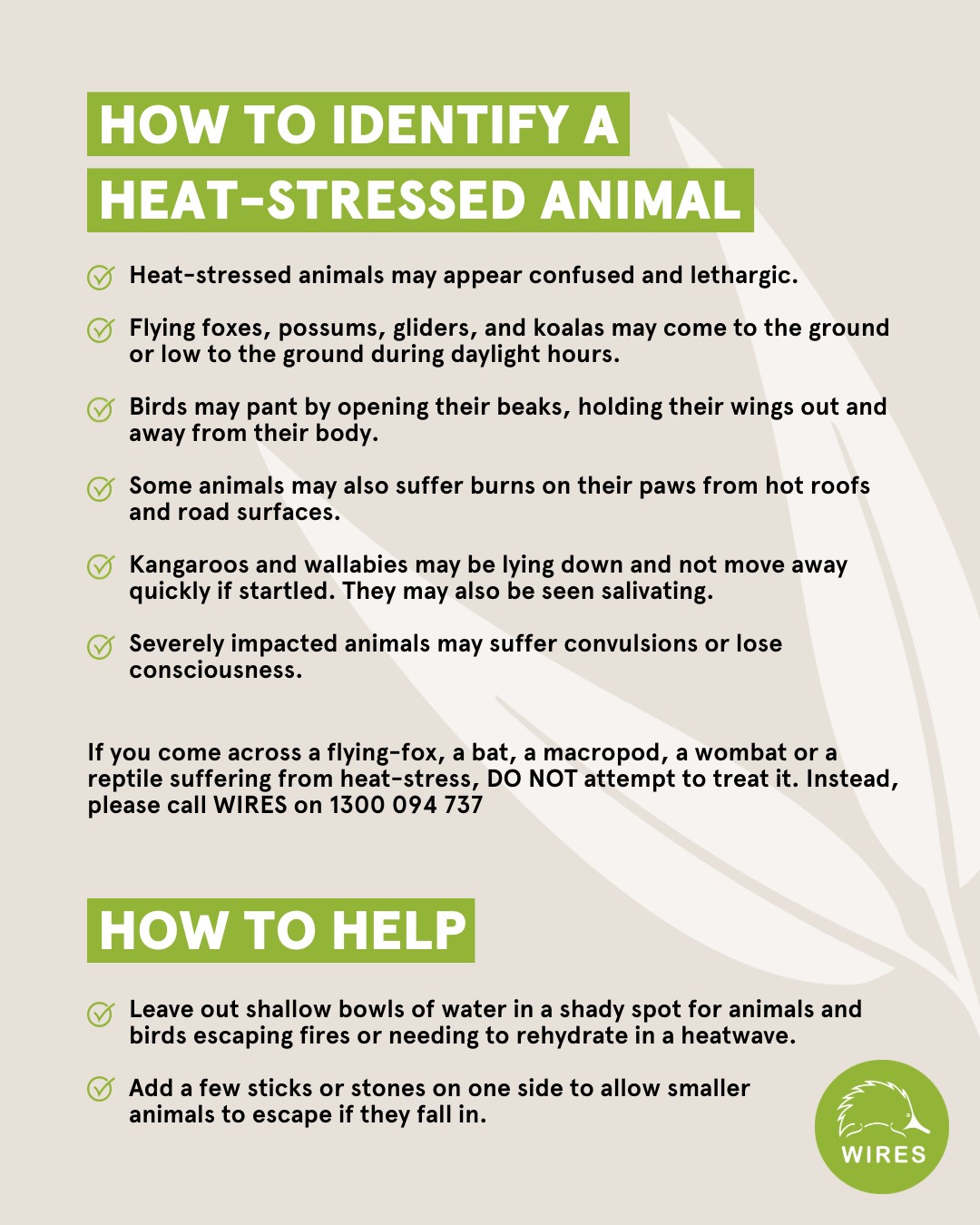
Summer 2023 Snorkelling
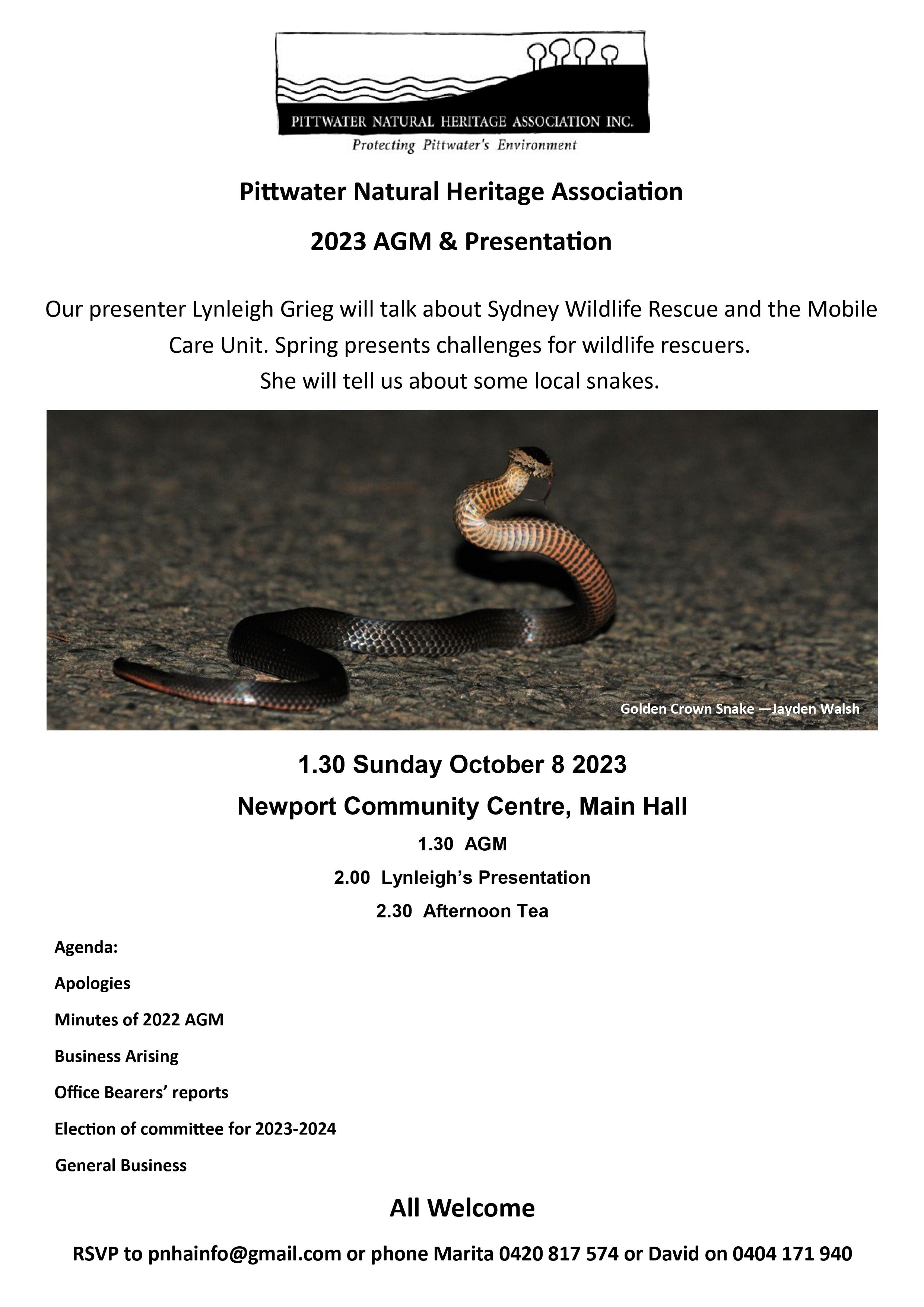
Picnic For Nature
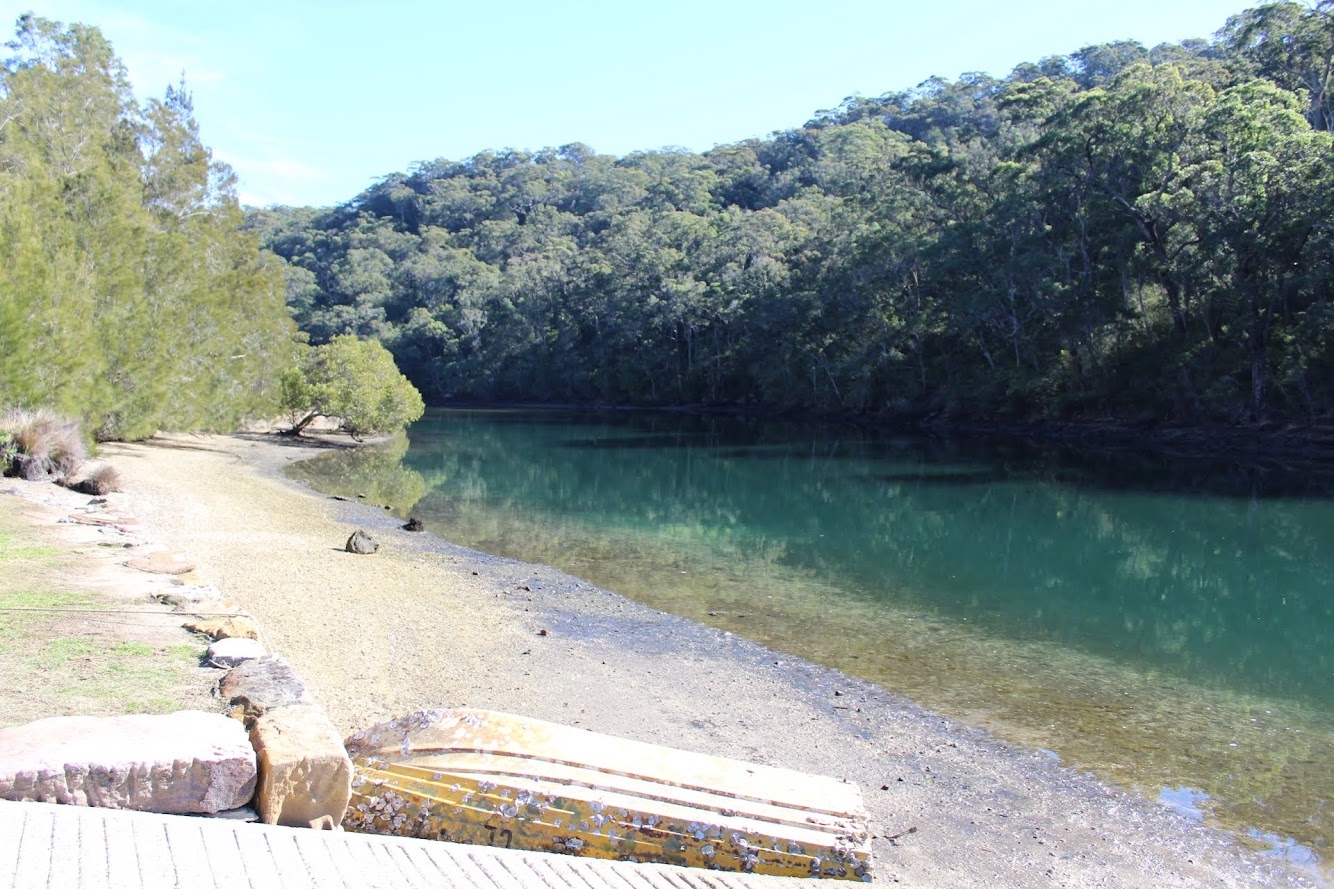
Bushwalk Fundraiser
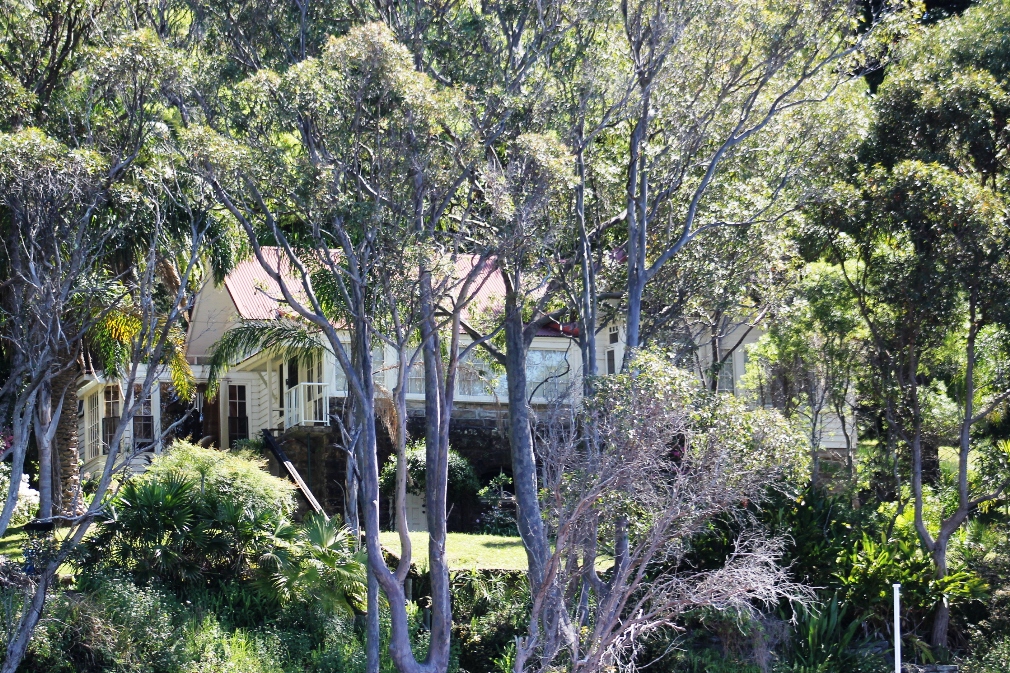
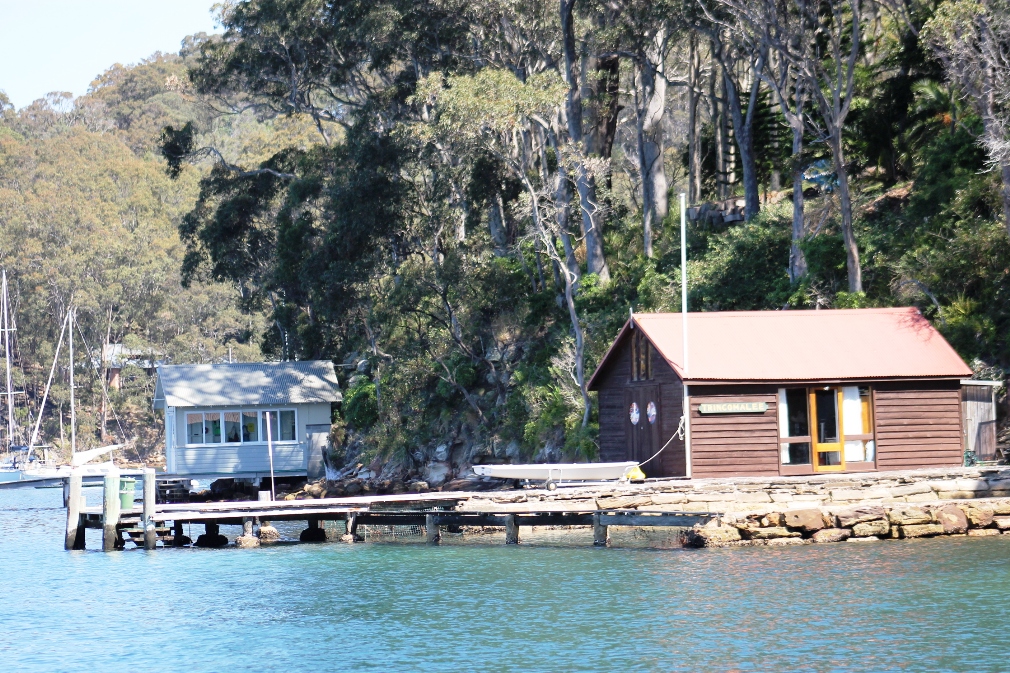
- Friday 10 November
- Friday 8 December
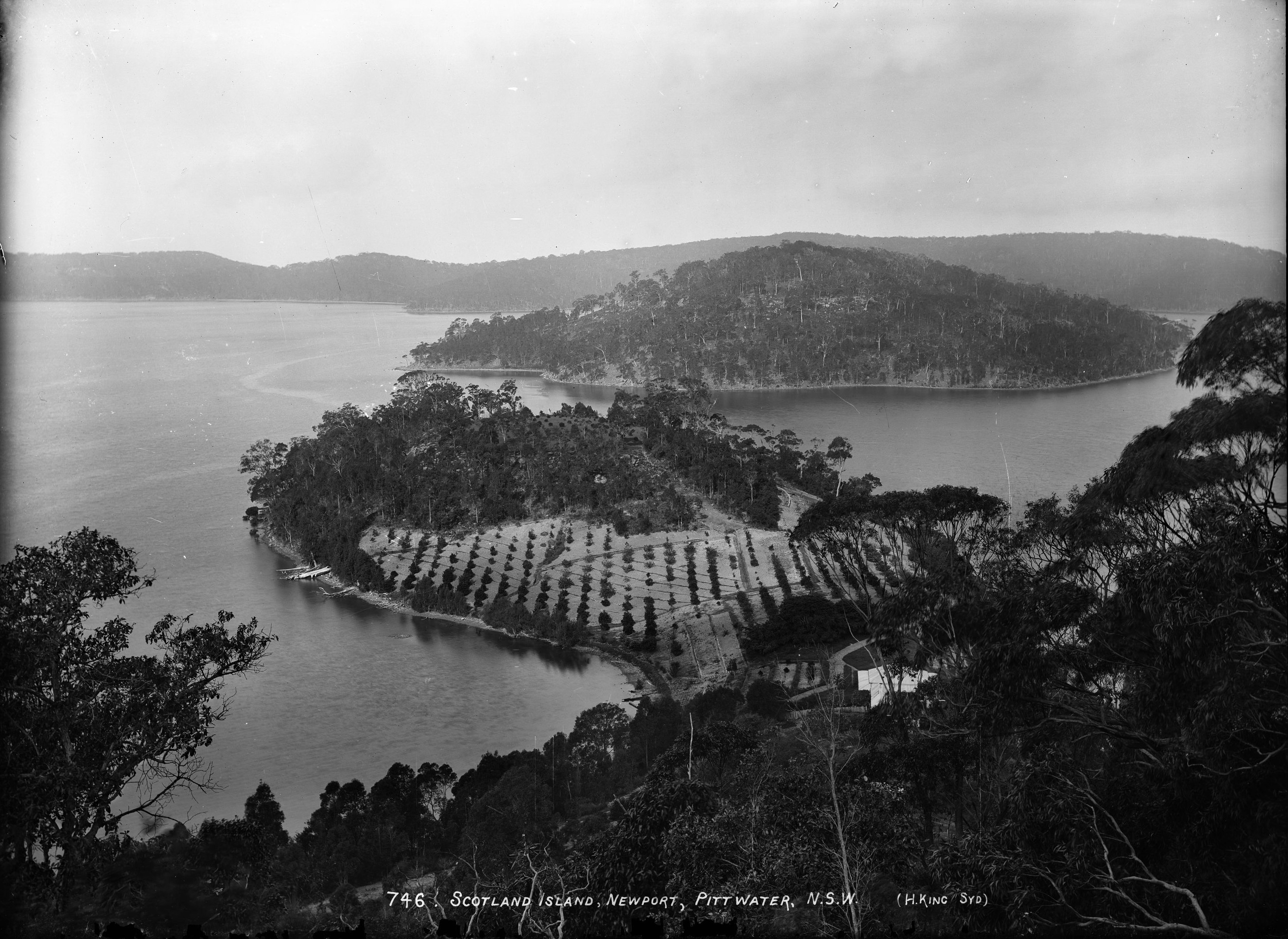
'Scotland Island, Newport, Pittwater, N.S.W.', photo by Henry King, Sydney, Australia, c. 1880-1886. and section from to show cottage on neck of peninsula at western end with no chimneys through roof. From Tyrell Collection, courtesy Powerhouse Museum
𝗞𝗶𝗺𝗯𝗿𝗶𝗸𝗶 𝗥𝗲𝘀𝗼𝘂𝗿𝗰𝗲 𝗥𝗲𝗰𝗼𝘃𝗲𝗿𝘆 𝗖𝗲𝗻𝘁𝗿𝗲 𝗶𝗻𝘃𝗶𝘁𝗲𝘀 𝘁𝗵𝗲 𝗰𝗼𝗺𝗺𝘂𝗻𝗶𝘁𝘆 𝘁𝗼 𝗼𝘂𝗿 𝗢𝗽𝗲𝗻 𝗗𝗮𝘆 𝟮𝟬𝟮𝟯 𝗮𝘁 𝗧𝗵𝗲 𝗛𝗨𝗕 - 𝗞𝗶𝗺𝗯𝗿𝗶𝗸𝗶.
Highlighting the four resident not-for-profit organisations: Peninsula Seniors Toy Recyclers, Bikes4Life, Boomerang Bags Northern Beaches - Kimbriki, Reverse Garbage and their dedicated volunteers.
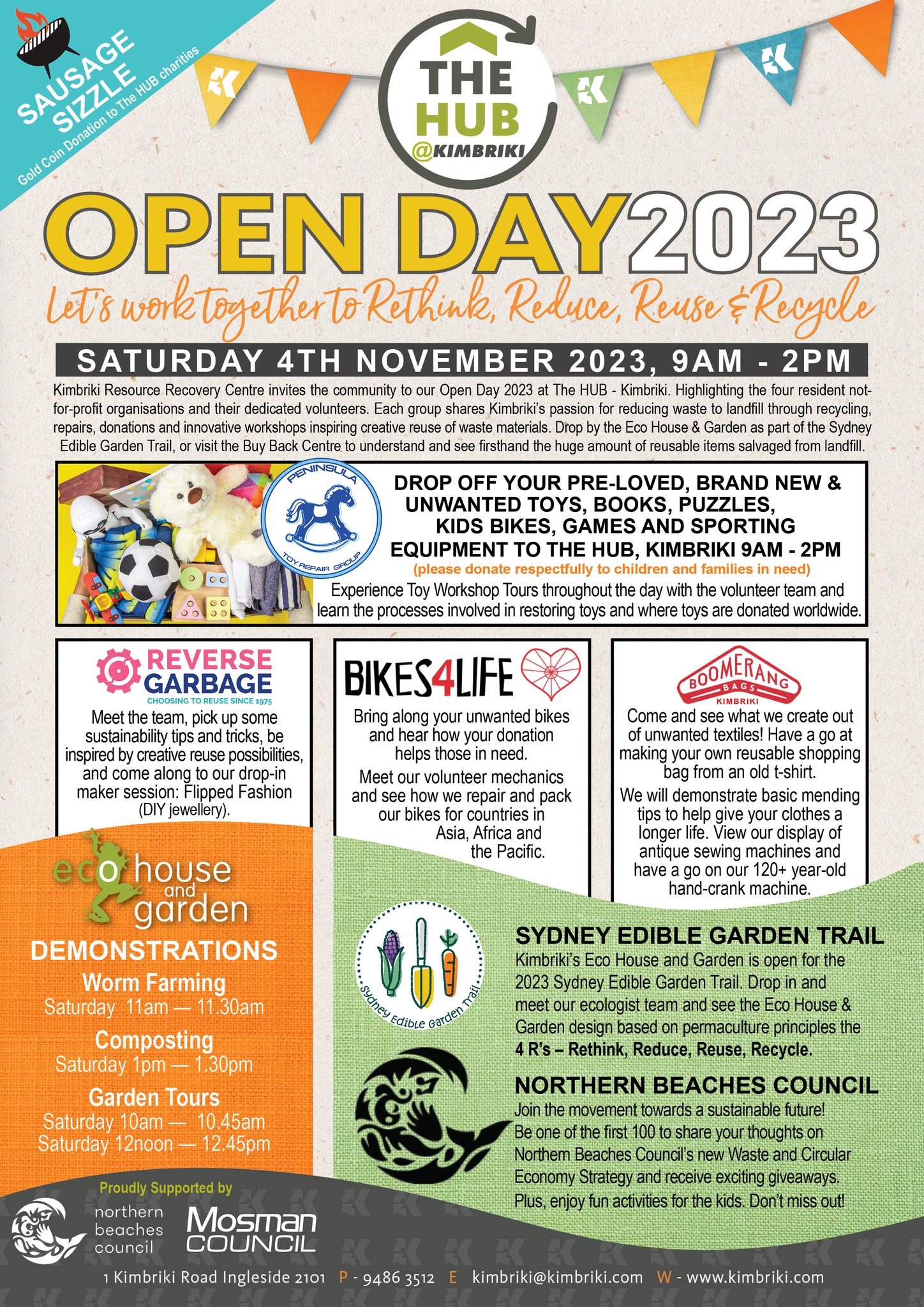
Palmgrove Park Avalon: New Bushcare Group Begins
 Palmgrove Park Avalon is a remnant of the Spotted Gum forest that was once widespread on the lower slopes of the Pittwater peninsula. This bushland’s official name and forest type is Pittwater and Wagstaffe Endangered Ecological Community, endangered because so much has been cleared for suburban development. Canopy trees, smaller trees and shrubs, and ground layer plants make up this community. Though scattered remnant Spotted Gums remain on private land, there is little chance of seedlings surviving in gardens and lawns. More information HERE
Palmgrove Park Avalon is a remnant of the Spotted Gum forest that was once widespread on the lower slopes of the Pittwater peninsula. This bushland’s official name and forest type is Pittwater and Wagstaffe Endangered Ecological Community, endangered because so much has been cleared for suburban development. Canopy trees, smaller trees and shrubs, and ground layer plants make up this community. Though scattered remnant Spotted Gums remain on private land, there is little chance of seedlings surviving in gardens and lawns. More information HERE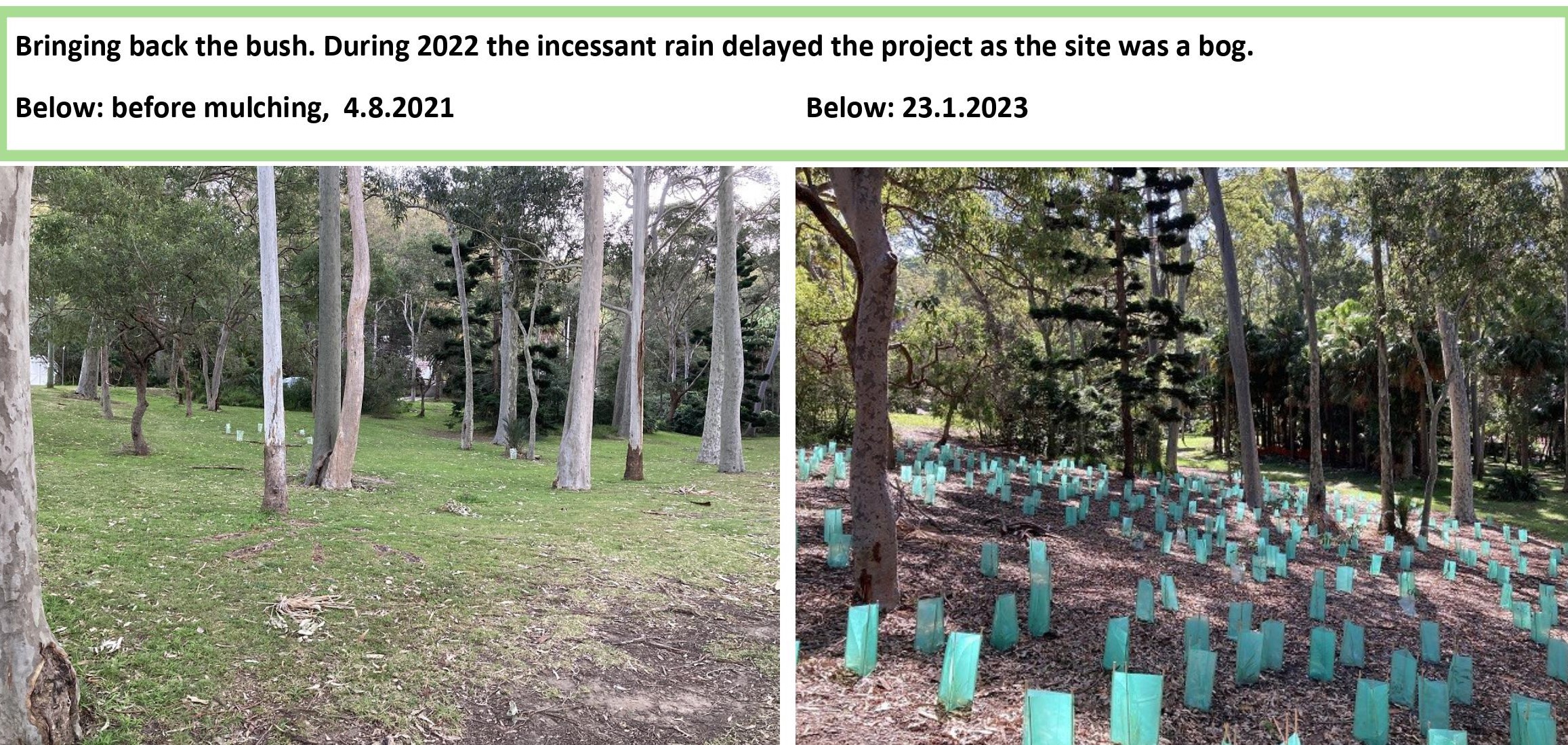
Sydney Wildlife Rescue: Next Rescue And Care Course Commences October 28
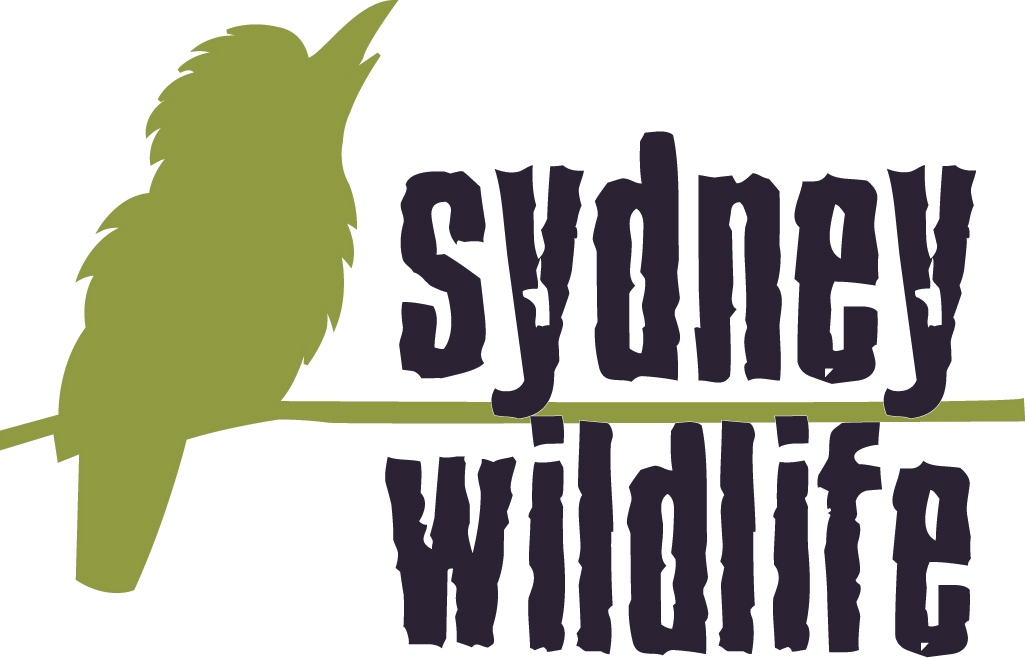
PNHA Guided Nature Walks 2023
Our walks are gentle strolls, enjoying and learning about the bush rather than aiming for destinations. Wear enclosed shoes. We welcome interested children over about 8 years old with carers. All Welcome.
So we know you’re coming please book by emailing: pnhainfo@gmail.com and include your phone number so we can contact you if weather is doubtful.
The whole PNHA 2023 Guided Nature Walks Program is available at: http://pnha.org.au/test-walks-and-talks/
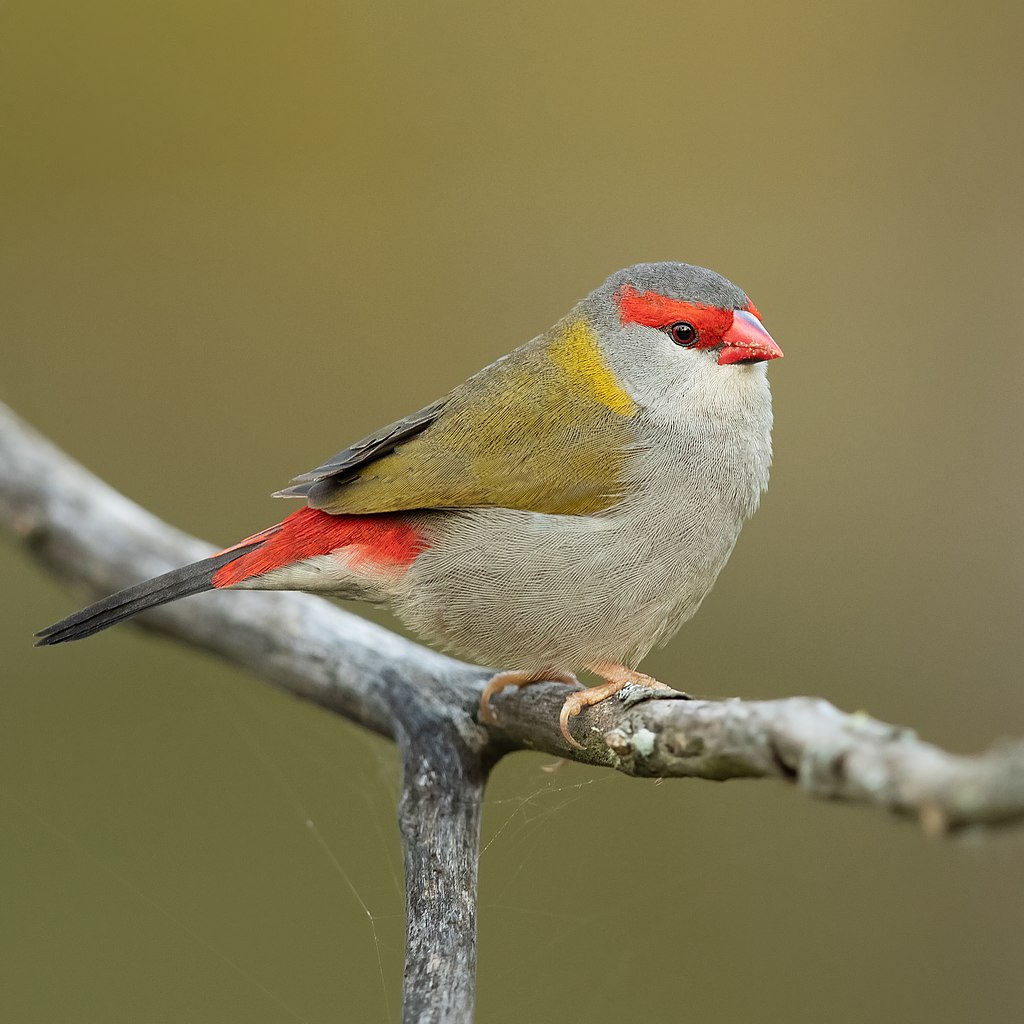
Red-browed finch (Neochmia temporalis). Photo: J J Harrison
Report Fox Sightings
%20(1).jpg?timestamp=1675893929686)
Marine Wildlife Rescue Group On The Central Coast
A new wildlife group was launched on the Central Coast on Saturday, December 10, 2022.
Marine Wildlife Rescue Central Coast (MWRCC) had its official launch at The Entrance Boat Shed at 10am.
The group comprises current and former members of ASTR, ORRCA, Sea Shepherd, Greenpeace, WIRES and Wildlife ARC, as well as vets, academics, and people from all walks of life.
Well known marine wildlife advocate and activist Cathy Gilmore is spearheading the organisation.
“We believe that it is time the Central Coast looked after its own marine wildlife, and not be under the control or directed by groups that aren’t based locally,” Gilmore said.
“We have the local knowledge and are set up to respond and help injured animals more quickly.
“This also means that donations and money fundraised will go directly into helping our local marine creatures, and not get tied up elsewhere in the state.”
The organisation plans to have rehabilitation facilities and rescue kits placed in strategic locations around the region.
MWRCC will also be in touch with Indigenous groups to learn the traditional importance of the local marine environment and its inhabitants.
“We want to work with these groups and share knowledge between us,” Gilmore said.
“This is an opportunity to help save and protect our local marine wildlife, so if you have passion and commitment, then you are more than welcome to join us.”
Marine Wildlife Rescue Central Coast has a Facebook page where you may contact members. Visit: https://www.facebook.com/profile.php?id=100076317431064
- Ph: 0478 439 965
- Email: marinewildlifecc@gmail.com
- Instagram: marinewildliferescuecc

Watch Out - Shorebirds About
.JPG.opt1460x973o0,0s1460x973.jpg?timestamp=1663629195339)
Possums In Your Roof?: Do The Right Thing

Aviaries + Possum Release Sites Needed

Bushcare In Pittwater
Where we work Which day What time
Avalon
Angophora Reserve 3rd Sunday 8:30 - 11:30am
Avalon Dunes 1st Sunday 8:30 - 11:30am
Avalon Golf Course 2nd Wednesday 3 - 5:30pm
Careel Creek 4th Saturday 8:30 - 11:30am
Toongari Reserve 3rd Saturday 9 - 12noon (8 - 11am in summer)
Bangalley Headland 2nd Sunday 9 to 12noon
Bayview
Winnererremy Bay 4th Sunday 9 to 12noon
Bilgola
North Bilgola Beach 3rd Monday 9 - 12noon
Algona Reserve 1st Saturday 9 - 12noon
Plateau Park 1st Friday 8:30 - 11:30am
Church Point
Browns Bay Reserve 1st Tuesday 9 - 12noon
McCarrs Creek Reserve Contact Bushcare Officer To be confirmed
Clareville
Old Wharf Reserve 3rd Saturday 8 - 11am
Elanora
Kundibah Reserve 4th Sunday 8:30 - 11:30am
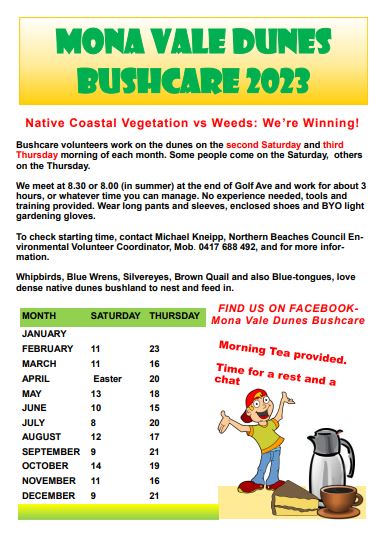 Mona Vale
Mona Vale Mona Vale Beach Basin 1st Saturday 8 - 11am
Mona Vale Dunes 2nd Saturday +3rd Thursday 8:30 - 11:30am
Newport
Bungan Beach 4th Sunday 9 - 12noon
Crescent Reserve 3rd Sunday 9 - 12noon
North Newport Beach 4th Saturday 8:30 - 11:30am
Porter Reserve 2nd Saturday 8 - 11am
North Narrabeen
Irrawong Reserve 2nd Saturday 2 - 5pm
Palm Beach
North Palm Beach Dunes 3rd Saturday 9 - 12noon
Scotland Island
Catherine Park 2nd Sunday 10 - 12:30pm
Elizabeth Park 1st Saturday 9 - 12noon
Pathilda Reserve 3rd Saturday 9 - 12noon
Warriewood
Warriewood Wetlands 1st Sunday 8:30 - 11:30am
Whale Beach
Norma Park 1st Friday 9 - 12noon
Western Foreshores
Coopers Point, Elvina Bay 2nd Sunday 10 - 1pm
Rocky Point, Elvina Bay 1st Monday 9 - 12noon
Friends Of Narrabeen Lagoon Catchment Activities

Gardens And Environment Groups And Organisations In Pittwater
Critically Endangered Swift Parrot Detection Near NSW Boggabri Coal Mine Sites
Ten Big Coal Mines Can Increase Emissions Under Safeguard Mechanism: New Analysis
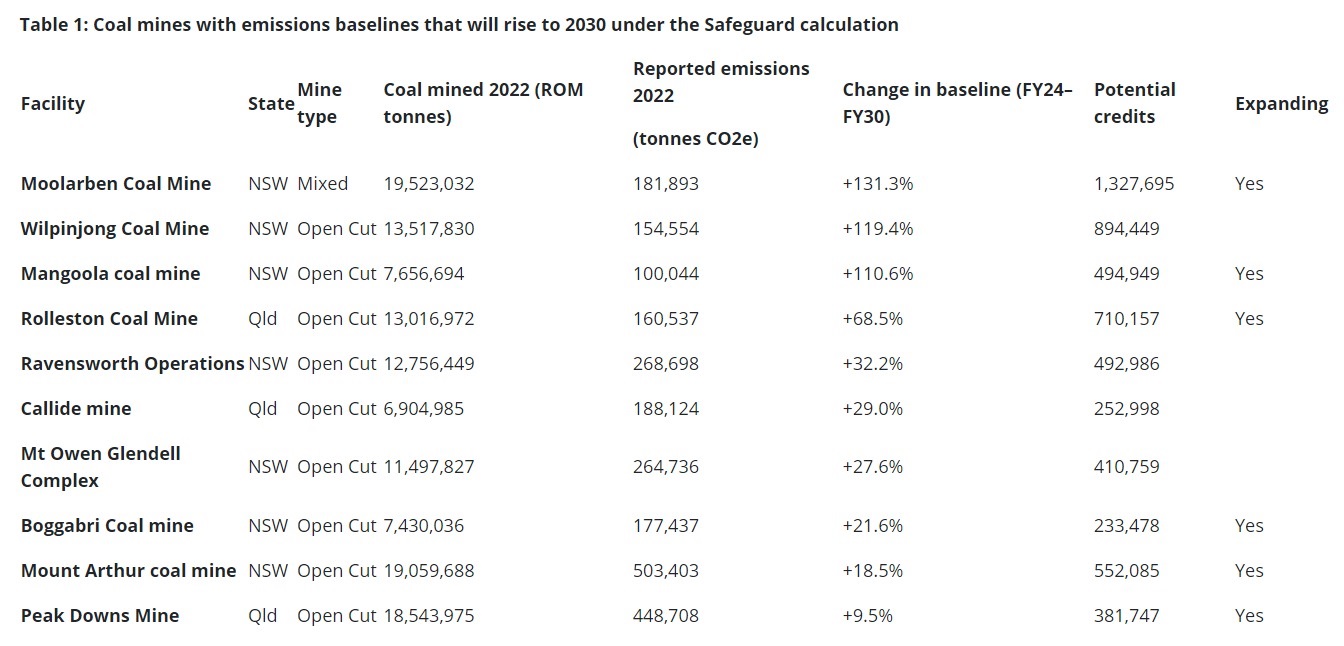
Woodside’s Seismic Blasting Approval Thrown Out After Legal Challenge By Traditional Custodian Intent On Saving The Songlines
''Australia’s reputation among international investors centres on its ability to provide certainty and stability, both of which are important for our global competitiveness and valued long-term relationships with international customers and investors.Important energy projects which are following the rules, consulting in good faith and being granted approvals by the regulator are being impacted because unclear regulations and the application of them are effectively changing the goal posts. The time delays and costs incurred are substantial.More obstacles are being put in the way of critical energy developments, risking the new supply needed to deliver domestic energy security, emissions reductions and substantial economic returns for Australians.Comprehensive and effective consultation with Traditional Owners and landholders has been an important part of the work of Australia’s oil and gas industry going back decades.Regulations which provide clarity and certainty for industry while maintaining consultation obligations are desperately needed.Governments must make clear regulations for consultation that maintain high standards of consultation with stakeholders, including Traditional Owners, but also provide regulatory certainty when an approval is granted.Investors in Australia’s resources sector face increasing approvals uncertainty after today’s court decision, compounding the uncertainty stemming from last year’s decision against a regulatory approval for the Santos Barossa Project.''
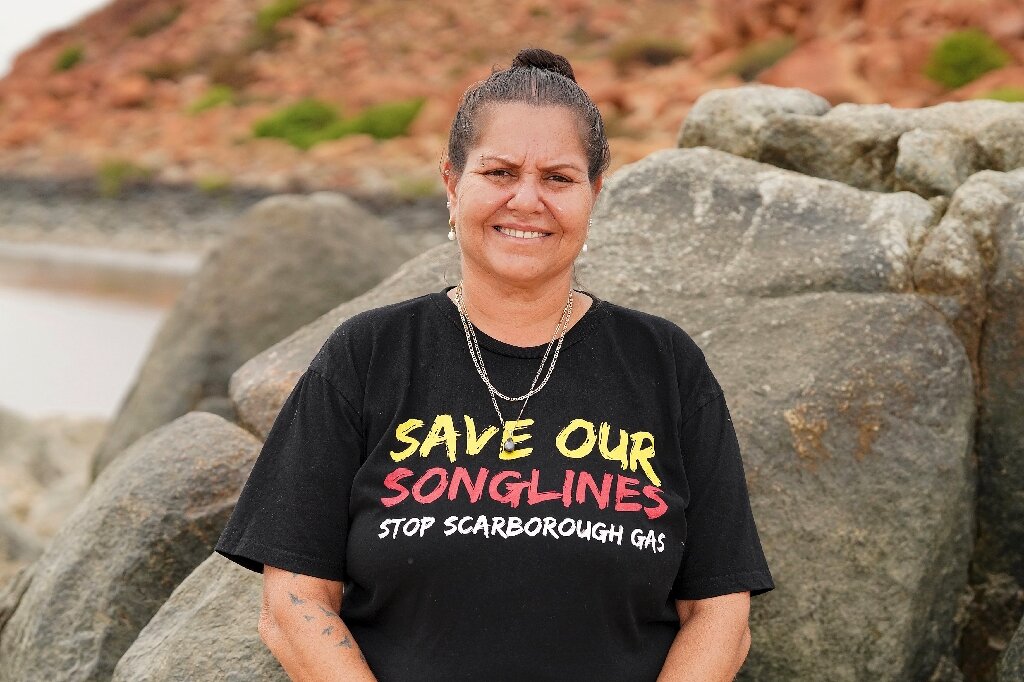
Bass Strait Gas Explorer Aims To Seismic Blast Whale Breeding Grounds-National Parks
Federal Government Urged To Rein In Coal Mine Approvals On BHP’s Caval Ridge Horse Pit
- Mine 15 million tonnes of coal each year until 2055 - 20 years beyond the mine’s current lifespan.
- Leave a 545 hectare coal pit, meaning the majority of disturbed land will not be rehabilitated at all.
- Clear important native vegetation that supports threatened species like the ornamental snake, squatter pigeon, and king bluegrass.
National Industries And Governments Decide To Transition The Varroa Mite Program From Eradication To Management
Australia has officially given up on eradicating the Varroa mite. Now what?
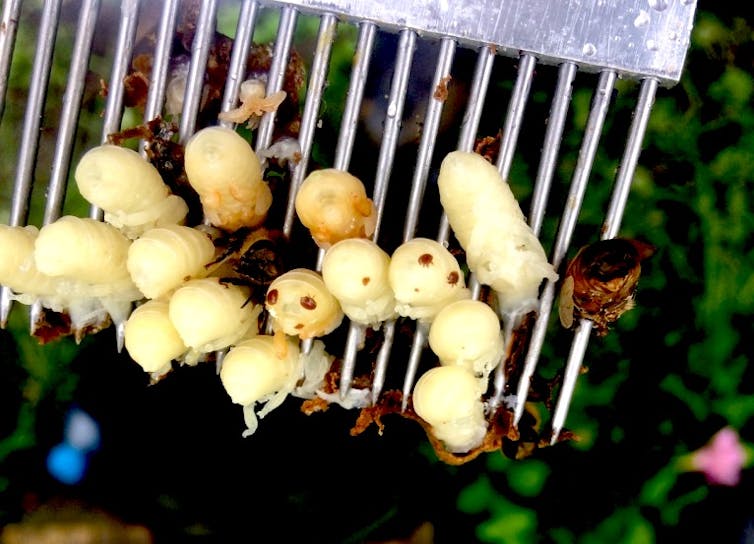
The federal government body in charge of pest control has announced Australia will abandon efforts on eradicating the Varroa mite.
This parasitic mite (Varroa destructor) lives in honey bee colonies, feeding on pupae and adult bees. The mites spread viruses, impair the bees’ ability to fly and communicate, and makes them more susceptible to pesticides, eventually causing a colony collapse if left unmanaged.
Until recently, Australia remained free of Varroa thanks to stringent biosecurity measures. But in June 2022, the mite was detected in the New South Wales coastal area near Newcastle and has continued to spread.
A recent increase in detections over a greater area has now made eradication technically unfeasible. As a result, Australia is transitioning from eradication to management of the Varroa mite.
Can We Fight The Mite?
It has been a tough time for beekeepers, the broader beekeeping community and the growers of crops relying on honey bees for pollination.
Varroa mite is already causing significant economic damage to livelihoods, due to restrictions on hive movements and the euthanasia of around 30,000 bee colonies.
To manage it, we will need to learn from overseas, where people have lived with Varroa for decades. However, Australia also has to develop its own solutions because of our unique climate, biodiversity and agricultural systems.
As seen in other countries, honey production and hive numbers may remain relatively stable. But beekeepers will need to invest significant time and resources to monitor, manage and replace hives due to Varroa losses.
There are effective chemical control options, but these cannot eliminate the mites completely. They also have impacts on bees and can leave residues in hive products. Over-reliance on synthetic chemicals will rapidly lead to resistance in Varroa populations, as seen in almost every country Varroa exists.
Effective organic and non-chemical treatments exist, but they are comparatively labour intensive – an additional burden on certified organic beekeepers.
To keep Varroa mite numbers below economically damaging thresholds, beekeepers will need to use integrated pest management solutions – a combination of approaches to reduce mite populaitons, while following up to ensure these appraoches have been effective.
Beekeeping Will Become More Complex And Expensive
Costs for the average-sized Australian bee business could increase by as much as 30%. Experience in other countries suggests there will be significant declines (up to 50%) of hobbyist and semi-commercial operators. Currently, recreational beekeeping is worth A$173 million in Australia annually.
We also know Varroa will progressively kill around 95% of Australia’s feral honey bees within approximately three years. Therefore, we will likely need more bee colonies per hectare to pollinate some crops effectively.
Cumulatively, increased costs of production, a decrease in the numbers of beekeepers and fewer feral bees will likely result in higher demand for bee hives to service 35 pollination dependent industries across the country. As seen in Aotearoa New Zealand, where the Varroa mite established in 2000, prices for bee hives rented to growers increased by 30–100% per hive within five years..
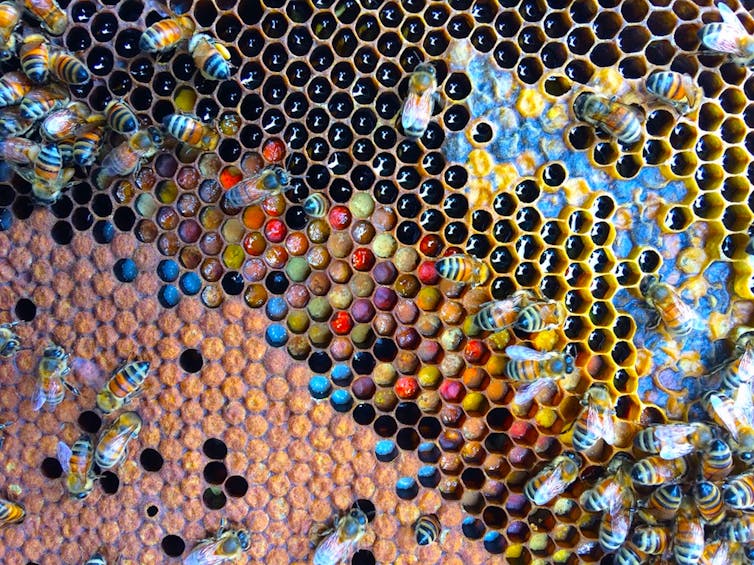
What Should Australia Do To Minimise The Impact?
We need a national program in Australia that monitors colony losses so we can quantify the impacts across the sector. This also holds true for Australian native bees which play an important role in pollination of tropical crops – we do not have the monitoring and baseline data needed to evaluate the changes about to occur.
As an industry that contributes more than $14.2 billion to the economy, we now have a critical need for national capacity building for beekeeping, Varroa and pollination research, development and training.
Western Australia and Tasmania have significant opportunities to remain free from Varroa for as long as possible because the mite is currently only in NSW on the eastern boarder. Restricted movements of honey bees across the Bass Strait and the Nullarbor offer an additional biosecurity buffer.
Australia also remains free from virulent bee viruses, such as the deformed wing virus. Hopefully, the Varroa incursion will lead to strengthened biosecurity for honey bee pests and diseases we do not have in the country yet, like Tropilaelaps mites.
We also need to strengthen compliance with the honey bee biosecurity code of practice and improve monitoring of bee losses, bee viruses and native bees. In the long term, we will need to establish breeding programs for bees with Varroa tolerance, as seen in other countries such as the United States, New Zealand and Hawaii.![]()
Cooper Schouten, Project Manager - Bees for Sustainable Livelihoods, Southern Cross University
This article is republished from The Conversation under a Creative Commons license. Read the original article.
6 reasons why global temperatures are spiking right now

The world is very warm right now. We’re not only seeing record temperatures, but the records are being broken by record-wide margins.
Take the preliminary September global-average temperature anomaly of 1.7°C above pre-industrial levels, for example. It’s an incredible 0.5°C above the previous record.
So why is the world so incredibly hot right now? And what does it mean for keeping our Paris Agreement targets?
Here are six contributing factors – with climate change the main reason temperatures are so high.
1. El Niño
One reason for the exceptional heat is we are in a significant El Niño that is still strengthening. During El Niño we see warming of the surface ocean over much of the tropical Pacific. This warming, and the effects of El Niño in other parts of the world, raises global average temperatures by about 0.1 to 0.2°C.
Taking into account the fact we’ve just come out of a triple La Niña, which cools global average temperatures slightly, and the fact this is the first major El Niño in eight years, it’s not too surprising we’re seeing unusually high temperatures at the moment.
Still, El Niño alone isn’t enough to explain the crazily high temperatures the world is experiencing.
2. Falling Pollution
Air pollution from human activities cools the planet and has offset some of the warming caused by humanity’s greenhouse gas emissions. There have been efforts to reduce this pollution – since 2020 there has been an international agreement to reduce sulphur dioxide emissions from the global shipping industry.
It has been speculated this cleaner air has contributed to the recent heat, particularly over the record-warm north Atlantic and Pacific regions with high shipping traffic.
It’s likely this is contributing to the extreme high global temperatures – but only on the order of hundredths of a degree. Recent analysis suggests the effect of the 2020 shipping agreement is about an extra 0.05°C warming by 2050.

3. Increasing Solar Activity
While falling pollution levels mean more of the Sun’s energy reaches Earth’s surface, the amount of the energy the Sun emits is itself variable. There are different solar cycles, but an 11-year cycle is the most relevant one to today’s climate.
The Sun is becoming more active from a minimum in late 2019. This is also contributing a small amount to the spike in global temperatures. Overall, increasing solar activity is contributing only hundredths of a degree at most to the recent global heat.
4. Water Vapour From Hunga Tonga Eruption
On January 15 2022 the underwater Hunga Tonga–Hunga Haʻapai volcano erupted in the South Pacific Ocean, sending large amounts of water vapour high up into the upper atmosphere. Water vapour is a greenhouse gas, so increasing its concentration in the atmosphere in this way does intensify the greenhouse effect.
Even though the eruption happened almost two years ago, it’s still having a small warming effect on the planet. However, as with the reduced pollution and increasing solar activity, we’re talking about hundredths of a degree.
5. Bad Luck
We see variability in global temperatures from one year to the next even without factors like El Niño or major changes in pollution. Part of the reason this September was so extreme was likely due to weather systems being in the right place to heat the land surface.
When we have persistent high-pressure systems over land regions, as seen recently over places like western Europe and Australia, we see local temperatures rise and the conditions for unseasonable heat.
As water requires more energy to warm and the ocean moves around, we don’t see the same quick response in temperatures over the seas when we have high-pressure systems.
The positioning of weather systems warming up many land areas coupled with persistent ocean heat is likely a contributor to the global-average heat too.
6. Climate Change
By far the biggest contributor to the overall +1.7°C global temperature anomaly is human-caused climate change. Overall, humanity’s effect on the climate has been a global warming of about 1.2°C.
The record-high rate of greenhouse gas emissions means we should expect global warming to accelerate too.
While humanity’s greenhouse gas emissions explain the trend seen in September temperatures over many decades, they don’t really explain the big difference from last September (when the greenhouse effect was almost as strong as it is today) and September 2023.
Much of the difference between this year and last comes back to the switch from La Niña to El Niño, and the right weather systems in the right place at the right time.
The Upshot: We Need To Accelerate Climate Action
September 2023 shows that with a combination of climate change and other factors aligning we can see alarmingly high temperatures.
These anomalies may appear to be above the 1.5°C global warming level referred to in the Paris Agreement, but that’s about keeping long-term global warming to low levels and not individual months of heat.
But we are seeing the effects of climate change unfolding more and more clearly.
The most vulnerable are suffering the biggest impacts as wealthier nations continue to emit the largest proportion of greenhouse gases. Humanity must accelerate the path to net zero to prevent more record-shattering global temperatures and damaging extreme events.![]()
Andrew King, Senior Lecturer in Climate Science, The University of Melbourne
This article is republished from The Conversation under a Creative Commons license. Read the original article.
Net zero by 2050? Too late. Australia must aim for 2035
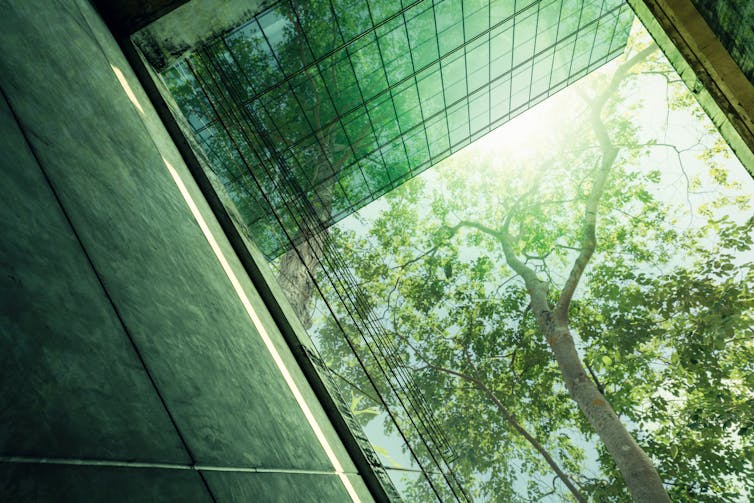
This year’s heightened drumbeat of extreme weather shows us how little time we actually have to slash emissions.
It is now clear that going slow on cutting greenhouse gas emissions is much more expensive than taking action. At this week’s climate ambition summit, United Nations secretary general António Guterres warned the world is “decades behind” in the transition to clean energy.
The UN’s new Global Stocktake makes clear we need to accelerate the race to net zero.
It’s time to act as quickly as humanly possible. This week, Australia’s leading engineers and technology experts from the Australian Academy of Technological Sciences and Engineering have called for Australia to get to net zero 15 years quicker than our current goal of 2050 to be more consistent with a 1.5℃ trajectory.
It will be hard. But ask yourself – what is the alternative?
To shake us out of business as usual, we have to fast-track regulatory change, upskill the workforce, future-proof national infrastructure, embed a zero-waste approach to supply chains and massively boost business investment. Here’s how.
The Net Zero Grid
Per capita, Australia is the world leader in solar and wind generation. But we’ll need more as we electrify the entire economy, which will triple demand.
To get there means investing in distribution, transmission, battery and pumped hydro storage and grid integration. All of this has to be fast-tracked through closer engagement with communities and streamlined regulations.
Electrifying our export industries is vital for both Australia’s and the world’s net zero efforts. This would make full use of our advantages in cheap power from renewables such as by making green hydrogen, which can help with green chemical and green metals manufacturing.
Pulling carbon dioxide back out of the air is another potential “export” industry. Direct air capture will be needed to bring levels in the atmosphere back down, and Australia could use cheap renewable energy to do it, and sell the credits to offset hard-to-abate areas such as plane flights.

Embrace The Circular Economy
Supply chains of products and raw materials put out emissions at every step along the way. Some emissions are from activities in Australia, others overseas. But all end up in the atmosphere.
Fixing this means slashing waste and removing emissions at every stage of production, from raw materials to recycling. Our food systems produce an estimated 29% of global emissions but around 30–40% of food is wasted.
But it’s more than that. The end goal must be embracing a circular economy, where overconsumption is phased out and waste becomes the feedstock for new products. We can greatly accelerate our efforts by working with European authorities, given they are far ahead of Australia here.
Make Our Buildings Run Cleaner
Emissions from our buildings come largely from electricity and gas use, with embodied emissions from, say, the use of concrete in construction a smaller concern. Here, the low-hanging fruit is moving to zero-emissions electricity and switching from gas to electricity.
Banning new household connections to the gas network as Victoria and the ACT are doing, is another opportunity.
When gas heaters reach their end of life, we can require they be replaced by electric heaters. This won’t significantly increase the grid demand if high efficiency heat pumps are used.
And we should boost efficiency standards still further for new buildings and major renovations. Australia’s new National Construction Code will help, but more can be done.
In the longer term, cement made without emissions and new construction methods will help further cut emissions.
Electrify Transport
After a slow start, electric cars are finally gaining popularity in Australia. Now we’re seeing electric utes and trucks. Electric buses are already on the roads in some states. This is essential. Now it’s time to speed it up.
We need all states and territories on board to plan for a phase-out of internal combustion engines, coupled with better investment in public and private charging infrastructure.
Electrifying transport will give us enormous battery packs in our driveways – often several times the capacity of a home battery. New technologies such as vehicle-to-grid will let us use our cars as grid backup and give households security if there’s a blackout.
Shipping giants are working on the challenge of cleaning up emissions, while work is being done on electric planes. These are harder nuts to crack, but already there are electric ferries up and running in Europe and short-trip electric planes on sale in Australia.

Farming And Mining
Some farms are already running on solar and storage for cost and energy security reasons. But there’s more to do, such as slashing emissions of the potent greenuouse gas nitrous oxide from fertilisers using nitrification inhibitors.
In mining, some operators are rapidly cleaning up their operations – and often for cost reasons. Running a mine site on diesel is expensive. We need to accelerate the shift here towards powering grinding machines, excavators and ore trains with renewables.
Some problems don’t yet have off-the-shelf solutions, such as reducing methane from livestock or producing steel cost-effectively without using coal.
These hard-to-cut sources of emissions will need significant and sustained investment to produce practical and cost-effective technologies solving the problems.
Technology – And Talking
Swapping fossil fuels for clean technologies will take talking as well as technology. Many of us find change confronting, especially at this pace.
So we need to do this right, sharing economic benefits and preserving the social fabric of communities and avoiding damaging nature. The debate over new transmission lines is a case in point.
We’ll need an honest national conversation – and one that isn’t limited to expert, government and industry circles.
We have new institutions to help us move faster, such as the Net Zero Authority, the new mandates for the Climate Change Authority, and the sector-level net zero plans in progress.
Now we need to get on and do it. Yes, it’s faster than we thought possible. But fast is now necessary.![]()
Mark Howden, Director, ANU Institute for Climate, Energy and Disaster Solutions, Australian National University; Frank Jotzo, Professor, Crawford School of Public Policy and Head of Energy, Institute for Climate Energy and Disaster Solutions, Australian National University; Ken Baldwin, Inaugural Director, ANU Grand Challenge, Zero-Carbon Energy for the Asia Pacific, Australian National University; Kylie Catchpole, Associate Professor of Solar Engineering, Australian National University; Kylie Walker, Visiting Fellow, Australian National University, and Lachlan Blackhall, Entrepreneurial Fellow and Head, Battery Storage and Grid Integration Program, Australian National University
This article is republished from The Conversation under a Creative Commons license. Read the original article.
Emperor penguins face a bleak future – but some colonies will do better than others in diverse sea-ice conditions

The long-term future looks bleak for Emperor penguins, but our new research shows some birds may be able to survive in certain conditions, depending on where they live, at least for the next few decades.
Over the past two years, Antarctic sea ice has declined dramatically, prompting scientists to suggest it could reach a “new state”.
A study based on satellite images shows that sea ice broke out early in Antarctica’s Bellingshausen Sea in 2022, potentially resulting in breeding failures across several Emperor penguin colonies in that region.
Our research shows Emperors form colonies in surprisingly diverse environmental conditions that vary depending on location around the continent. Within each of these regions, there is little difference between where birds make their homes and other sites, suggesting they could shift if they had to. This provides a ray of hope in an otherwise bleak outlook.
Emperor penguins may be the only birds to rarely set foot on land. They are unique among penguin species in that they breed on sea ice during the harsh Antarctic winter.
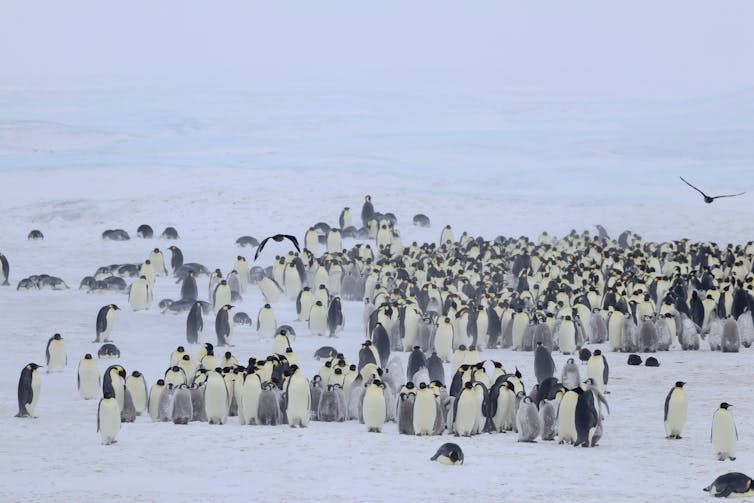
We know that they need “fast ice” – the coastal sea ice attached to the Antarctic continent or ice shelves. But they actually inhabit a range of fast-ice locations that differ in the timing of ice formation, how much ice forms and breaks, and even how close they get to other penguin species.
Depending on where they are along the Antarctic coast, Emperors make use of the habitat available to them. Their behaviour may be flexible enough to allow some colonies to cope better in a warming world.
Why Fast Ice Is Important
Emperor penguins rely on fast ice as a stable platform for their breeding season. Female Emperors lay their eggs and the males incubate them for about two and a half months.
Even though Antarctica’s sea ice is diminishing, this refers to a measure known as “sea ice extent”, which includes all sea ice covering the polar ocean, whether it is fast ice or drifting pack ice.
A decrease in sea ice extent is not necessary linearly linked to a drop in the area covered by fast ice (although the reverse is true).
If fast ice were to disappear, we would expect more than 90% of Emperor colonies to become functionally extinct by the end of the century. However, our study suggests that in the short to medium term, we should consider the differences in the penguins’ breeding habitats when we think about ways to protect them.
Emperors Are Unlikely To Move Far
By looking a little closer at different fast-ice habitats, we found Emperor penguins have certain preferences. The persistence of the ice (how long it lasts into the summer) was important because chicks had more time to develop their water-proof swimming feathers.
In some cases, being close to Adélie penguins made a difference. In other cases, Emperors preferred sites with shallow ocean depths below the colony.
Our results suggest that two of these habitat conditions support larger colonies: stable fast ice that lasts throughout the breeding season (with only small changes in the growth and retreat seasonal cycle) and a good balance between a fast-ice platform that is wide enough to raise chicks but close enough to the ocean to get food for them.
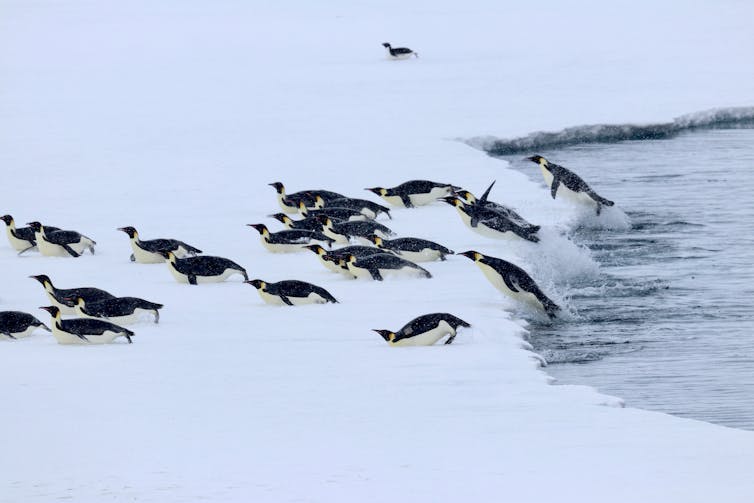
We need further studies to clarify these links and the relationship between population size and habitat quality. In our study, we weren’t able to consider prey availability and there may be other factors that play an important role.
Previous research has already shown that Emperor penguins have limited capacity to disperse to find more suitable climate refuges. This is supported by the genetic partitioning among the penguin populations in different Antarctic regions we studied.
It is therefore unlikely Emperors would move far to avoid more severe climate impacts, even if “better” habitats existed and could host larger colonies.
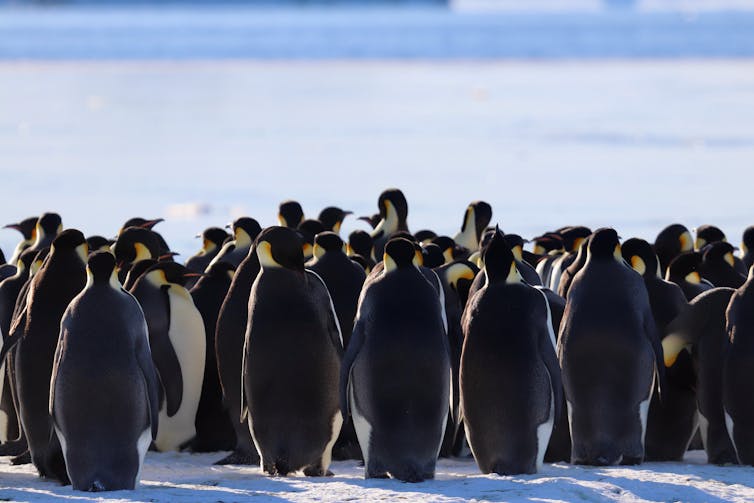
Protecting Penguin Habitat
Climate change is currently one of the main pressures driving Emperor penguins closer to extinction.
However, the latest global assessment by the Intergovernmental Science-Policy Platform on Biodiversity and Ecosystem Services (IPBES) clearly identified fishing activities as historic and current drivers of the erosion of marine biodiversity worldwide.
This is also true for Antarctica. While fishing pressure there is limited to a fraction of the global fishing fleet, some of the largest vessels target krill, a tiny shrimp-like crustacean consumed by many Antarctic predators, including Emperor penguins.
With climate models predicting further reductions in sea ice extent, new fishing grounds could open and amplify pressure on other Antarctic wildlife.
If we want to live in a world with Emperor penguins, the most important thing to do would be to cut greenhouse gas emissions steeply. Another key action could be to prevent fishing in areas where climate change will have the most impact.
In this respect, truly protected areas are one conservation tool at our disposal. Now that our research provides more detailed information about penguin habitats, we can begin the process of more careful planning for conservation.
The world’s largest marine protected area exists in the Ross Sea, which is home to about 25% of the world’s Emperor penguins. Lessons we learn from protection there could help mitigate future declines of Emperors around Antarctica.![]()
Sara Labrousse, Chercheuse en écologie polaire, Sorbonne Université and Michelle LaRue, Associate Professor in Conservation Biology, University of Canterbury
This article is republished from The Conversation under a Creative Commons license. Read the original article.
As Antarctic sea ice continues its dramatic decline, we need more measurements and much better models to predict its future
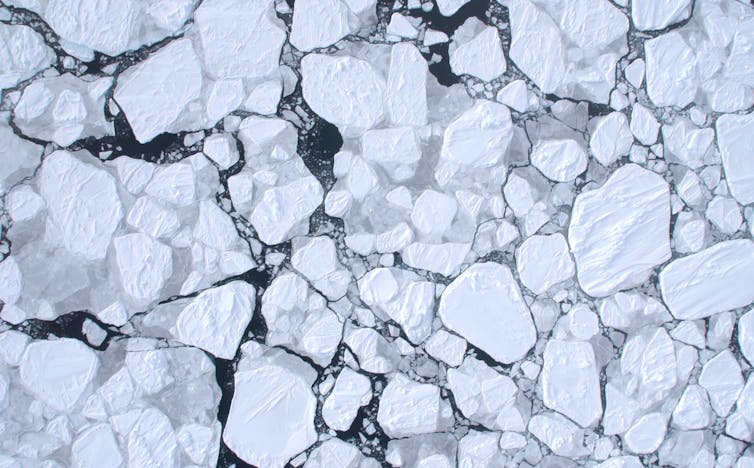
After two seasons of record-breaking lows, Antarctica’s sea ice remains in dramatic decline, tracking well below any winter maximum levels observed since satellite monitoring began during the late 1970s.
A layer of frozen seawater that surrounds the Antarctic continent, sea ice cycles from maximum coverage in September to a minimum in February. The summer minimum has also continued to diminish, with three record low summers in the past seven years.
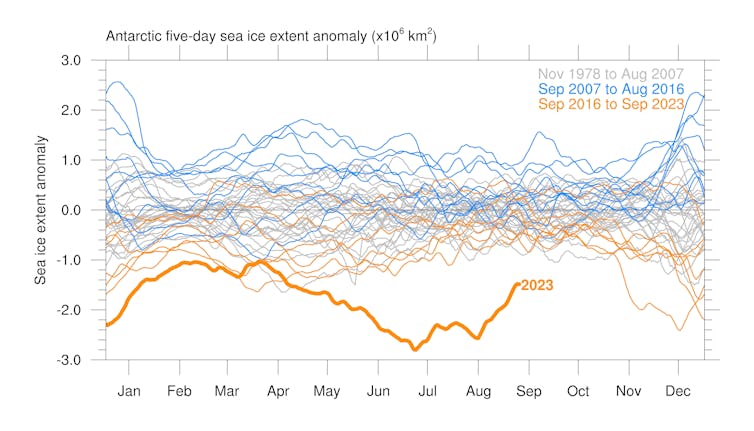
Some scientists have suggested this year could mark a regime shift for Antarctic sea ice. The consequences could be far-reaching for Earth’s climate, because sea ice keeps the planet cooler by reflecting solar energy back into the atmosphere and insulating the ocean. Its formation also generates cold, salty water masses that drive global ocean currents.
The annual freeze-thaw cycle of Antarctic sea ice is one of Earth’s largest seasonal changes, but is a major challenge for climate models to predict accurately.
Since the 1970s, satellites have been tracking a quantity known as “sea ice extent”, which is the total surface area where at least 15% is covered by sea ice.
This September, it reached a satellite-era record low for this time of year. The previous year, after tracking much lower than the median all winter, Antarctic sea ice extent made a late rally and was 18.3 million square kilometres at its maximum by September 2022, around 2% below the 1981-2010 median.
Although 2% might not sound like much, the following summer biologists reported devastating effects on Emperor penguins. No chicks survived in four out of five breeding sites in one region of sea ice loss.
In 2023, Antarctic sea ice extent started the winter even lower than in 2022, and by the end of July was almost 13% below the 1981-2010 median for that time of year. It reached its maximum extent on September 7, at just under 17 million square kilometres, which is nearly 9% below the 1981-2010 median.
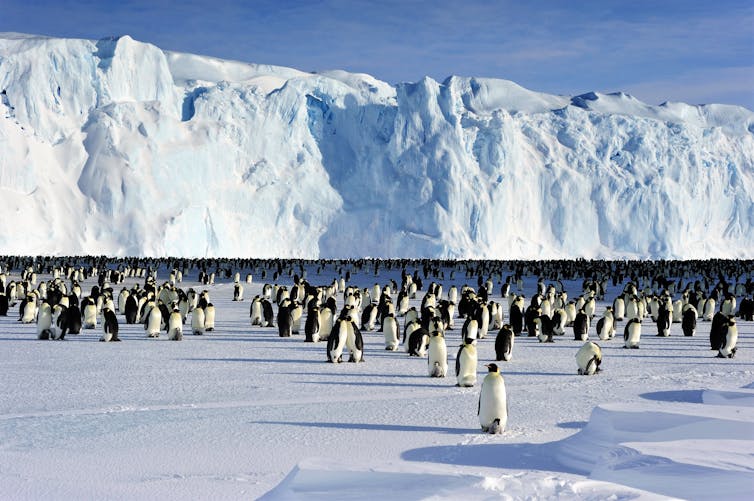
Why We Couldn’t Predict This
Antarctica has bucked the trend of vanishing sea ice observed in the Arctic for decades. Satellite records show a small increasing trend in Antarctic sea ice extent from 2007 to 2016, but this was followed by a decrease since then.
A recent study shows that almost all models in the current collection of simulations used for the latest report by the Intergovernmental Panel on Climate Change (IPCC) failed to reproduce the trend in Antarctic sea ice area observed between 1979 and 2018.
Global climate models predicted that Antarctic sea ice extent should have been diminishing for all of that period, which is at odds with the observations.
These models remain our best tools for forecasting future climate. They have been developed since the 1960s to represent the wide range of physical processes of importance to the climate system as realistically as possible.
They are made up of individual component models for the circulation of the atmosphere and oceans, the transfer of solar energy through the atmosphere, land surface properties and the evolution of sea ice.
While these models have generally done well at forecasting ocean and land surface warming over the past few decades, they have struggled to simulate Antarctic sea ice.
Many research groups around the world have investigated the reasons why models have failed to accurately simulate Antarctic sea ice. Changes in wind and wave patterns, natural variability, stratospheric ozone and melt water from the Antarctic ice sheet entering the Southern Ocean have all been proposed as potential explanations.
So far, none of these have proved to be the definitive answer.
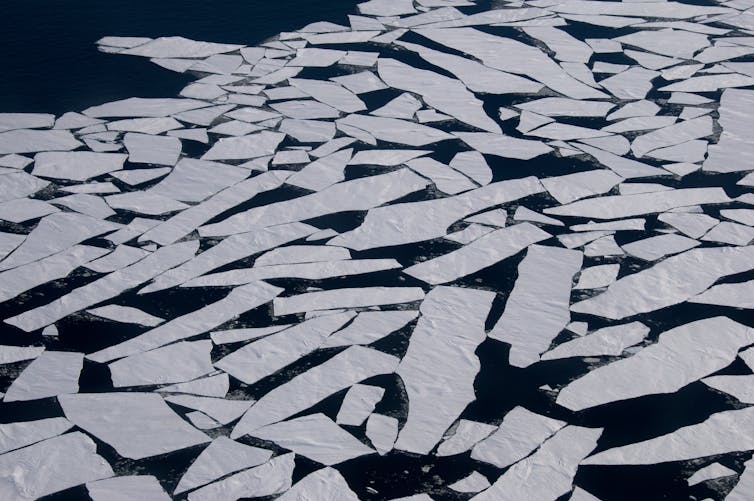
Changes In Sea Ice Thickness
The thickness, or depth, of sea ice cannot be measured directly by satellites because it is thin, salty and hidden below a layer of snow of unknown thickness.
Unlike the Arctic, where we have extensive data from submarines and other sources, information about Antarctic sea ice thickness is very sparse. The data we have mainly come from holes drilled in the sea ice, sea ice monitoring stations, and electromagnetic induction measurements from sleds, helicopters or planes.
The data are mostly from land-fast sea ice, which is the sea ice attached to land or ice shelves.
We have only a few airborne thickness measurements over freely moving pack ice, which makes up most of Antarctic sea ice. We need both sea ice area and thickness to determine sea ice volume, which is important for knowing the overall impact of climate change on sea ice.
Antarctic Storms
McMurdo Sound is a region of the Antarctic coastline in the Ross Sea where both New Zealand (Scott Base) and the USA (McMurdo Station) have Antarctic bases. The sea ice in McMurdo Sound was dramatically thinner than usual in 2022, but not in 2023.
In 2022, multiple storms kept blowing out McMurdo Sound sea ice during winter. Sea ice that would normally be about two metres thick was around 1-1.3 m thick because it was not able to stay in place and grow thicker over the winter season.
Snow was thicker than usual in places, which slowed down the growth of sea ice by insulating it from the cold air above. The weather was not warmer, and the ice had not melted; it had been blown out by strong winds.
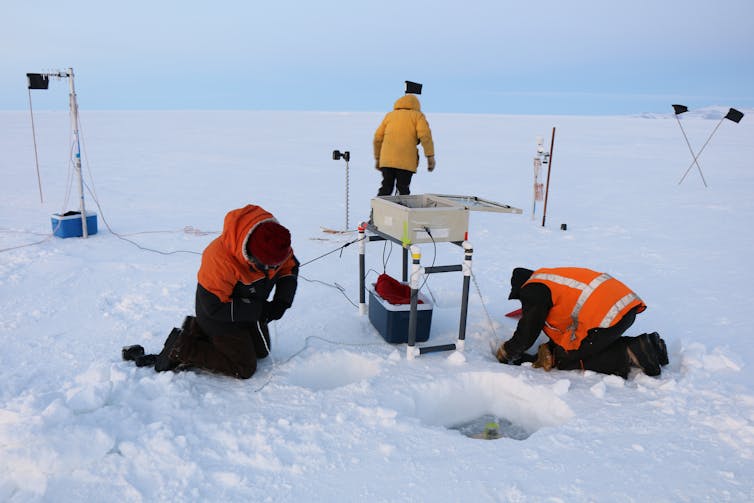
This thinner-than-usual sea ice caused major disruptions in Antarctic operations for New Zealand and other countries in 2022. The University of Otago’s automated sea ice monitoring system is installed each year to measure sea ice thickness, temperature and snow depth. In 2022, Scott Base staff had to take the equipment onto the sea ice on foot for the first time because the sea ice was deemed unsafe to drive vehicles on.
Seeing open water in front of McMurdo Station in the middle of winter in 2022 was shocking for us. However, despite the extremely low winter sea ice extent around most of Antarctica in 2023, sea ice in McMurdo Sound formed in a similar way to most years.
It is not yet clear how much climate change has driven the huge anomalies in Antarctic sea ice extent or thickness, but events like these could be a harbinger of things to come.
To have a chance of predicting these changes, we will need dramatically improved modelling capabilities, more measurements of crucial factors driving sea ice change, and new ways of making those measurements.![]()
Inga Smith, Associate Professor in Physics, University of Otago; Andrew Pauling, Research Fellow in Physics, University of Otago; Greg Leonard, Senior Lecturer in Surveying, University of Otago; Maren Elisabeth Richter, Assistant Research Fellow, University of Otago; Max Thomas, Senior Research Fellow, University of Otago; Pat Langhorne, Professor Emerita in Physics, University of Otago, and Wolfgang Rack, Associate Professor for Remote Sensing and Glaciology, University of Canterbury
This article is republished from The Conversation under a Creative Commons license. Read the original article.
The social lives of kangaroos are more complex than we thought
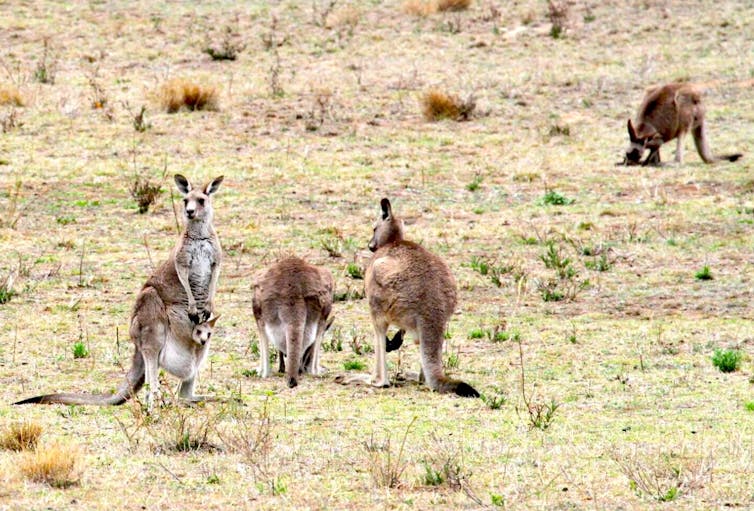
Have you ever wondered what a kangaroo’s social life looks like? Well, kangaroos have stronger bonds to one another than you might think.
Over six years, we monitored a population of around 130 eastern grey kangaroos near Wollar in New South Wales to see how their relationships changed over time. Keeping tabs on individual roos led to some surprising results.
We found that kangaroo mothers become more social when caring for joeys (which is the opposite of what we previously thought). We also uncovered new evidence that indicates kangaroos could potentially form long-term relationships.
This research, published in Animal Behaviour, sheds new light on the behaviour of Australia’s most iconic animal.
How To Watch Kangaroos
Eastern grey kangaroos (Macropus giganteus) are found throughout the eastern third of Australia, and they are extremely social animals.
If you’re lucky enough to have some living near you, you’ll notice they are rarely alone. What you might not notice is how often their small groups (called mobs) fluctuate throughout the day.
Kangaroos have a loose “fission–fusion” social structure, which means mobs often split and reform. Knowing this, we wanted to see just how strong kangaroo relationships actually are, and how these relationships changed over several years.

To find out, we spent a few days each year taking photographs of every single kangaroo in our study population. We then used these photographs (all 3,546 of them!) to individually identify each kangaroo.
The best way to tell kangaroos apart (for humans) is the unique shape of their ears, because both the outline of the ears and the inner ear tufts remain very similar throughout the years. New scars can change the overall ear shape, but we were careful to watch out for those.
Using this method, we identified 130 individual kangaroos. We then looked at which kangaroos appeared next to each other in the same photograph to get an idea of what their social groups looked like.
We also gave each kangaroo a social score based on how many other kangaroos they associated with and how “popular” these associates were.
Suprising Sociability
There are usually a couple of difficulties in this sort of long-term animal study, such as identifying individual animals and being able to follow the same population over several years. These problems are easily avoided with kangaroos, as our photographic survey let us identify animals without invasive tagging, and they tend to return to the same place every day.
We could easily look at the short-term and long-term relationships of each kangaroo, as well as how these relationships varied with sex, age and reproduction.
Looking at sociability on an individual level produced some surprising results.
We discovered some kangaroos were just more social than others. In some this was consistent, and in others it changed from year to year.
In fact, we found female kangaroos tended to be much more social in years when they had joeys. This is quite different from earlier research, which suggested kangaroos actually tend to isolate from the rest of the population when they become mothers.
What we think is happening here is that, while mothers tend to spend time in smaller groups (which is what other studies have shown), those groups change often. As a result, mothers associate with more other kangaroos in total – which would account for their high social scores.
So kangaroos’ loose social structure allows them to adjust their sociability with their reproductive state.
Long-Term Friendships?
However, the fact the social structure is loose doesn’t mean it is simple. We found kangaroo relationships might be far more complex than previously thought.
Some of our kangaroos maintained friendships across multiple years, a phenomenon that was particularly common among females. Kangaroos that were more “popular” – as determined by the social score we calculated – were far more likely to have these friendships.
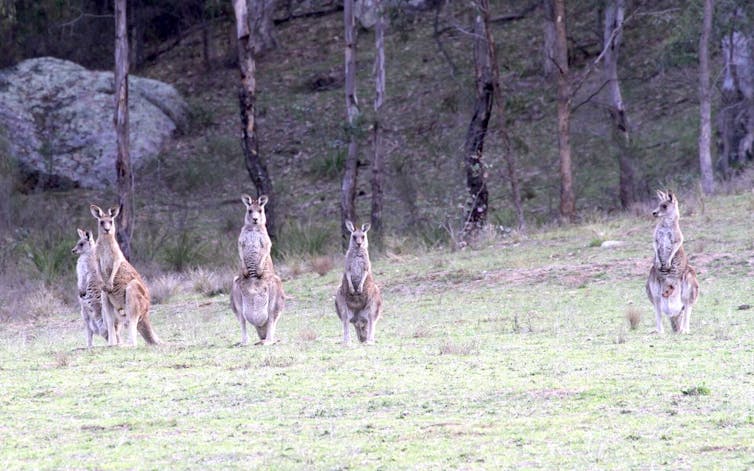
This is the first evidence for long-term relationships in macropods (the animal family that includes kangaroos as well as wallabies, quokkas and others). However, long-term relationships are common in other large, social herbivores such as elephants, giraffes and ibex.
We only looked at the kangaroos for a short time each year. To find out whether they really do form long-term relationships, we will need to do more research. However, we have shown such relationships are a possibility, which is itself a very exciting development in the study of kangaroo behaviour.
The Importance Of Social Organisation
So what’s next? The study of animal behaviour is constantly changing and there’s always lots more we can learn.
We have shown the benefits of looking at animal populations on an individual level, not just a species level. With this in mind, future research should investigate the existence of long-term relationships in kangaroos, as well as why female kangaroos might deliberately increase their sociability when they become mothers.
We often underestimate the importance of social organisation in animals. Further research into kangaroo behaviour can help us better appreciate the intelligence and social complexity of our favourite marsupials.![]()
Nora Campbell, PhD Candidate, UNSW Sydney
This article is republished from The Conversation under a Creative Commons license. Read the original article.
From glowing cats to wombats, fluorescent mammals are much more common than you’d think
Kenny Travouillon, Western Australian Museum; Christine Elizabeth Cooper, Curtin University; Jemmy Bouzin, Curtin University; Linette Umbrello, Queensland University of Technology, and Simon Lewis, Curtin UniversityRecently, several mammals have been reported to “glow” under ultraviolet (UV) light, including our beloved platypus. But no one knew how common it was among mammals until now.
Our research, published in Royal Society Open Science today, found this glow – known as fluorescence – is extremely common. Almost every mammal we studied showed some form of fluorescence.
We also examined the glow to determine if it was really fluorescence and not some other phenomenon. Then, we tested if the fluorescence we observed in museum specimens was natural and not caused by preservation methods.
We also searched for links between the type and degree of fluorescence and the lifestyle of each species, to gain insights on whether there are any benefits to glowing under UV if you’re a mammal.
Nightclub Lights
Nightclub visitors will be familiar with white clothes, or perhaps their gin and tonic, glowing blue under UV light. This is a great example of fluorescence – when the energy from UV light, which is a form of electromagnetic radiation invisible to humans, is absorbed by certain chemicals.
These chemicals then emit visible light, which is lower-energy electromagnetic radiation. In the case of gin and tonic, this is due to the presence of the quinine molecule in the tonic water.
In the case of animals, this can be due to proteins or pigments in their scales, skin or fur. Fluorescence is quite common among animals. It has been reported for birds, reptiles, amphibians, fish, corals, molluscs and most famously scorpions and other arthropods.
However, it has been described less frequently in mammals, although recent studies have provided several examples. We already knew that bones and teeth glow with fluorescence, as do white human hair and nails. Some rodents have a pink glow under UV light and platypuses glow blue-green.

How Often Do Mammals Glow?
Our team came together because we were curious about fluorescence in mammals. We wanted to know if the glow reported recently for various species was really fluorescence, and how widespread this phenomenon was. We obtained preserved and frozen specimens from museums and wildlife parks to study.
We started with the platypus to see if we could replicate the previously reported fluorescence. We photographed preserved and frozen platypus specimens under UV light and observed a fluorescent (although rather faint) glow.
To make sure it was fluorescence and not some other effect that looked like it, we used a technique called fluorescence spectroscopy.
This involved shining various sources of light at the samples and recording the specific “fingerprints” of the resulting glow, known as an emission spectrum. This way, we could confirm what we saw was indeed fluorescence.
We repeated this process for other mammals and found clear evidence of fluorescence in the white fur, spines and even skin and nails of koalas, Tasmanian devils, short-beaked echidnas, southern hairy-nosed wombats, quendas (bandicoots), greater bilbies and even cats.
Both fresh-frozen and chemically treated museum specimens were fluorescent. This meant it wasn’t preservation chemicals such as borax or arsenic causing the fluorescence. So, we concluded this was a real biological phenomenon.
Mammals In Dazzling Lights
Using specimens from the Western Australian Museum’s collection, we took the experiment to the next stage. We recorded every species of mammal that was fluorescent when we exposed the specimens to UV light.
As a result, we found 125 fluorescent species of mammal, representing all known orders. Fluorescence is clearly common and widely distributed among mammals.
In particular, we noticed that white and light-coloured fur is fluorescent, with dark pigmentation preventing fluorescence. For example, a zebra’s white stripes fluoresced while the dark stripes didn’t.
We then used our dataset to test if fluorescence might be more common in nocturnal species. To do this, we correlated the total area of fluorescence with ecological traits such as nocturnality, diet and locomotion.
Nocturnal mammals were indeed more fluorescent, while aquatic species were less fluorescent than those that burrowed, lived in trees, or on land.
Based on our results, we think fluorescence is very common in mammals. In fact, it is likely the default status of hair unless it is heavily pigmented. This doesn’t mean fluorescence has a biological function – it may just be an artefact of the structural properties of unpigmented hair.
However, we suggest florescence may be important for brightening pale-coloured parts of animals that are used as visual signals. This could improve their visibility, especially in poor light – just like the fluorescent optical brighteners that are added to white paper and clothing.![]()
Kenny Travouillon, Curator of Mammals, Western Australian Museum; Christine Elizabeth Cooper, Senior Lecturer, Curtin University; Jemmy Bouzin, PhD candidate, Curtin University; Linette Umbrello, Postdoctoral research associate, Queensland University of Technology, and Simon Lewis, Professor of Forensic and Analytical Chemistry, Curtin University
This article is republished from The Conversation under a Creative Commons license. Read the original article.
Citizen scientists collect more nature data than ever, showing us where common and threatened species live
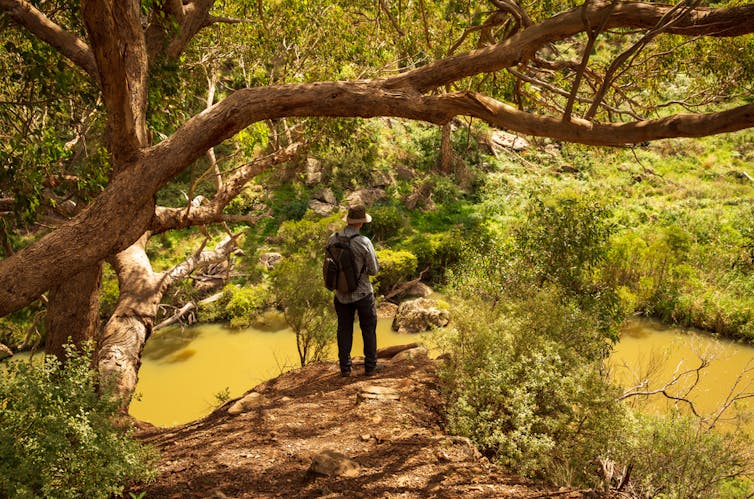
Citizen science isn’t new anymore. For decades, keen amateur naturalists have been gathering data about nature and the environment around them – and sharing it.
But what is new is the rate at which citizen scientists are collecting and sharing useful data. Last year, 10 million observations of species were collected. Our new research shows 9.6 million of those came from citizen scientists. It makes intuitive sense. There are only so many professional researchers. But nearly everyone now has a smartphone.
But if anyone can contribute data, how do you know it’s reliable? Was it really an antechinus, or was it a black rat? Despite the growing success in collecting data, there has long been scepticism over how reliable the data are when used to, say, estimate how abundant a threatened species is.
It turns out, citizen science is extremely useful – especially when paired with professionally collected data.
How Did We Test It?
It’s now much simpler and quicker to be a citizen scientist than it used to be. You might take a photo of an unusual mammal you spot at a campground, record your observations, and upload it to an app or website. This, in turn, has helped standardise the data and make it even more useful. Around Australia, thousands of people contribute regularly through platforms like iNaturalist, DigiVol, 1 Million Turtles, FrogID and Butterflies Australia.
When you upload your observation, it’s recorded in the database of the individual app. But data from all major citizen science apps is also shared with the Atlas of Living Australia, Australia’s largest open-source open-access biodiversity data repository.
That’s important, because it means we can aggregate sightings across every app to get a better sense of what’s happening to a species or ecosystem.
To tackle the question of data reliability, we looked at what proportion of total records added to the data repository came from citizen scientists.
Then we chose three common species – shingleback lizards, Peron’s tree frog, and the red-browed firetail finch – and compared citizen science observations with professionally recorded data across their distribution.
For the shingleback lizard (Tiliqua rugosa), the majority of locations where it was sighted came from professional projects such as government programs and museums, with only 18.5% of locations drawn largely from citizen science.
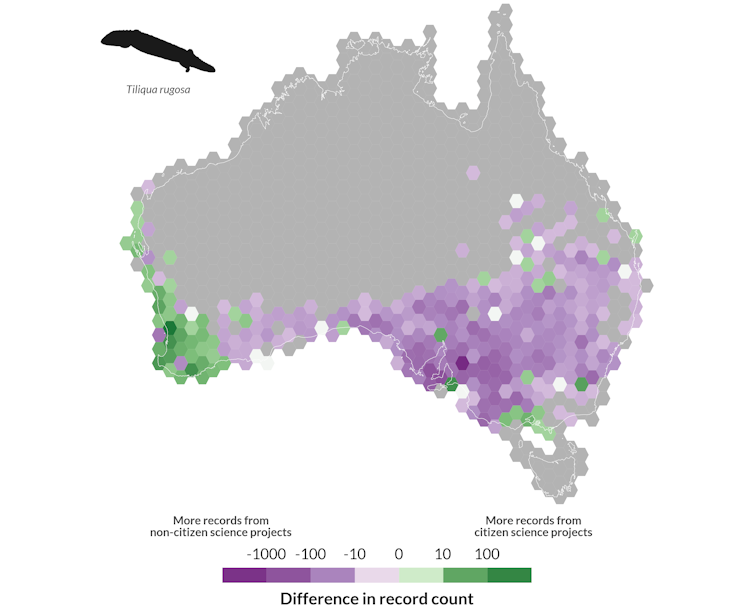
Peron’s tree-frog (Litoria peronii) had 33.5% of its locations mainly contributed by citizen scientists.
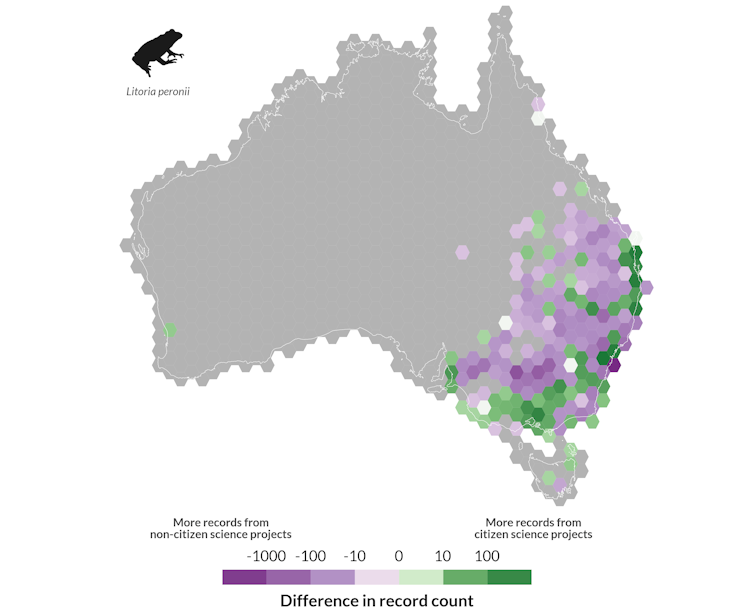
But for the red-browed firetail (Neochmia temporalis), citizen science was the main contributor in over 86.5% of its locations.
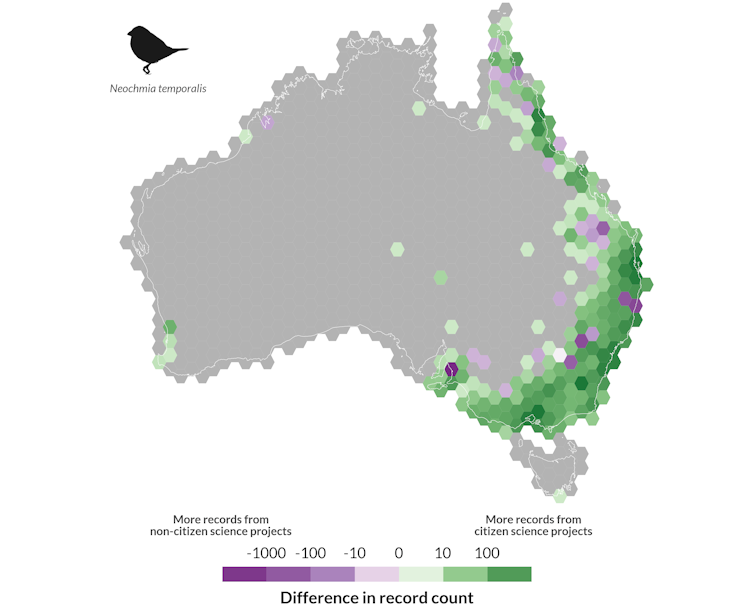
Why the difference? We believe it’s due to the impact of long-running citizen science projects driven by enthusiasts. Birders are a large enthusiast community, while people who go herping (looking for reptiles) are a smaller group.
As a reflection of community enthusiasm, birds make up nearly 50% of all species observation records in the Atlas of Living Australia, with the Australian magpie the most commonly recorded species.
What About Rarely Recorded Species?
Next, we looked at several species with fewer than 1,000 records to find out whether citizen science contributes less data when species are less conspicuous.
In fact, the reverse was often true. For some rare species, citizen science is proving invaluable in ongoing monitoring.
Take the threatened black rockcod (Epinephelus daemelii), a large, territorial fish which been decimated by spearfishing and other pressures.
Here, citizen science proved its worth, adding 63% of observations. Most data came from a few high profile projects, such as annual reef and fish surveys.
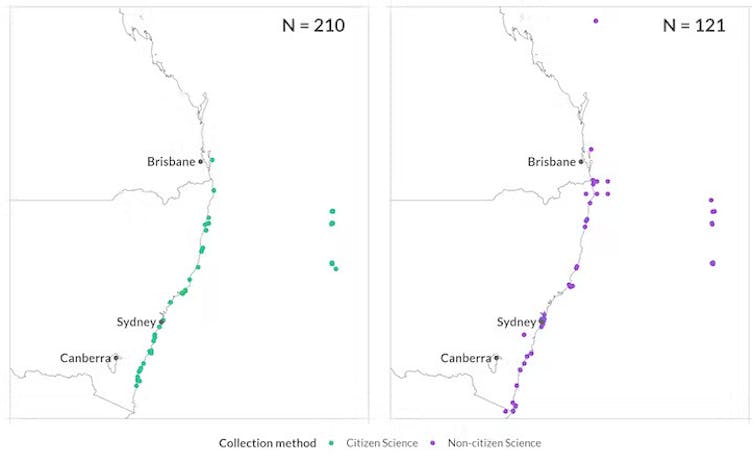
Citizen Science Is Coming Of Age
For decades, citizen science has struggled to feed data into professional monitoring and conservation efforts.
But this is increasingly unfair. By combining citizen science data with professionally collected data, we can get the best of both worlds – a much richer picture of species’ distributions.
It’s only going to get better, as observation and citizen scientist numbers grow each year. There’s a large spectrum of projects, many with excellent data quality controls in place.
Citizen science has come a long way. The data created by keen amateurs is now of better quality, aided by new technologies and support from researchers.
Apps which add automatic time stamps, dates and locations make it much easier to validate observations.
This suggests there’s untapped potential for citizen science to contribute consistent data over significant parts of many species’ ranges, though the strength of this contribution will vary by species.
There’s still more to do to help citizen scientists contribute as usefully as they’d like to. For instance, observations tend to cluster in the regions around cities, because that’s where citizen scientists live. Citizen scientists can also favour larger, charismatic and brightly coloured species.
One method of improving collection could be to focus the interest of citizen scientists on a wider range of species.
For citizen scientists themselves, a big part of the appeal is the ability to create useful data to help the environment. Citizen scientist Jonathon Dashper, for instance, spends his spare time looking for frogs and recording fish. Why? He told us:
My drive to contribute to citizen science is to further my understanding of the natural world and contribute to decision making on environmental matters. Using citizen science platforms, I have been able to learn so much about harder-to-identify organisms.
Erin Roger, Sector Lead, CSIRO; Cameron Slatyer, Project Manager, Atlas of Living Australia, CSIRO, CSIRO, and Dax Kellie, Science Lead | Data Analyst, CSIRO
This article is republished from The Conversation under a Creative Commons license. Read the original article.
Colonists upended Aboriginal farming, growing grain and running sheep on rich yamfields, and cattle on arid grainlands
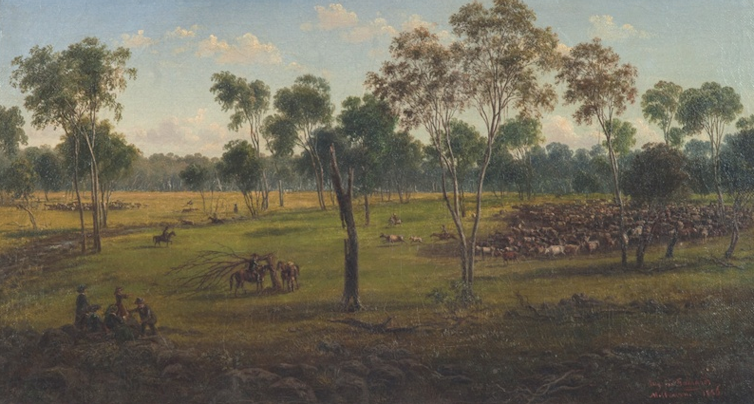
First Nations readers are advised this article contains references to colonial violence against First Nations people.
In 1788 the First Fleet brought two bulls and four cows from the Cape of Good Hope and put them on grass on Bennelong Point, where Sydney Opera House is now. But there wasn’t much grass, and it wasn’t much good, so the cattle took off. Seven years later they were found 65 kilometres southwest, on the Cowpastures near Camden, a flourishing herd. By 1820 they were supporting an abattoir and a couple of tanneries.
The cows had found land that was deliberately made for grazing animals – kangaroos. In small patches and on extensive plains, Dharawal managers had performed cool burns to promote rich grass near water. When the cattle found this grass, they stayed.
It was the start of dispossession. Grazing animals trod on or ate the staple tubers such as murnong, on which local groups relied. These grew in rich beds, but were easily trampled. As colonists moved inland, they took Aboriginal land used for growing grain and ran sheep or cattle on it.
The effects of this upheaval are still with us today.
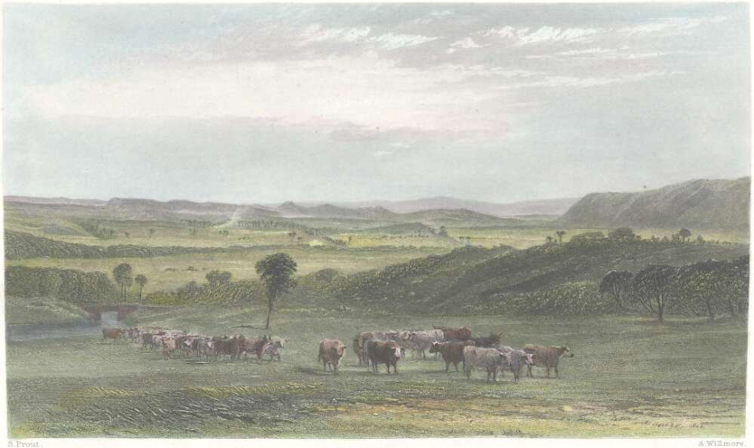
Without Fire, The Trees Took Over
The newcomers who took the Camden country tried to keep it open, without scrub. There, John and Elizabeth Macarthur developed the Australian merino sheep. But they did not understand fire, and the bush got away. As early as 1817, the Macarthurs’ land “had become crowded – choked up in many places by thickets of saplings and large thorn bushes [Bursaria spinosa] and the sweet natural herbage had for the most part been replaced by coarse wiry grasses which grew uncropped”.
In 1848, Thomas Mitchell observed the effects:
The omission of the annual periodical burning by the natives (sic), of the grass and young saplings, has already produced in the open forest lands nearest to Sydney, thick forests of young trees, where, formerly, a man might gallop without impediment, and see whole miles before him. Kangaroos are no longer to be seen there; the grass is choked by underwood.
On good grass, stock fed themselves – they needed only shepherds or stockmen – but European crops grew reluctantly on Sydney sandstone. In 1789, English farmer James Ruse grew corn on better land at Rose Hill near Parramatta, but it still yielded poorly.
In 1794, Ruse sold his block and joined the settlers crowding the rich flats of the Hawkesbury River. Here, he produced the first successful wheat crop.
Soon, corn, English wet wheat and barley were supplying government stores and the Sydney market.
On those Hawkesbury flats, Dharug people had long grown a key staple: tubers. They could not afford to lose the land. They gave some up, but the settlers wanted it all. In 1794, guerilla war broke out. It lasted 22 years – Australia’s longest war – until in 1816 British soldiers finally broke Dharug resistance.
Tubers And Grain
Unlike the newcomers, the Dharug rarely ate grain. They preferred tubers. This was common – wherever it was wet enough, people across Australia relied on tubers, notably warran (Dioscorea hastifolia) in the southwest, and the yam daisy, murnong (Microseris lanceolata) in the southeast.
Women regularly dug over tuber fields to make the soil crumbly, and replanted tuber tops for the next harvest. For mile after mile where they had worked, the ground looked ploughed. At Sunbury, near Melbourne, Isaac Batey, a gardener in England, saw a slope of:
rich basaltic clay, evidently well fitted for the production of myrnongs. On the spot are numerous mounds with short spaces between each, and as all these are at right angles to the ridge’s slope, it is conclusive evidence that they were the work of human hands extending over a long series of years.
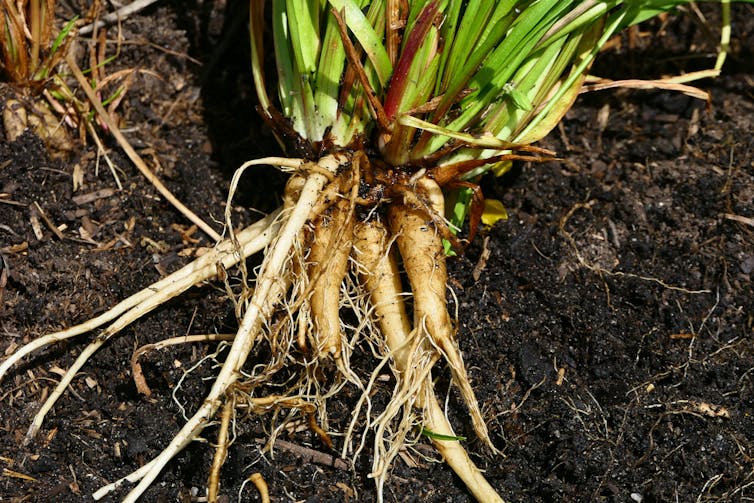
In country too dry for tubers – most of Australia – people grew grain, notably native millet (Panicum decompositum). They chose land near water, burned the ground, spread seed, blocked channels to spread water, watched the seasons to know when to return, reaped the crop by pulling or stripping with stone knives, dried, threshed and winnowed the grain, and stored it in skin bags or ground it into flour.
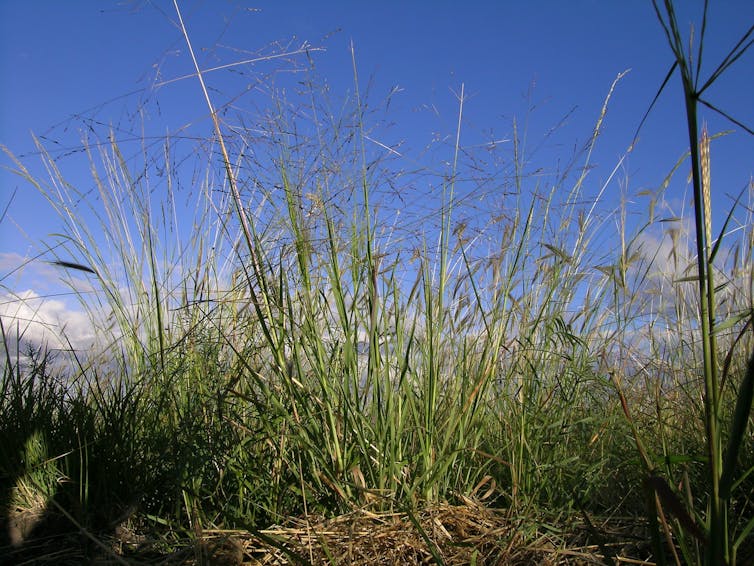
On the Narran River, northwest of Lightning Ridge, the explorer and surveyor Thomas Mitchell observed in 1848:
Dry heaps of this grass, that had been pulled expressly for the purpose of gathering the seed, lay along our path for many miles. I counted nine miles along the river, in which we rode through this grass only, reaching to our saddle-girths.
Dispossession And Reversal
Even allowing for the modern expansion of irrigation in the north, people probably farmed more of Australia in 1788 than we do now.
But we don’t crop the widespread grainlands of the arid interior. We leave them to cattle or camels. Our crops largely grow on tuber country, so a great many tubers have diminished or disappeared. How people use the land has essentially reversed since 1788, based on my research into the subject.
This upended the lives of many species. It let inland birds such as galahs, crested pigeons, and later, little corellas, expand their range. When Europeans arrived, galahs were typically inland birds. Now they’re common from coast to coast. What changed? My research suggests it was colonisation. Galahs feed on the ground. To get at tall inland grasses, they relied on Aboriginal grain cropping before contact. Afterwards, introduced stock shook or trampled grass – and expanded the galah’s range.

But ground-dwelling small and medium-sized mammals and birds declined. Dozens of species became extinct or endangered. The toolache wallaby was gone in less than a century. The lesser stick-nest rat and the paradise parrot disappeared not long after newcomers, their stock, and new predators like cats and foxes invaded their habitats. Today, even the koala is endangered.
Those who had cared for these species – the people of 1788 and after – were devastated by invasion. It’s possible they had more war dead than white Australia’s 103,000 in all its wars.
Survivors were commonly driven or taken from their country, and the land they managed so carefully was made a resource to exploit, or left to burn randomly.
So much was lost. Gone are the stories, the dances, the paintings, the languages of ten thousand campfires, gone knowledge of land, sea and sky, the skill to care for every habitat, to grow local crops and husband native animals, to feel truly at home. ![]()
Bill Gammage, Emeritus Professor, Humanities Research Centre, Australian National University
This article is republished from The Conversation under a Creative Commons license. Read the original article.
We should use Australia’s environment laws to protect our ‘living wonders’ from new coal and gas projects
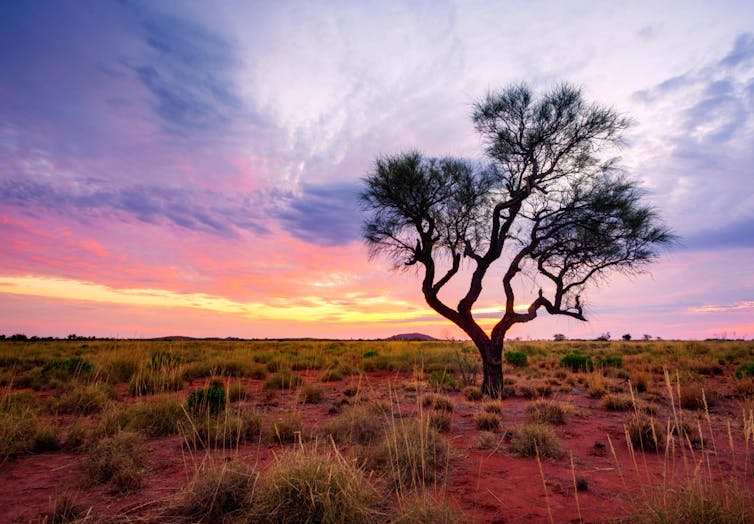
From Kakadu and the Great Barrier Reef in the North, to the Snowy Mountains in the Southeast, and jarrah and marri forests in the Southwest, Australia is home to incredibly diverse ecosystems. Many of our plants, animals, birds and fish are found nowhere else in the world.
Our First Nations people protected these living wonders through their holistic approach to managing the land and caring for Country for more than 65,000 years. But the European settlers took a different approach and the land suffered.
Federal laws made in 1999 to better protect the environment are failing. Climate change is not explicitly mentioned in the legislation. These shortcomings have prompted a volunteer environment group to mount a legal challenge against federal Environment Minister Tanya Plibersek “to protect our living wonders from coal and gas”. The matter is currently before the courts.
This week’s new report from the Climate Council Australia (which I was an expert reviewer on) explains the problem with our environment law and charts a way forward.
The fundamental flaw in our national environmental law must be urgently addressed if we are to have any hope of protecting our wildlife and habitat into the future.
Australia’s National Environmental Law
The Environment Protection and Biodiversity Conservation Act 1999 (EPBC Act) should be designed to keep our living wonders safe from harm.
The primary objective of the EPBC Act is to:
provide for the protection of the environment, especially those aspects of the environment that are matters of national environmental significance.
But it’s clear the environment is deteriorating. The EPBC Act requires a comprehensive assessment of Australia’s environment every five years. The latest assessment, published in 2022, found the state of Australia’s environment is poor and getting worse.
Climate change was identified in that assessment as one of the greatest threats to all aspects of the Australian natural environment. Climate change is a compounding factor that increases the impacts of other pressures on our environment, such as land clearing, invasive species, pollution and resource extraction.
However, climate change is not considered directly in the EPBC Act as one of the factors affecting matters of national environmental significance.
According to the Climate Council report, since 1999, 740 new projects to extract coal, oil and gas have been approved or passed, with 555 of them not having undergone detailed environmental assessment. Burning these fossil fuels increases greenhouse gas emissions and makes climate change worse.
In 2020, a scathing independent review of the EPBC Act led by former competition watchdog chair Graeme Samuel found the act is ineffective, outdated and needs comprehensive reform.

Climate Risks To Australia
In 2022, the Intergovernmental Panel on Climate Change (IPCC) released the most recent comprehensive global assessment of climate change risks.
The special fact sheet about climate impacts on natural and human systems in Australia and New Zealand provides a helpful summary of that assessment.
It lists nine key risks in Australia associated with climate change. Of these, the top five risks for our living wonders are:
“loss and degradation of coral reefs and associated biodiversity and ecosystem service values [what they are worth] in Australia due to ocean warming and marine heatwaves
loss of alpine biodiversity in Australia due to less snow
loss of natural and human systems in low-lying coastal areas due to sea level rise
increase in heat-related mortality and morbidity for people and wildlife in Australia due to heatwaves
inability of institutions and governance systems to manage climate risk”.
That last one is particularly relevant to the EPBC Act.
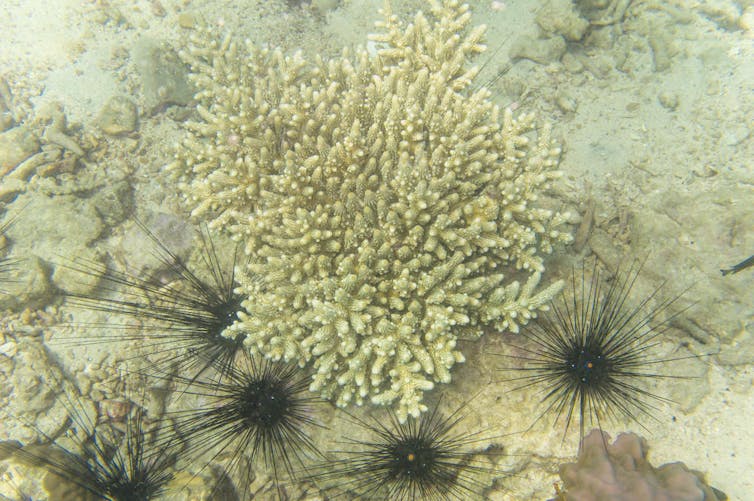
A Legal Challenge Is Underway
To test the climate blindspot in the EPBC Act, the Environment Council of Central Queensland submitted 19 reconsideration requests to Plibersek in July 2022.
The minister was asked to reconsider the previous evaluation of 19 coal and fossil gas extraction projects under the former government, because they did not take into account potential harms on Australia’s living wonders.
The environment council provided the minister with thousands of state and federal government reports listing the impacts of climate change on several thousand matters of environmental significance.
In November 2022, the minister accepted 18 reconsideration requests as valid. However, in May 2023, the minister decided not to change the climate risk assessments by the previous government for three of the projects she was asked to reconsider. In Plibersek’s official responses she determined that based on the new information provided to her in the reconsideration requests, it wasn’t possible to say the proposals would be a “substantial cause of the stated physical effects of climate change” on a matter of national environmental significance.
The matter is now in the Federal Court. Last week, the environment council challenged Plibersek’s rejection to reconsider two of the three coal mine expansion projects, both in New South Wales. A decision from the judge on this case is pending and should be provided in the next few months. A spokesperson for the minister has advised the media they would not comment “as this is a legal matter”.
Protecting Our Living Wonders Means Fixing Australia’s Environment Law
We need to fix Australia’s national environment law, making sure it contains an explicit objective to prevent actions that accelerate climate change. We need a national environment law that genuinely protects our environment by stopping highly polluting projects and enabling ones that can help us rapidly switch to a clean economy instead.
Every fraction of a degree of avoided warming matters for preserving our environment. Every decision made under our national environment law can either help or hinder the urgent task to drive down greenhouse gas emissions. ![]()
David Karoly, Professor emeritus, The University of Melbourne
This article is republished from The Conversation under a Creative Commons license. Read the original article.
Container deposit schemes reduce rubbish on our beaches. Here’s how we proved it
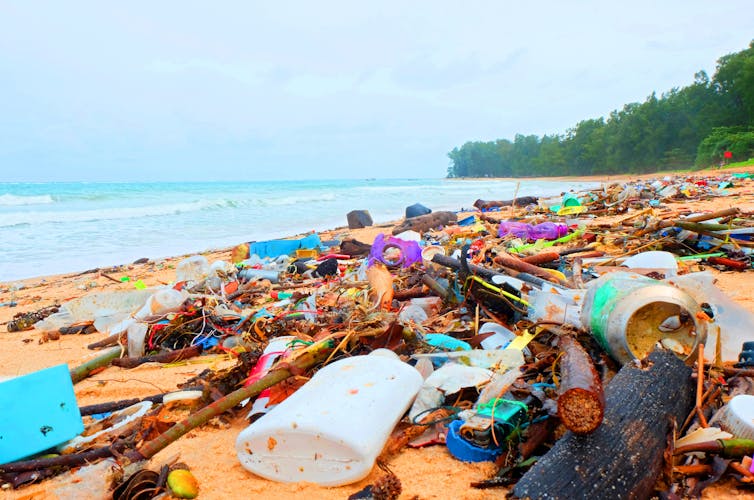
Our beaches are in trouble. Limited recycling programs and a society that throws away so much have resulted in more than 3 million tonnes of plastic polluting the oceans. An estimated 1.5–1.9% of this rubbish ends up on beaches.
So can waste-management strategies such as container deposit schemes make a difference to this 50,000–60,000 tonnes of beach rubbish?
The Queensland government started a container deposit scheme in 2019. We wanted to know if it reduced the rubbish that washed up on beaches in a tourist hotspot, the Whitsundays region.
To find out, our study, the first of its kind, used data from a community volunteer group through the Australian Marine Debris Initiative Database.
It turned out that for the types of rubbish included in the scheme – plastic bottles and aluminium cans – the answer was an emphatic yes.
Container Deposit Schemes Work
After the scheme began, there were fewer plastic bottles and aluminium cans on Whitsundays beaches. Volunteer clean-up workers collected an average of about 120 containers per beach visit before the scheme began in 2019. This number fell to 77 in 2020.
Not only that, but those numbers stayed down year after year. This means people continued to take part in the scheme for years.
Rubbish that wasn’t part of the scheme still found its way to the beaches.
However, more types of rubbish such as larger glass bottles are being added to the four-year-old Queensland scheme. Other states and territories have had schemes like this for many years, the oldest in South Australia since 1971.
But we didn’t have access to beach data from before and after those schemes started. So our findings are great news, especially as some of these other schemes are set to expand too. The evidence also supports the creation of new schemes in Victoria this November and Tasmania next year.
These developments give reason to hope we will see further reductions in beach litter.
The Data Came From The Community
To find out whether the scheme has reduced specific sorts of rubbish on beaches we needed a large amount of data from before and after it began.
The unsung heroes of this study are the diligent volunteers who provided us with these data. They have been recording the types and amounts of rubbish found during their cleanups at Whitsundays beaches for years.
Eco Barge Clean Seas Inc has been doing this work since 2009. In taking that extra step of counting and sorting the rubbish, they may not have known it at the time, but they were creating a data gold mine. We would eventually use their data to prove the container deposit scheme works.
The rubbish clean-ups are continuing. This means we’ll be able to see how adding more rubbish types to the scheme will further reduce rubbish on beaches.
The long-term perspective we can gain from such data is testament to this sustained community effort.
There’s Still More Work To Do
So if we recycle our plastics, why do we still get beaches covered in rubbish? The reality is that most plastics aren’t recycled. This is mainly due to two problems:
- technological limitations on the sorting needed to avoid contamination of waste streams
- inadequate incentives for people to reduce contamination by properly sorting their waste, and ultimately to use products made from recycled waste.
Our findings show we can create more sustainable practices and a cleaner environment when individuals are given incentives to recycle.
However, container deposit schemes don’t just provide a financial reward. Getting people directly involved in recycling fosters a sense of responsibility for the environment. This connection between people’s actions and outcomes is a key to such schemes’ success.
Our study also shows how invaluable community-driven clean-up projects are. Not only do they reduce environmental harm and improve our experiences on beaches, but they can also provide scientists like us with the data we need to show how waste-management policies affect the environment.
Waste management is a concern for communities, policymakers and environmentalists around the world. The lessons from our study apply not only in Australia but anywhere that communities can work with scientists and governments to solve environmental problems.![]()
Kay Critchell, Lecturer in Oceanography, Deakin University and Michael Traurig, PhD Researcher, School of Life and Environmental Sciences, Deakin University
This article is republished from The Conversation under a Creative Commons license. Read the original article.
Playful whales can use seaweed as a hat – or exfoliant. This “kelping” behaviour is more common than we realised
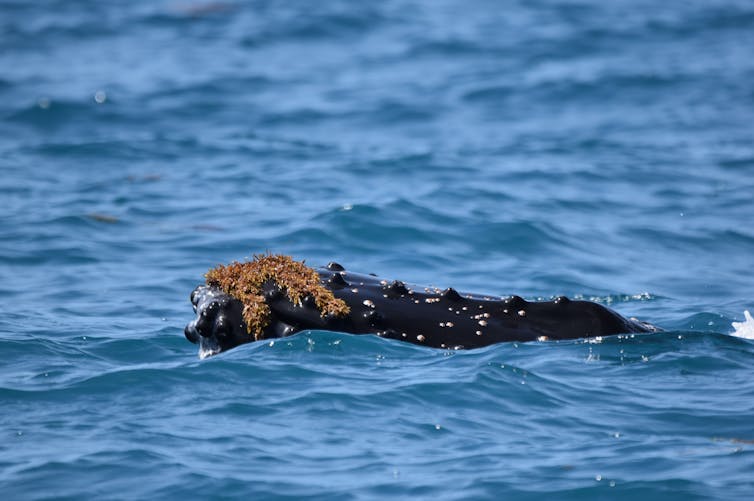
If you’re a whale, there’s often not too much to see out in deeper water. Perhaps that’s why so many whales get playful with kelp and other seaweed.
Once might have been chance. But we’ve collected over 100 examples on social media of whales playing with seaweed, known as “kelping”. It’s not just one species – gray whales, southern and northern right whales, and humpback whales all do it.
To date, there’s far more social media and news reports on whale play with seaweed than scientific literature. A 2011 study in New South Wales described these interactions as playful behaviour. Other researchers have documented instances of whales moving logs through the water in Colombia or interacting with jellyfish on the United States east coast.
Our new research compiles data from over 100 kelping events captured on social media. From this, we deduced two things. First, it is playful. And second, it’s likely to have a useful component, such as using the seaweed to scratch an itch (hard without hands), brush off baby barnacles, or flick away whale lice – parasites that drive the whales mad.
How Do Whales Find Kelp – And What Do They Do With It?
Sightings of this behaviour tend to occur in regions where kelp is abundant. That’s no surprise. Kelp is a very strong seaweed and can take the punishment a whale can dish out.
Most videos and photos capturing this behaviour are of humpback whales as they migrate. That’s also not surprising. Humpback whales are one of the most common species. They tend to migrate closer to shore. And they do more activities at the surface compared to other baleen whales, which is why beach goers and whale-watching boats most often see humpback whales.
Until now, kelp play has been documented in Australia, the United States and Canada. But this is likely due to the fact these regions have a larger number of people who do whale-watching and who use social media platforms to share their observations.
Drones have given us a new way of studying this behaviour. In several drone videos, we can see humpback whales actively seeking out seaweed. These interactions aren’t just fleeting – whales can play with it or use it for up to an hour.
During kelping, whales tend to lift the seaweed up and balance it on their rostrum, their flat upper head.
They also seem willing to share their kelp patches with other whales, engaging in cooperative behaviours such as rolling, lifting and balancing the seaweed together.
So is it play? In part, yes. When animal researchers look at a behaviour, it has to meet three criteria to be play. First, it seems voluntary and enjoyable. Second, it’s different to more serious behaviours. It can be exaggerated or deliberately incomplete. And third, the animals don’t seem stressed or hungry, suggesting they’re in good health. Kelping meets all three of these.
For animals, play has long-term benefits such as boosting their coordination and movement skills. Balancing seaweed may also be stimulating for the whales, as their rostrums have fine hair follicles. It could even be ticklish.
Kelping Might Be More Than Just Play
Toying with seaweed might have benefits other than just being fun. Some of us enjoy seaweed wraps at a spa or as a facial mask.
It might be the same for whales. Some seaweed species have been found to reduce bacterial growth, which could be useful for whales, as their skin hosts a range of viruses and bacteria. Whales have to constantly shed their skin to keep on top of bacterial growth.
There are other possibilities. Pushing through seaweed again and again could also help whales rid themselves of unwanted guests, such as the early life stages of barnacles and sea lice. Because whales are so large, many species of invertebrates hitch a lift or spend their lives on these creatures – and often to the whale’s annoyance. Grey whales off the coast of Mexico have repeatedly approached humans for help in keeping down numbers of itchy whale lice, which are actually more closely related to a shrimp or small crab than to lice.
Similar self-medication behaviour has been reported in other marine mammals, such as when Red Sea dolphins rub over sponges and soft corals to, scientists believe, help skin conditions. Even green sea turtles use corals and rocks to clean their carapace.
As more of us use drones and better cameras, we’re likely to see more whale kelping caught on camera and shared in the coming years.
Kelping shows us how much we still have to learn even about well-studied whale species such as the humpback whale. The gentle and inquisitive nature of these whales shines through when we see them play or use seaweed. Even now, there are many mysteries yet to be uncovered in nature. ![]()
Olaf Meynecke, Research Fellow in Marine Science, Griffith University
This article is republished from The Conversation under a Creative Commons license. Read the original article.
We need urban trees more than ever – here’s how to save them from extreme heat
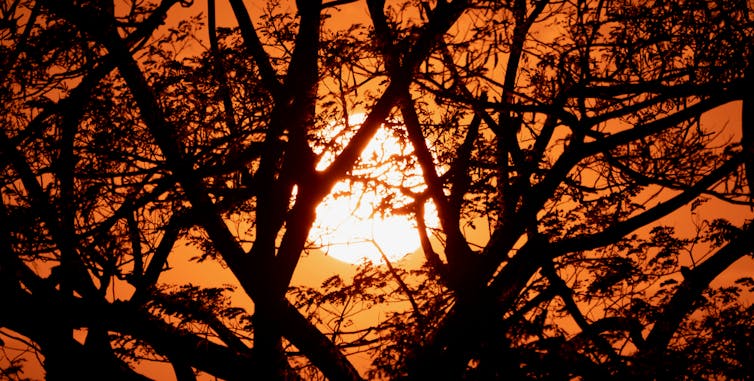
Australians are bracing for a hot spring and summer. The Bureau of Meteorology has finally declared El Niño is underway, making warmer and drier conditions more likely for large parts of the country. And we’ve just watched the Northern Hemisphere swelter through their summer, making July 2023 Earth’s hottest month on record.
We studied the effects of extreme heat on urban trees in Western Sydney during Australia’s record-breaking summer of 2019–20. So we hold grave concerns for the survival of both native Australian and exotic species in our urban forest. These stands of trees and shrubs – along streets and in parks, gardens, and yards – play vital roles in our cities. Trees improve people’s mental health and wellbeing, lower energy use, and reduce temperatures through shading and evaporative cooling.
In previous research, we compared the heat tolerance of different species. Our new research, published in the journal Global Change Biology, assessed their water use. Most of the trees we measured lost more water on hot days than models predicted.
Much like sweating in humans, trees lose water to keep cool. If there’s not enough water, dieback or tree death occurs. This means access to water will be crucial for the survival of our urban forests during the hot summer ahead.
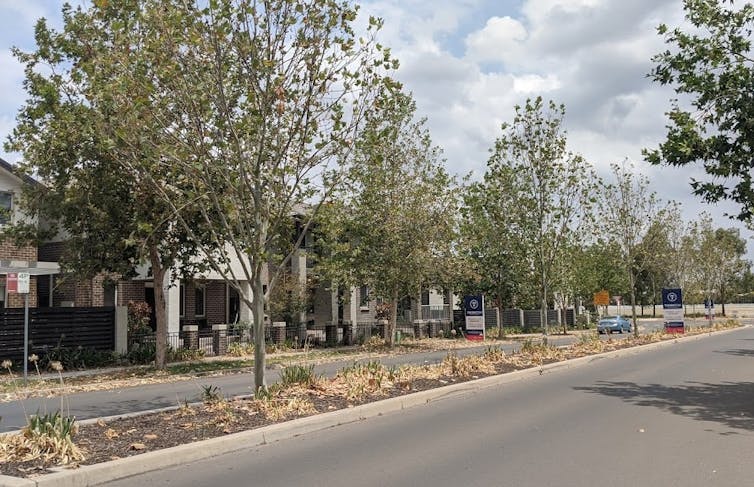
Trees During Heatwaves In Sydney
During December 2019 and January 2020, Western Sydney had 12 days over 40℃. The city’s record maximum temperature of 48.9℃ was set on January 4, 2020.
We measured carbon uptake and water loss from urban tree leaves on these hot summer days.
We found some species had low heat tolerance. Those most vulnerable to heatwaves included both native Australian and exotic species. Some trees died, including red maple (Acer rubrum), tulip poplar (Liriodendron tulipifera), coast banksia (Banksia integrifolia) and water gum (Tristaniopsis laurina). Others did not die but suffered to such an extent they were later removed.
In contrast, Chinese elm (Ulmus parvifolia) and ash (Fraxinus excelsior) avoided excessive dieback or death, as did the native weeping bottlebrush (Callistemon viminalis) and kurrajong (Brachychiton populneus).
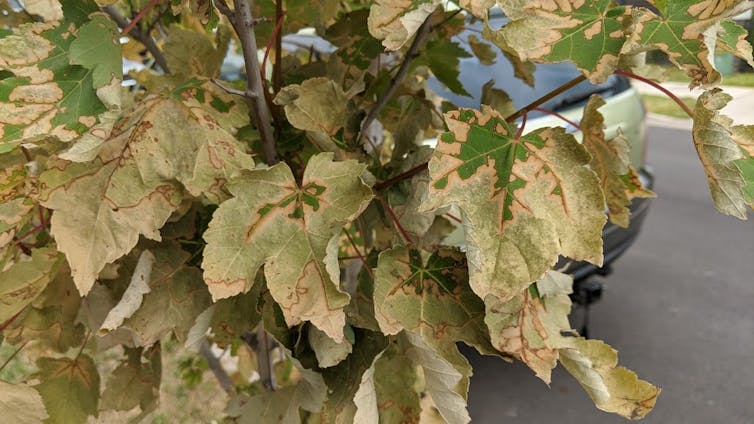
Why Are Some Species More Vulnerable?
Some species are inherently less heat and drought tolerant. For example, species with large, thin leaves are particularly vulnerable. Large leaves have thicker insulating boundary layers and so release heat more slowly. Thin leaves are less able to buffer against overheating on hot, sunny days when the wind lulls.
But it can be hard to predict how individual trees will respond to heat stress. That’s because access to water is important, but changes over time.
Trees with enough water can usually tolerate high temperatures. Microscopic pores in the leaves called stomata open up, allowing water vapour to pass through. This cools the plant down.
In drought, trees conserve water by closing these pores. This causes tree leaves to heat up. When hot days occur during drought, tree leaves can reach lethal temperatures above 45℃.
Our research found most urban tree species –- even those under drought stress –- opened their pores to cool leaves on hot summer days. This results in rapid water loss but may help prevent tree leaves from scorching.
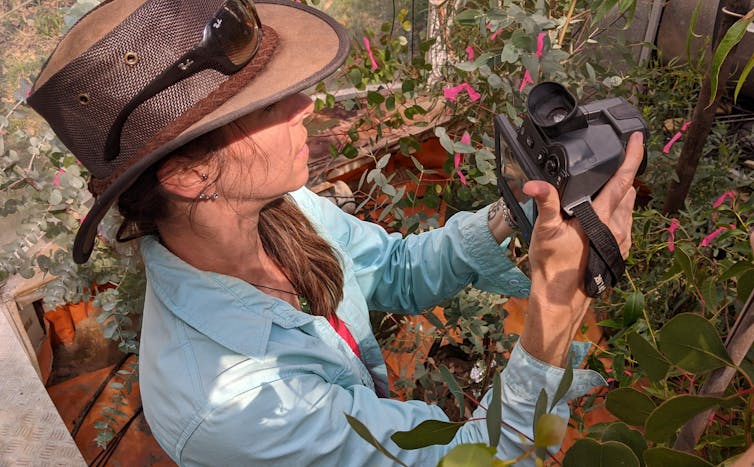
Why Is Water So Important During Heatwaves?
As part of the latest research, we grew seedlings in a glasshouse to test how access to water affected heat tolerance. We kept half the plants well watered and exposed the rest to drought conditions.
We found water loss was higher than predicted during heatwaves for all plants.
For well-watered trees and shrubs, water loss was 23% higher than predicted. This kept leaves nearly 1℃ cooler than the air temperature.
Thirsty plant leaves were more than 1℃ hotter than the air temperature.
In urban trees, leaves reached lethal temperatures of 49–50℃ for species with the lowest rates of water loss. But when species with low rates of water loss had access to water, there was little heat damage or scorched leaves. For trees that lost foliage due to overheating, their recovery took multiple years after the end of drought and return of average temperatures.
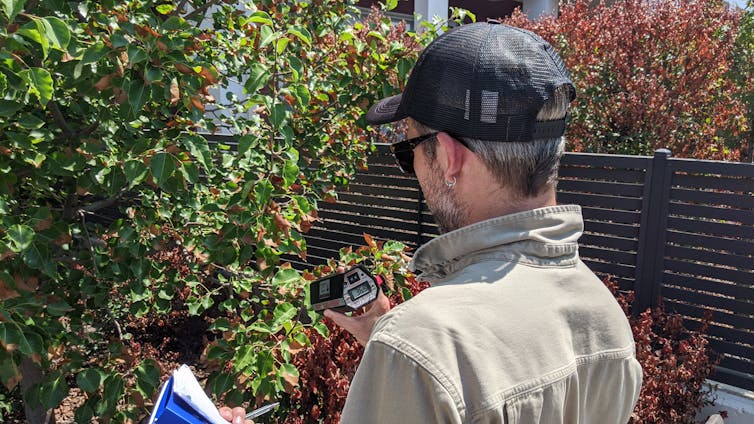
Preserving Our Natural Air Conditioners
Our research shows access to water is crucial for the survival of urban trees during heatwaves.
That means urban greening programs need to find ways to provide trees with enough water when rainfall is unreliable.
It’s worth exploring new techniques such as passive irrigation storage pits and raingardens. Passive irrigation pits capture and store stormwater in underground trenches. This both decreases runoff during storms and provides water for trees. Raingardens also naturally reduce stormwater runoff and use plants to filter pollutants from rainfall.
Providing trees with the water they need to keep cool on hot summer days will not only improve their chances of survival, but also protect people. Cities need trees now more than ever, as these natural air conditioners take the edge off the extremes. ![]()
Renée M Prokopavicius, Postdoctoral Researcher in Plant Ecophysiology, Western Sydney University; Belinda Medlyn, Distinguished Professor, Ecosystem Function and Integration, Western Sydney University; David S Ellsworth, Professor of Plant Eco-physiology, Western Sydney University, and Mark G Tjoelker, Professor and Associate Director, Hawkesbury Institute for the Environment, Western Sydney University
This article is republished from The Conversation under a Creative Commons license. Read the original article.
‘Nature positive’ isn’t just planting a few trees – it’s actually stopping the damage we do
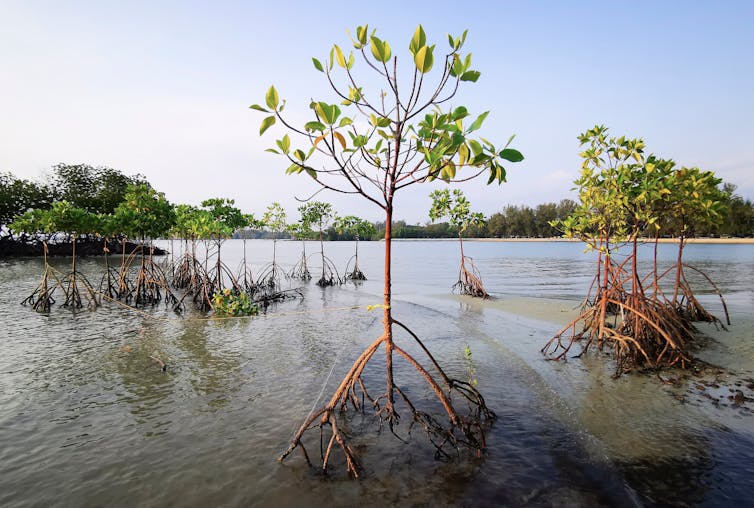
Have you heard the phrase “nature positive”? It’s suddenly everywhere.
The idea is simple: rather than continually erode the natural world, nature positive envisions a future with more nature than we have now.
Created by an environmental alliance, the nature positive concept has been embraced by industry, world leaders and conservationists.
Sudden popularity can be reason for caution. After all, we’ve seen well-intended ideas become cover for greenwashing before. And without strong guardrails, we risk nature positive being used as a distraction from continued failures.
Our new research points to three ways to make sure nature positive is truly positive for nature.
What’s The Big Idea?
According to the Nature Positive Initiative, “nature positive” aims to
halt and reverse nature loss measured from a baseline of 2020, through increasing the health, abundance, diversity and resilience of species, populations and ecosystems so that by 2030 nature is visibly and measurably on the path of recovery
So, nature positive means seriously scaling back negative impacts on nature – through tackling land clearing, invasive species, and climate change – while also investing in positive impacts like ecosystem restoration and rewilding.
The goal is hugely ambitious. But it’s also essential.
The natural world is humanity’s life-support system. But we have now seriously compromised the biosphere’s ability to support us.
Australia’s environment minister, Tanya Plibersek, has backed the idea, announcing plans for a nature positive summit next year. The goal: “drive private sector investment to protect and repair our environment”.
You can also see the influence of nature positive in Plibersek’s plans for a nature repair market. And just this month, the New South Wales review of biodiversity laws recommended nature positive become “mandatory.”
We Must Be Wary Of Greenwashing
The risk of big-picture plans is that they can be used for PR purposes – serving to make companies or governments look good on the environment rather than actually improving nature’s lot.
Already, the term nature positive is being used too freely to refer to any vaguely green action.
This new focus on nature positive mustn’t distract from the need to fully address ongoing negative impacts.
Take the Australian government’s Nature Positive Plan – its official response to the scathing 2020 review of Australia’s national environment law.
Under the plan, ‘conservation payments’ could be made by developers when destruction of threatened biodiversity is permitted, but suitable environmental offsets cannot be found.
These conservation payments would then be invested by government into conservation projects – but they would not necessarily benefit the same biodiversity destroyed by the development.
The plan states this approach will deliver “better overall environmental outcomes”. In reality it could make it possible to destroy habitat of our most threatened species and replace it with other, easier-to-replace biodiversity – as long as there is more “nature” overall.
Positive For Nature: The Fundamentals
For “nature positive” to actually be positive for nature, it must do what it says on the tin. We cannot let this vitally important movement be used to justify further loss of valuable ecosystems or species, or to exaggerate the benefits of action.
Our research suggests three ways to make sure claims about nature positive are not misleading.
First, we have to make sure any proposal that might damage nature follows the “mitigation hierarchy”. In short: can biodiversity losses be avoided entirely? If not, can they be kept to a bare minimum? Any remaining impacts must be fully compensated with gains of the same type and amount elsewhere.
Unfortunately, this is rarely achieved. In practice, developers often do poorly on avoiding or minimising damage. Instead, they rely heavily on the final, most risky step – offsets.
Yes, offsets can work – in very limited situations. They cannot replace the irreplaceable. And much of nature is irreplaceable.
Old-growth forests cannot be replaced. The same goes for tree hollows – these take hundreds of years to form, and artificial nesting boxes often don’t work.
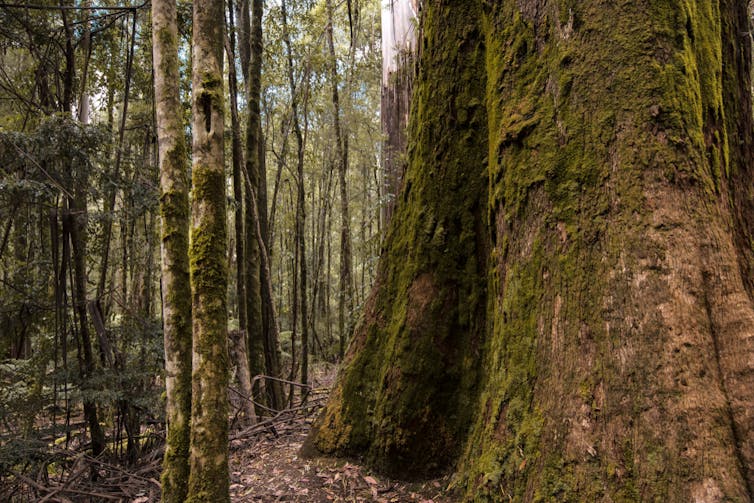
So, the move towards nature positive must not replace rigorous adherence to the mitigation hierarchy with more general environmental action which doesn’t fully address damage.
Second, organisations must consider not just their direct impact on biodiversity, but the footprint of their whole operation and its resource use.
Achieving nature positive will mean tackling entire supply chains.
It’s not easy to account for, reduce and compensate for your company or organisation’s unavoidable impacts on nature. But it can be done. It will require improvements in knowledge and traceability of supply chains, reducing consumption, and investing in nature restoration to make up for the leftover harms unable to be eliminated.
And third, organisations signing up to nature positive must contribute to active ecological restoration. That’s on top of any compensation for their own direct and indirect impacts. The huge scale of historical damage to the environment means that even if organisations completely address all of their current and future biodiversity impacts, nature positive will still not be achieved.
Here, so-called voluntary biodiversity credits may play a useful role.
But wherever there are credits, there’s risk. It’s entirely possible companies could simply buy these credits without avoiding and minimising biodiversity losses in the first place – the exact same problem plaguing carbon offsets.
Nature Positive Is Welcome – Now Let’s See It In Action
For decades, conservationists have tried to protect what’s left of the natural world through lobbying for protected areas and better environmental laws. But nature’s decline has only accelerated. Economic growth and profit have always taken precedence.
Moving to a truly nature positive world, one fit to provide future generations with all that we enjoy from nature, means a serious societal shift. For this reason, nature positive is welcome.
It’s not enough to slow the decline – it’s time to reverse it.
But we must not underestimate the task ahead.
Only if nature positive commitments are translated into action with rigour can they help reduce the damage we do, alongside spurring on ecological restoration and rewilding. But if nature positive is used as a tactic for positive publicity, it won’t change a thing. ![]()
Martine Maron, Professor of Environmental Management, The University of Queensland; Megan C Evans, Senior Lecturer, Public Sector Management, UNSW Sydney, and Sophus zu Ermgassen, Postdoctoral Researcher, University of Oxford
This article is republished from The Conversation under a Creative Commons license. Read the original article.
It’s not just Victoria’s iconic mountain ash trees at risk – it’s every species in their community
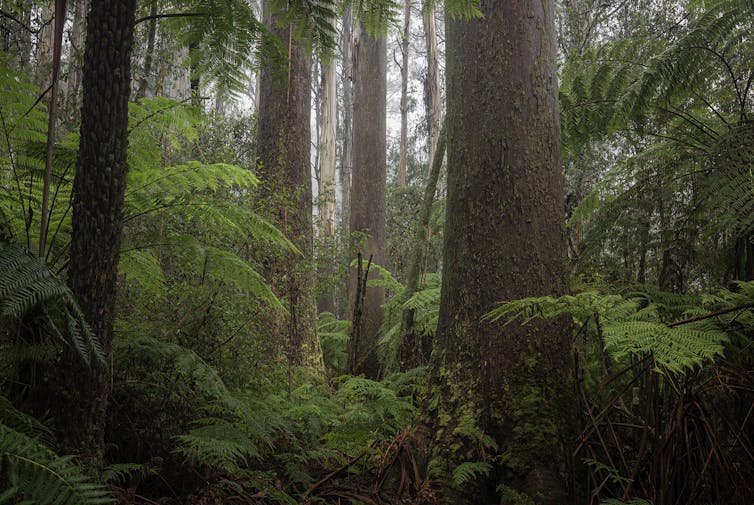
When we think of extinction, we think of individual species. But nature doesn’t operate like that. Entire communities and even whole ecosystems are now so compromised they could be lost entirely. Australia now has about 100 ecological communities at risk.
One of those is the iconic Mountain Ash (Eucalyptus regnans) community in Victoria’s Central Highlands. Many of us know and love these regal trees, the tallest flowering plant in the world. But decades of logging, repeated wildfires, and fragmentation of these forests means they and the species which rely on them like Leadbeater’s possum and gliders now face existential threats.
In our new research, we point to the need to list the entire community as threatened.
How Can Ecological Communities Go Extinct?
Australia is an enormous contributor to global biodiversity loss. A recent study found 97 species in Australia have now gone extinct since British colonisation in 1788, with roughly 10% of all native mammal species gone forever. The numbers would be higher if invertebrate losses were included.
Worldwide, roughly a million species are now at risk of extinction. Looming loss at this scale threatens entire ecological communities – or even whole ecosystems.
Under Australia’s biodiversity laws, ecological communities can be listed as threatened, endangered or critically endangered. About 100 ecological communities – defined as assemblages of species in a particular habitat – are currently at risk. But even this figure is likely to be a massive underestimate.
Many ecological communities are not on this list even though they probably should be. The reason for that is a lack of good data.
To find out whether a community is threatened requires a thorough assessment of many species and key ecological processes using high-quality long-term data.
These kinds of data aren’t available for many communities. But we have 40 years of detailed data for the Central Highlands Mountain Ash forests. So to find out whether they are truly threatened, we undertook a detailed assessment.
Why Are These Forests At Risk Of Collapse?
These forests cover 140,000 hectares near Victorian towns like Marysville, Warburton and Healesville. They’re rich in biodiversity, including several threatened mammals and plants.
We focused on the Central Highlands because this area is home to the largest remaining forests of Mountain Ash – 44% of all remaining forest.
Much elsewhere has been lost. In South Gippsland, plantations, dairy and potato farms have replaced Mountain Ash forests, with only small fragments left.
Tasmania’s Mountain Ash forests are important, albeit less extensive than those in Victoria’s Central Highlands.
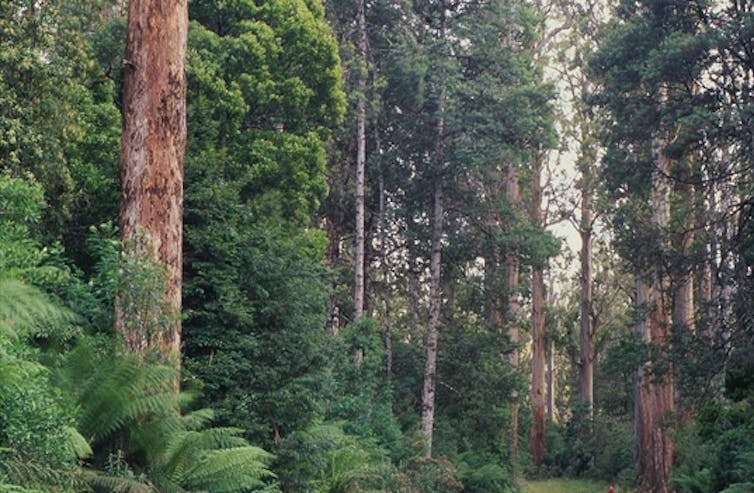
Our conclusion? Sadly, the Central Highlands Mountain Ash community is now eligible for listing as either endangered or critically endangered.
These forests are now largely regrowth. Many have been fragmented, making it harder for wildlife to cross between patches. Biodiversity is still declining, including threatened species, while changing fire regimes are placing intensive pressure on the remaining forests.
What happened here? These forests have been subject to decades of intensive clearfell logging, as well extensive cutting dating back to the late 1920s.
These pressures have made old growth a vanishing rarity, accounting for just over 1% of the remaining 137,000 hectares of Mountain Ash forest in the Central Highlands. The rest of the forest is often highly degraded.
The loss of almost all old growth has been devastating for species like Leadbeater’s possum, the southern greater glider and the yellow-bellied glider over the past 25 years. These animals must have nesting hollows to survive, and these only form when large old trees lose limbs - a process that can take well over 100 years.
And because the Mountain Ash community is dominated by younger trees, it is now at risk of reburning. Younger trees are highly fire-prone – even those regenerating from the Black Saturday fires of 2009. This has left the entire ecological community vulnerable to future fires.
Our analysis found nearly 70% of these forest communities are already either severely disturbed by fire and logging or exist within 70 metres of severely disturbed areas.
What Would Happen If Mountain Ash Communities Collapse?
These pressures have pushed these forests to the edge. They could readily collapse and be replaced by an entirely different community, dominated by wattles and prone to more fire, more often.
The collapse of the Mountain Ash community would have catastrophic implications for the five million people who live in Melbourne. The city’s famously good drinking water relies almost entirely on run-off from Mountain Ash forest to the east.
You might wonder – won’t the ending of industrial logging in January help? It might – if we undertake a massive restoration effort. Many tracts of forest are simply not regenerating after logging – up to 30%.
Restoring tree cover, species diversity and making the ecosystem functional again will take a great deal of work.
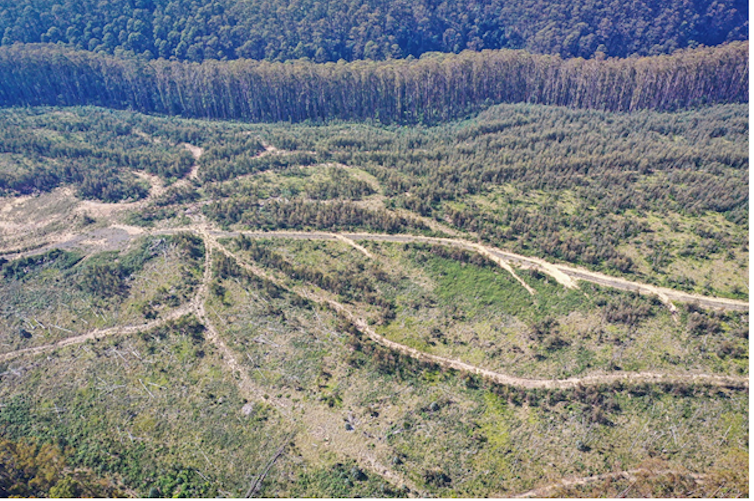
What Can We Do?
The case is compelling for listing Victoria’s Mountain Ash community as threatened.
Huge efforts will be required to stop the populations of animals such as the southern greater glider from plunging. Recently, we have been testing new nesting box designs to help populations recover. These boxes are meant to be a stop-gap substitute as nesting hollows to replace natural cavities.
We’ll also have to do our best to keep out high-intensity wildfire from as many areas of Mountain Ash forest as possible, so the young trees have a chance to mature and develop hollows.
This kind of restoration is compatible with efforts by conservationists to declare a Great Forest National Park to protect Mountain Ash communities.
It’s well established that protecting areas does work. For example, an estimated 25% of the world’s bird species are alive today because they have been protected in reserves.
Listing an ecological community as threatened isn’t a one-way street to extinction. We can – and have – reversed the damage for other communities and species. We need do it for Mountain Ash forests, and it must be done now. ![]()
David Lindenmayer, Professor, The Fenner School of Environment and Society, Australian National University; Chris Taylor, Research Fellow, Fenner School of Environment and Society, Australian National University; Elle Bowd, Research fellow, Australian National University, and Kita Ashman, Adjunct research associate, Charles Sturt University
This article is republished from The Conversation under a Creative Commons license. Read the original article.
It wasn’t just a tree: why it feels so bad to lose the iconic Sycamore Gap tree and others like it
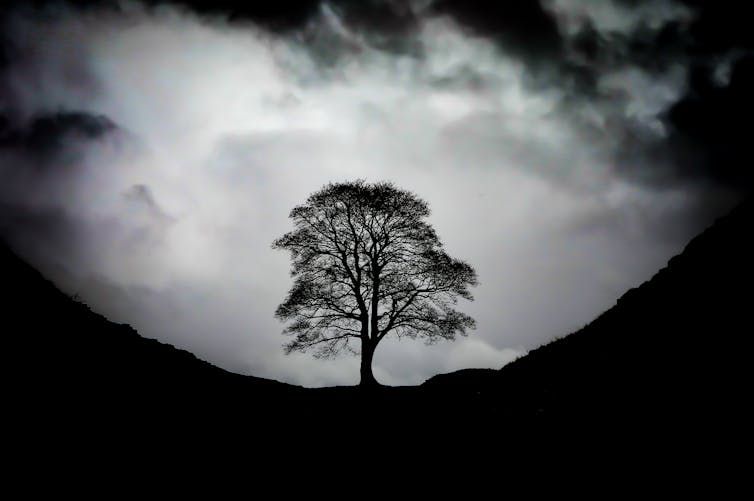
The famous Sycamore Gap tree was felled last week, prompting global expressions of sorrow, anger and horror. For some, the reaction was puzzling. Wasn’t it just a single tree in northern England? But for many, the tree felt profoundly important. Its loss felt like a form of grief.
Trees tell us something important about ourselves and who we are in the world. That is, they contribute to ontological security – our sense of trust that the world and our selves are stable and predictable.
Trees – especially those celebrated like England’s sycamore or Tasmania’s 350-year-old El Grande mountain ash – feel like they are stable and unchanging in a world where change is constant. Their loss can destabilise us.
What Makes A Tree Iconic?
Individual trees can become important to us for many reasons.
When the wandering ascetic Siddhartha Gautama sat at the foot of a sacred fig around 500 BCE, he achieved the enlightenment which would, a few centuries later, lead to his fame as the Buddha. This sacred fig would become known as the Bodhi Tree. One of its descendants attracts millions of pilgrims every year.
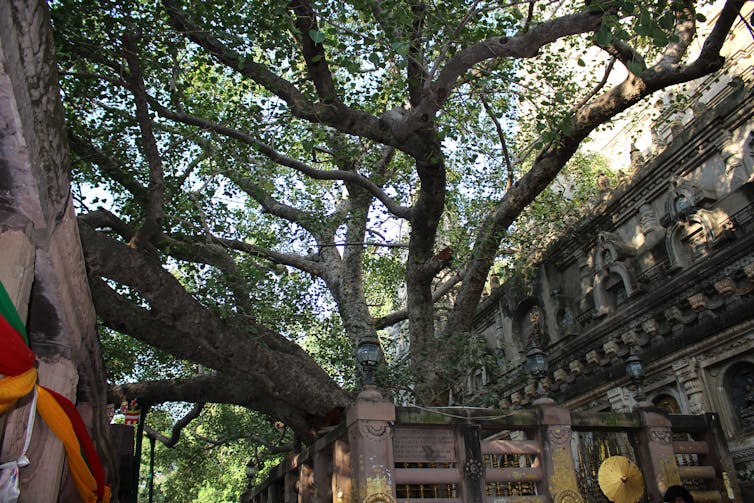
Sometimes a tree becomes iconic because of its association with pop culture. U2’s hit 1987 album The Joshua Tree has inspired fans to seek out the tree on the cover in the United States’ arid southwest – a potentially dangerous trip.
Other trees become famous because they’re exceptional in some way. The location of the world’s tallest tree – a 115-metre high redwood known as Hyperion – is kept secret for its protection.
Niger’s Tree of Ténéré was known as the world’s most isolated, eking out an existence in the Sahara before the lonely acacia was accidentally knocked down by a truck driver in 1973. Its site is marked by a sculpture.
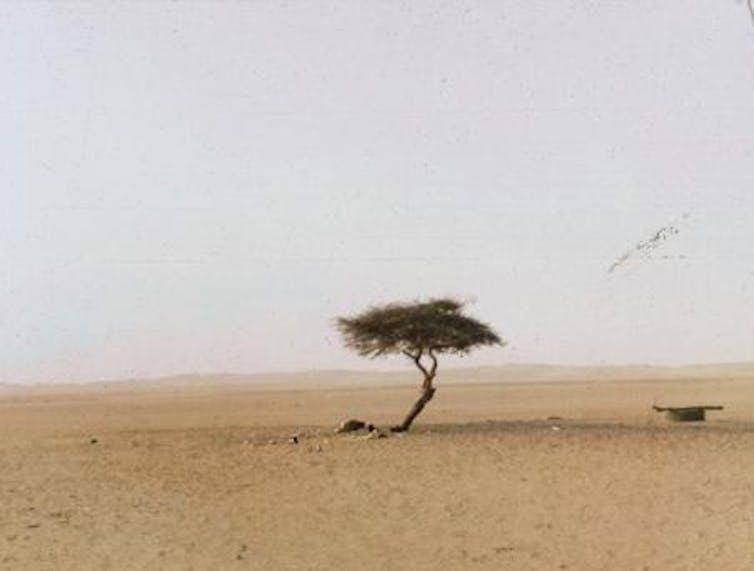
In 2003, the mountain ash known as El Grande – then the world’s largest flowering plant – was accidentally killed in a burn conducted by Forestry Tasmania. The death of the enormous tree – 87 metres tall, with a 19 metre girth – drew “national and international” media attention.
This year, vandals damaged a birthing tree sacred to the local Djab Wurrung people amidst conflicts about proposed road works in western Victoria.
And in 2006, someone poisoned Queensland’s Tree of Knowledge – a 200-year-old ghost gum famous for its connection to the birth of trade unionism in Australia. Under its limbs, shearers organised and marched for better conditions. The dead tree has been preserved in a memorial.
What Is It To Lose A Tree?
Sociologist Anthony Giddens defines ontological security as a “sense of continuity and order in events”.
To sustain it, we seek out feelings of safety, trust, and reassurance by engaging with comfortable and familiar objects, beings and people around us – especially those important to our self-identity.
When there is an abrupt change, it challenges us. If your favourite tree in your street or garden dies, you mourn it – and what it gave you. But we mourn at a distance too – the Sycamore Gap tree was world-famous, even if you never saw it in real life.
In my research, I have explored how Tasmanian forests – including iconic landscapes and individual trees – can give us that sense of security we all seek in ourselves.
As one interviewee, Leon, told me:
These places should be left alone, because in 10,000 years they could still be there. Obviously I won’t be, we won’t be, but perhaps [the forest will be].
Temporality matters here. That is, we know what to expect by looking to the past and imagining what the future could be. Trees – especially ancient ones – act as a living link between the past, present, and future.
As my interviewee Catherine said:
You lie under an old myrtle and you just go, ‘wow - so what have you seen in your lifetime?’ Shitloads more than me.
That’s why the loss of the Sycamore Gap tree has upset seemingly the entire United Kingdom. The tree was famous for its appearance: a solitary tree in a photogenic dip in the landscape.
Its loss means a different future for those who knew it. It’s as if you were reading a book you know – but someone changed the ending.
Loss Of Connection
We respond very differently when humans do the damage compared to natural processes. In one study, UK homeowners found it harder to accept their house being burgled than for it to be flooded, seeing flooding as more natural and thus less of a blow to their sense of security.
This is partly why the sycamore’s death hurt. It didn’t fall in a storm. It was cut down deliberately – something that wasn’t supposed to happen.
The sycamore was just a tree. But it was also not just a tree – it was far more, for many of us. It’s more than okay to talk about what this does to us – about how the loss of this thread of connection makes us grieve.
Yes, we have lost the Sycamore Gap tree, just as we lost El Grande and many others. It is useful to talk about this - and to remember the many other beautiful and important trees that live on. ![]()
Rebecca Banham, Postdoctoral fellow, University of Tasmania
This article is republished from The Conversation under a Creative Commons license. Read the original article.
Even platypuses aren’t safe from bushfires – a new DNA study tracks their disappearance
Emily McColl-Gausden, The University of Melbourne and Andrew Weeks, The University of MelbourneWhen the Black Summer bushfires swept across eastern Australia in 2019–20, thousands of animal species lived in the path of these megafires.
You’d be forgiven for thinking water-dwelling animals like platypuses were spared. Surely animals living in rivers and streams would be safe?
But our new research, published today in Biological Conservation, reveals platypuses are disappearing from waterways after fire.
We took water samples from streams and rivers across south-eastern Australia to test for platypus DNA. We found platypuses were less likely to be found in burnt catchment areas, six months after fire. But the species returned after 18 months. We hope our findings will support conservation actions in the event of future bushfires.
An Evolutionary Masterpiece
Platypuses are much loved and unique to Australia. As monotremes, they lay eggs. They’re one of only five species of mammals that does – the other four are echidnas.
They have webbed feet for swimming. And they have electroreceptors in their bills to help them find food in rivers and streams.
But they can be hard to find. It’s difficult to determine whether there’s a platypus living in a particular waterway.
Monitoring allows us to detect changes in populations or communities. There may be gradual changes over time, or rapid responses to a big disturbance, such as a fire. Quick, efficient methods are vital for surveying species that occupy large areas.
DNA Detective Work
Platypuses are found in waterways throughout the east coast of Australia, from Cooktown in northern Queensland to Tasmania.
Little is known about how platypuses and other aquatic or semi-aquatic animals respond to fire. Ideally we would have good data on species before and after a fire, to draw comparisons. But that is rare.
Other research shows aquatic invertebrates (animals with no backbones) and fish can be harmed by bushfire, especially when rain follows fire.
Bushfires burn and kill the vegetation that stabilises the soil around rivers or streams. When rain follows fire, a lot of ash, soil and other debris can be washed into waterways. The water chemistry might change or there might be big increases in sediment, which makes the river or stream inhospitable for invertebrates and fish.
As platypuses feed on aquatic invertebrates such as yabbies, these flow on effects of fire could also impact them.
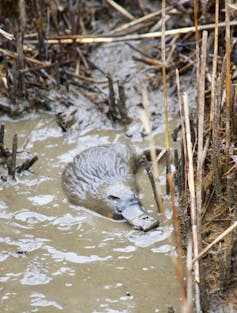
Just as people leave traces behind as they move through the environment (such as fingerprints, hair and skin cells), so do animals. These traces contain genetic material that can be analysed to identify the likely source.
We used this “environmental DNA” to detect where platypuses were present across the study area.
We sampled 118 rivers and creeks across Victoria, New South Wales and the Australian Capital Territory a year before the Black Summer fires, for a project on platypus distribution. This was fortuitous, because it provided a baseline for us to determine the effects of the unprecedented fires.
We took more environmental DNA samples from the same 118 sites at six months after the megafires, and also 12–18 months post-fire, giving us three data points for the same rivers and creeks.
The sampling sites were spread across burnt and unburnt areas, giving us unaffected (control) sites to use as a comparison.
What We Found
Six months after the megafires, platypuses were less likely to be living at sites that experienced fire. But the difference between burnt and unburnt sites was negligible after 18 months.
The combination of severe fire and rainfall minimised the chance of finding platypuses living at a site.
Watersheds are areas of land that drain rainwater into local streams and creeks. We used the watershed of each site to calculate the area over which rain would drain to a site.
We also looked at what proportion of the watershed was burnt at high severity, as we thought this would increase the chance of destabilised soils and ash being washed into the waterways. We classified high severity fire as fire which removed all of the leaves from trees and burnt grasslands or pasture.
From our work, we predicted that sites where the watershed had at least 25% of its area burnt at high severity, and also experienced high rainfall, had a less than 10% chance of platypuses occupying those sites.
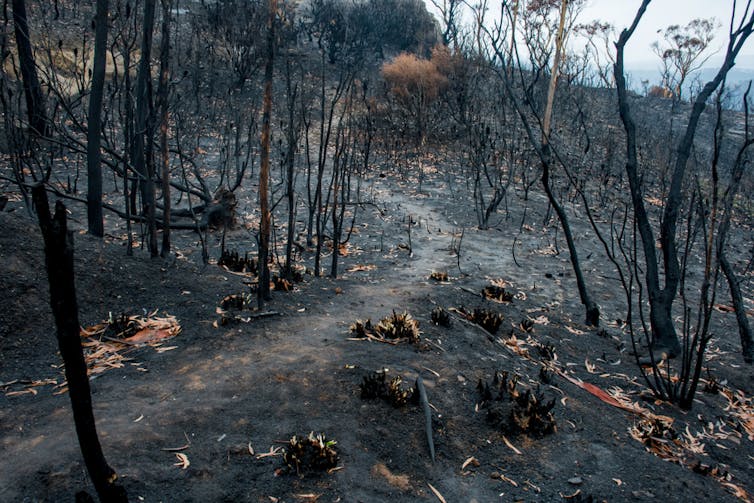
Understanding Change
Climate change is predicted to lead to more frequent, severe and extensive bushfires in south-eastern Australia, as well as to more extreme rainfall events.
Our work adds to our understanding of how just one species could be harmed by the climate crisis.
We need these types of systematic surveys to provide baselines and monitor how populations and communities are changing. Monitoring will also help us respond more efficiently to major disturbances like the Black Summer bushfires, where, for many species, there wasn’t enough data to inform the initial emergency conservation response.
We would like to acknowledge Josh Griffiths, Reid Tingley and Luke Collins for their invaluable contribution to this work and Jaana Dielenberg for early discussions about this article.![]()
Emily McColl-Gausden, Research fellow, The University of Melbourne and Andrew Weeks, Associate Senior Research Scientist, The University of Melbourne
This article is republished from The Conversation under a Creative Commons license. Read the original article.
The green energy surge still isn’t enough for 1.5 degrees. We’ll have to overshoot, adapt and soak up carbon dioxide

It was a rare bit of good news on climate. The International Energy Agency this week released its latest net zero roadmap, showing it was still just possible to hold global heating to 1.5℃.
In the last two years, we’ve seen major global investment in clean energy, spurred on by energy independence concerns raised by the war in Ukraine, as well as intensifying extreme weather.
Even so, it’s unlikely to actually keep us under 1.5℃, the globally agreed target to avoid the worst impacts of climate change.
Why? Because emissions are still rising – even as many countries make their energy grids greener.
Why Is It So Hard?
In part, because we’ve left our run very late. The Intergovernmental Panel on Climate Change released its first assessment in 1990. Since then, the world has emitted one trillion tonnes of carbon dioxide, which is two-thirds of the carbon budget. That is, the amount of permissible emissions that would feasibly allow us to limit global warming to 1.5℃ above the pre-industrial temperature.
At the beginning of this year, the world had just 380 billion tonnes of carbon dioxide left in the carbon budget. Global emissions have been about 40 billion tonnes a year over the past few years with no sign of decline. At that rate, we’ll hit 1.5℃ in about nine years, and 2℃ in 30 years.
We are not moving fast enough, on enough fronts, to wean ourselves off fossil fuels.
For instance, even though the use of electric vehicles is growing fast, it’s off a low base. The world still has an estimated 1.4 billion internal combustion engine cars, which run on petrol, diesel or gas.
Emissions from all forms of transport are increasing. Fossil gas use is surging. Coal use was thought to have peaked in 2013. But it’s back at even higher levels over the past two years, as nations scramble to shore up energy supplies due to the war in Ukraine.
Clean alternatives haven’t yet replaced fossil fuels at sufficient scale. It doesn’t matter how many solar panels are installed unless they also substitute the power that fossil fuels provide. And on a global scale, that’s not happening quickly enough to prevent us hitting 1.5℃.

But the good news is we’re finally seeing something that seemed all but impossible just 10 years ago – nation after nation finally getting serious on climate change.
Renewables are so cheap they’re getting built because they make money – at the expense of old fossil fuel plants. Electric vehicles are here, and will make life better, from cutting running costs to radically improving air quality in our cities. Many nations will achieve energy independence.
We are making rapid progress in greening the electric grid, with China building even more renewables than its government targets. On the streets of Shanghai and Oslo, electric vehicles are a common sight.
These trends need to spread worldwide, and fast.
Economic sectors that produce large volumes of emissions, such as concrete and steel making, are difficult to decarbonise and will take longer. Likewise for the aviation and food system sectors, where emissions keep rising.
Renewables, after all, are a means to an end. The goal is to rapidly reduce the use of fossil fuels, with any unavoidable emissions captured and permanently sequestered.
Until now, the very best we’ve done is to meet the growth in global demand for energy with non-fossil fuel sources – not to actually cut emissions. To actually slash emissions means transformational change.
Why The Positive Forecast?
Our best climate projections, the rate we’re using our remaining carbon budget, and current climate policies in place all consistently lead us to temperatures well past 1.5℃ by the end of the century.
So why is the International Energy Agency still floating the possibility of stabilising the climate at 1.5℃?
If you read the report, it becomes clear. Achieving net zero at this late stage will mean overshooting 1.5℃ – and then using trees and negative emissions technologies at a very large scale to bring us back to that level.
This will take the creation of a whole new industry of atmospheric greenhouse gas removal and decades of effort.
So even as the world accelerates climate action, the claim that we can avoid climate change from reaching and passing 1.5℃ is out of reach.
What Does This Mean?
If humanity blows past the target of 1.5℃ and keeps warming the planet, it doesn’t mean we just give up. Every decimal of a degree avoided matters a lot.
We’re only at 1.2℃ now, and extreme weather, fire activity and other damage from climate change is coming thick and fast.
But there are clear risks in relying too much on the potential of removing large quantities of greenhouse gases from the atmosphere while also bringing down emissions as close to zero as possible.
Overshooting 1.5℃ has another important implication. For years, climate action – cutting emissions – has been at the forefront of global efforts. But we have been too slow. Now we have to adapt to the rapidly evolving climate, with new policies, investment and preparedness.
This is not a story of unavoidable catastrophe. Climate scientists, on the whole, are optimists. All the work being done means we’re finally seeing positive change. But the numbers don’t lie. We must get those emissions down. ![]()
Pep Canadell, Chief Research Scientist, Climate Science Centre, CSIRO Oceans and Atmosphere; Executive Director, Global Carbon Project, CSIRO
This article is republished from The Conversation under a Creative Commons license. Read the original article.
Renewables are cheaper than ever yet fossil fuel use is still growing – here’s why
Malte Jansen, University of SussexWind and solar are the world’s fastest growing energy sources and together generated 12% of global electricity in 2023. The amount of energy produced by wind and solar is expected to increase and accelerate.
Wind generated 1 terawatt (TW) for the first time in 2023 – nearly as much as the total installed energy capacity of the US (1.2 TW). Solar broke this threshold in 2022.
So why in the first global stocktake of the world’s progress towards limiting warming to 1.5°C did the UN say we’re still not phasing out fossil fuels fast enough?
Asia’s Economic Growth Powered By Coal
Despite the rapid growth of renewable energy, the most carbon-intensive forms of electricity generation, using coal and natural gas, have risen by 22% and 37% since 2010, respectively. Coal and gas power generation is still the backbone of global energy systems and these fuels are likely to remain dominant for decades to come. Nonetheless, the phase-out of coal (arguably the dirtiest of fossil fuels) is gaining momentum.
During the past decade, the number of new coal power plants built each year has fallen fast. Global coal demand has continued to fall even as the war in Ukraine strained gas supplies.
In the most prosperous OECD countries (or Organisation for Economic Co-operation and Development), virtually no new coal plants are planned or being built, though new coal mines are still being approved. This is a result of national policies such as the UK’s decision to ban coal in power generation from October 2024.
The US has retired many ageing coal plants since the mid-2010s due to the low price of shale gas. The country’s coal fleet will continue to shrink as 99% of coal projects are more expensive than new clean energy, thanks to the Inflation Reduction Act (IRA).
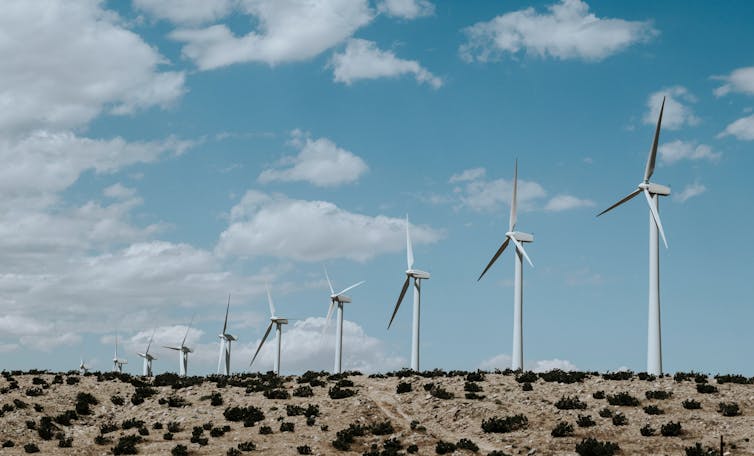
This picture is very different in Asia. Here, countries have relied heavily on cheap coal to fuel their economies. This is particularly true in China. After adding 27 gigawatts (GW) from coal in 2022 alone, China by itself is offsetting the retirement of coal plants elsewhere in the world.
But there are some signs this is changing. The global pipeline for new coal power plants is smaller than ever and China and India both pledged to “phase down coal” in 2021 at the Glasgow climate summit.
So, rapidly increasing renewable energy hasn’t cut coal and gas consumption at the same rate because humankind is using a lot more electricity than we used to, especially in Asia. In the last 20 years, the use of electricity in Europe and North America has remained largely constant.
Here, renewable energy has slowly eaten into the proportion of energy generated by fossil fuels, while all other energy sources (nuclear, hydro, biomass) have remained about the same. In Asia, electricity demand has tripled since the 2000s, with the bulk of this energy coming from fossil fuels.
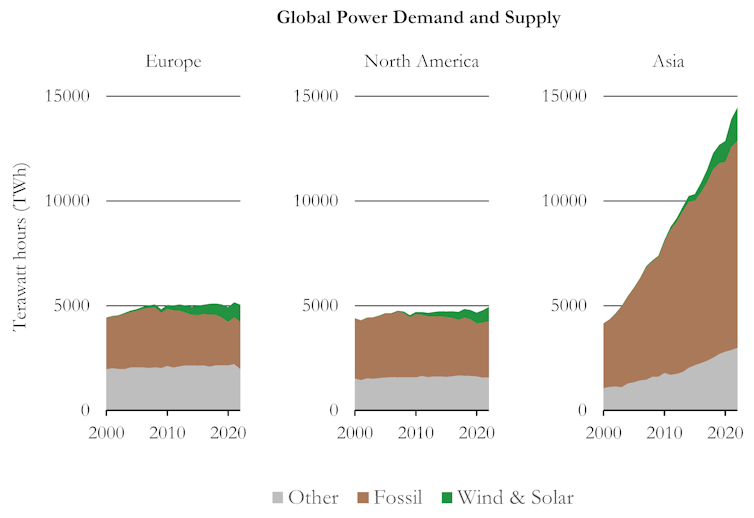
Wind And Solar Are Replacing Coal And Gas
Western economies have made progress in replacing fossil fuels (and coal in particular) with renewables during the last decade. In Europe and North America, wind has become a vital energy source during the winter months when energy demand peaks. And when the wind isn’t blowing, gas generation fills the gaps.
Solar energy, when combined with batteries which can store excess electricity, is also proving to be a cheaper option than both gas and coal in certain parts of the world. In Australia, the industry association Australian Clean Energy Council found that solar panels and batteries are 30% cheaper than gas power plants during peak demand periods.
A Bloomberg NEF investigation found that batteries alone are already cheaper than gas power plants during these times. In fact, solar panels may be generating electricity more cheaply than the grid in some cases.
In India, the cost of generating electricity from solar and storing it in batteries to use during high demand hours has lower costs than existing coal plants. Combined solar and battery plants can activate during peak hours and turn off again when demand drops, regardless of whether the wind is blowing or the sun shining.
In the US, almost half of new energy projects waiting to connect to the grid combine solar and wind with storage technologies, allowing renewables to produce electricity on demand regardless of the weather.
Energy Demand Is Outpacing Wind And Solar
Wind and solar has only slowed the rise in fossil fuel burning. This is particularly true for China, India, Thailand and Vietnam. These economies have grown rapidly and so has their power demand.
The replacement with renewables in developed economies is too slow to offset this increase on a global scale. Cooling economic activity in Asia – especially China – might reverse this trend, making a replacement pattern similar to Europe and North America feasible.
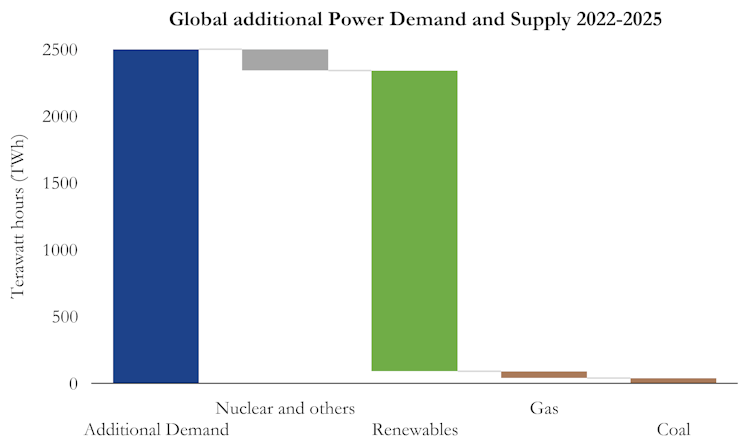
While the warnings in the UN’s stocktake should be heeded, the outlook is not entirely gloomy. According to the International Energy Agency (IEA) in a report from December 2022, virtually all new demand between now and 2025 will be satisfied by renewable energy. Wind and solar are expected to supply the bulk of this additional electricity, owing to their low cost and high availability.
With new wind and solar now cheaper than existing fossil fuel generation, it is only a matter of time before they fully replace all new energy demand first, and replace existing fossil fuels after – even in fast-growing economies. However, as the UN report shows, this process needs to be significantly sped up to avert catastrophic warming.

Don’t have time to read about climate change as much as you’d like?
Get a weekly roundup in your inbox instead. Every Wednesday, The Conversation’s environment editor writes Imagine, a short email that goes a little deeper into just one climate issue. Join the 20,000+ readers who’ve subscribed so far.![]()
Malte Jansen, Lecturer in Energy and Sustainability, University of Sussex
This article is republished from The Conversation under a Creative Commons license. Read the original article.
Here’s how to fix Australia’s approach to soil carbon credits so they really count towards our climate goals
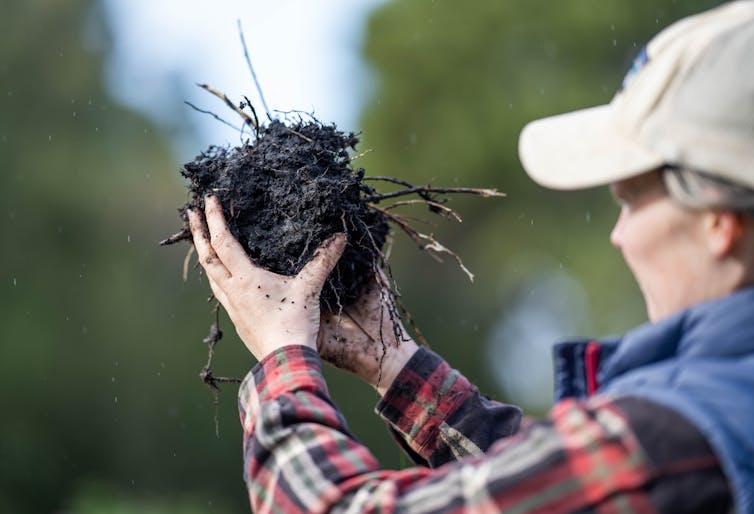
Australia’s plan to achieve net zero greenhouse gas emissions by 2050 relies heavily on carbon credits.
These credits are awarded to projects that avoid the release of greenhouse gases or remove and “sequester” (store) carbon so it’s no longer warming the atmosphere.
Farmers can be awarded credits for increasing soil carbon content. The federal government or companies can then purchase these credits to offset their carbon emissions.
These credits must represent genuine carbon sequestration if they are to mitigate climate change.
As Australian agricultural and soil scientists, we have serious concerns about the way credits are awarded for soil carbon sequestration under the Australian carbon credit unit scheme. There are four main issues with the method that must be addressed as a matter of urgency.
Understanding The Carbon Cycle
Much like water, carbon cycles through the environment, moving between plants, the earth and the atmosphere.
Plants take in carbon dioxide from the atmosphere as they grow. The carbon is stored in the plant tissue. When plants die, or drop leaves, this carbon-rich organic matter enters the soil. Then it decomposes, releasing carbon dioxide back into the atmosphere.
When carbon inputs from plants exceed losses from the decomposition of organic matter, the amount of soil carbon increases. That means soil organic carbon is more likely to increase during good seasons when there’s plenty of rainfall available to support plant growth – such as during the recent three-year period of consecutive La Niña events.
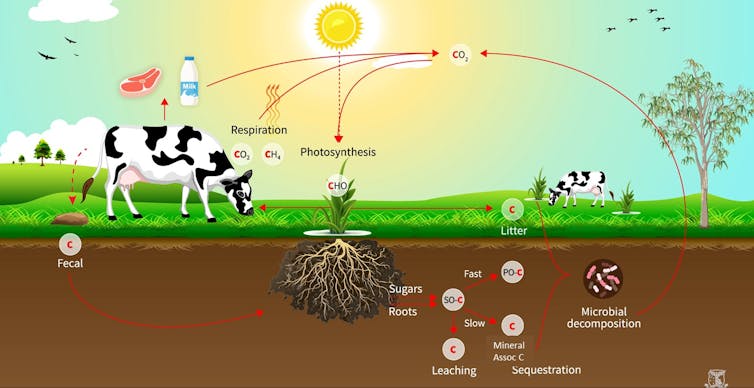
Increases Need To Be Due To Management
The recent tranche of credits awarded to soil carbon projects raises similar concerns to those that have been raised by experts about credits awarded to trees. Namely, carbon credits are being awarded for changes associated with seasonal conditions (changes that would have happened anyway) rather than human actions.
The current soil carbon method awards credits when an increase in soil organic carbon is detected between two points in time. This is problematic because it can award credits to projects that report increases during relatively wet periods.
This is the case for projects sampled in 2021, directly after a period where conditions were unusually favourable for plant growth. That means credits were awarded for sequestration that had more to do with the weather than good management.
Where crediting occurs due to seasonal conditions, the scheme is not providing any true (additional) climate change mitigation.
Soil Carbon Can Be Lost
Where soil carbon losses are greater than inputs, soil carbon stocks decline and sequestered carbon is released back to the atmosphere. The emissions can be rapid and considerable.
Furthermore, modelling indicates it’s likely soil carbon could be lost under the warmer and drier conditions of future climates.
Where a project loses soil carbon, the legislation does not require excess credits to be returned. Rather, a scheme-wide buffer generated from all sequestration projects covers such losses.
This approach is inequitable because all projects share the same burden of maintaining the buffer, irrespective of the risk of reversal of individual projects.
Overinflated Sequestration Rates
Based on a comprehensive global analysis, the number of carbon credits generated by some Australian projects appears unrealistically high. The most likely reason for these large values is high rainfall, but the way the method works makes it impossible to know for sure because the impacts of management are not identified.
This is not the first time a soil carbon project has made unrealistic claims.
In addition, one project saw 44% of the increase in soil carbon at depths below 30cm. This is an issue because published studies show soil carbon changes in deeper soil are relatively small and happen slowly. We are concerned the reported changes may have more to do with the way they were calculated.
Currently, data used to calculate credits are not released by the scheme regulator so cannot be scientifically verified. The release of data under strict non-disclosure arrangements would allow scientists to assess the implementation of the method. This would provide confidence credits generated represent real climate change mitigation.
Increased transparency was a key recommendation of the Chubb Review of Australian Carbon Credit Units in 2022.
Contributing To Our Emissions Targets?
Australia’s emissions are reported annually to the United Nations in the national greenhouse gas inventory. These annual inventories show progress towards our declared emissions reduction targets.
The current inventory method used to account for changes in soil carbon uses coarse regional-level statistics. Changes to practices at farm level, such as grazing management, are not detected and will not be reflected in our national greenhouse gas accounts. Further, Australia reports changes in soil carbon for the top 30cm of the soil only whereas carbon credits are also awarded for changes that occur deeper in the soil.
This means some soil carbon credits the Australian government purchases do not count toward our emissions targets. It calls into question the effectiveness of using taxpayer funds to purchase soil carbon credits as a policy tool.
Getting It Right
To address the issues we have identified, the measurement-based soil carbon method needs to be revised to only credit increases due to management. For instance, the Verra scheme in the international voluntary carbon market uses a method that minimises crediting for increases associated with rainfall.
To support revision of Australia’s scheme, scientists should be granted access to project data. Data could to be used to improve models in order to distinguish between climate and management effects. This would ensure the method is fit for purpose.
There also needs to be greater focus on monitoring changes in soil carbon. For a start, Australia’s Terrestrial Ecosystem Research Network should be extended to include agricultural land. This would provide data to increase transparency, independence and rigour of soil carbon estimates.
The revisions we propose would help ensure investment in carbon credits contributes to our national emissions reduction targets and addresses the urgent challenge of climate change.![]()
Aaron Simmons, Adjunct Senior Research Fellow, University of New England; Annette Cowie, Adjunct Professor, University of New England; Beverley Henry, Adjunct Associate Professor, Queensland University of Technology; Brian Wilson, Professor, University of New England; David Pannell, Director, Centre for Environmental Economics and Policy, The University of Western Australia; David Rowlings, Professor, Queensland University of Technology; Elaine Mitchell, Research Fellow, Queensland University of Technology; Matthew Tom Harrison, Associate Professor of Sustainable Agriculture, University of Tasmania; Peter Grace, Professor of Global Change, Queensland University of Technology; Raphael Viscarra Rossel, Professor of Soil & Landscape Science, Curtin University; Richard Eckard, Professor & Director, Primary Industries Climate Challenges Centre, The University of Melbourne, and Warwick Badgery, Research Leader Pastures an Rangelands, The University of Melbourne
This article is republished from The Conversation under a Creative Commons license. Read the original article.
SRC 2023 - Avalon Beach SLSC
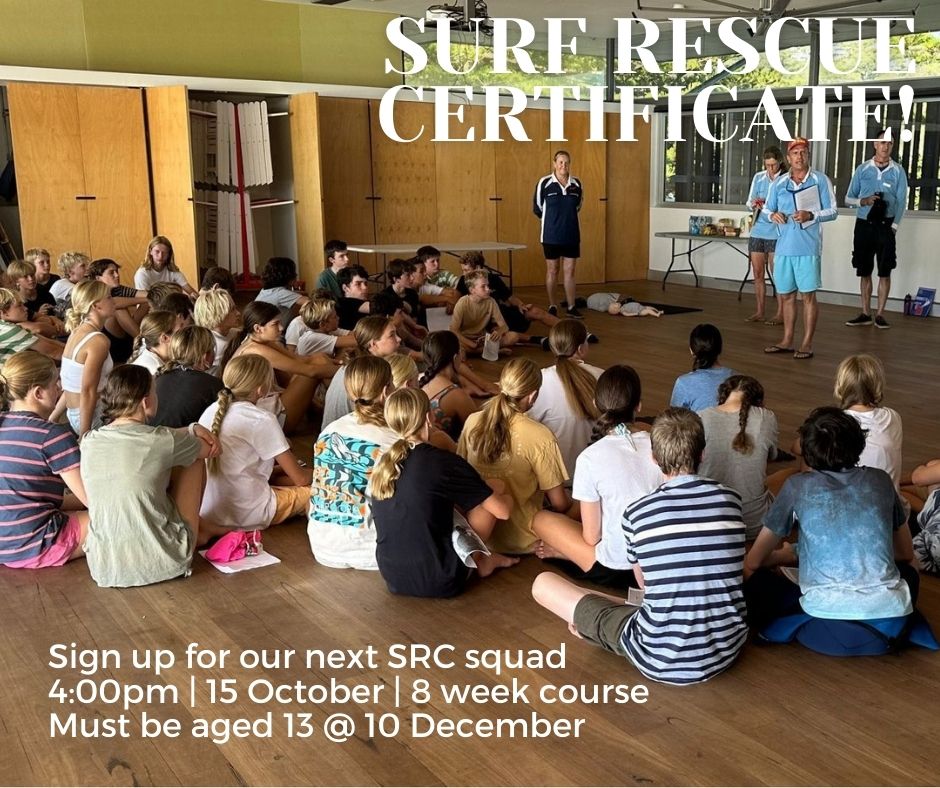
School Leavers Support
- Download or explore the SLIK here to help guide Your Career.
- School Leavers Information Kit (PDF 5.2MB).
- School Leavers Information Kit (DOCX 0.9MB).
- The SLIK has also been translated into additional languages.
- Download our information booklets if you are rural, regional and remote, Aboriginal or Torres Strait Islander, or living with disability.
- Support for Regional, Rural and Remote School Leavers (PDF 2MB).
- Support for Regional, Rural and Remote School Leavers (DOCX 0.9MB).
- Support for Aboriginal and/or Torres Strait Islander School Leavers (PDF 2MB).
- Support for Aboriginal and/or Torres Strait Islander School Leavers (DOCX 1.1MB).
- Support for School Leavers with Disability (PDF 2MB).
- Support for School Leavers with Disability (DOCX 0.9MB).
- Download the Parents and Guardian’s Guide for School Leavers, which summarises the resources and information available to help you explore all the education, training, and work options available to your young person.
School Leavers Information Service
- navigate the School Leavers Information Kit (SLIK),
- access and use the Your Career website and tools; and
- find relevant support services if needed.
Word Of The Week: Student
Noun
1. a person who is studying at a university or other place of higher education. 2. a school pupil. 3. denoting someone who is studying in order to enter a particular profession. 4. any person who studies, investigates, or examines thoughtfully.
From: late Middle English: from Latin student- ‘applying oneself to’, from the verb studere, related to studium ‘painstaking application’.
The word 'student' comes from the Latin 'student-em', present participle of 'studēre', to be eager, zealous, or diligent, to study. Variants in modern European languages today are on the noun 'estudiant'.
International Students' Day (17 November) remembers the anniversary of the 1939 Nazi storming of the University of Prague after student demonstrations against the German occupation of Czechoslovakia. Germans closed all Czech universities and colleges, sent over 1200 students to Nazi concentration camps, and had nine student leaders executed (on 17 November).
In late 1939 the Nazi authorities in the Protectorate of Bohemia and Moravia suppressed a demonstration in Prague held by students of the Medical Faculty of Charles University. The demonstration was held on 28 October to commemorate the anniversary of the independence of the Czechoslovak Republic (1918). During this demonstration the student Jan Opletal was shot, and later died from his injuries on 11 November. On 15 November his body was supposed to be transported from Prague to his home in Moravia. His funeral procession consisted of thousands of students, who turned the event into an anti-Nazi demonstration. However, the Nazi authorities took drastic measures in response, closing all Czech higher education institutions, arresting more than 1,200 students, who were then sent to concentration camps, executing nine students and professors without trial on 17 November. Historians speculate that the Nazis granted permission for the funeral procession already expecting a violent outcome, in order to use that as a pretext for closing down universities and purging anti-fascist dissidents.
The nine students and professors executed on 17 November in Prague were:
- Josef Matoušek (historian and associate professor; participated in the organisation of Opletal's funeral)
- Jaroslav Klíma (student of law; Chairman of the National Association of Czech Students in Bohemia and Moravia, requested the release of students arrested by the Gestapo during Opletal's funeral)
- Jan Weinert (student of Bohemistics and Germanistics; requested the release of students arrested by the Gestapo during Opletal's funeral)
- Josef Adamec (student of law; secretary of the National Association of Czech Students in Bohemia and Moravia)
- Jan Černý (student of medicine; requested the release of students arrested by the Gestapo during Opletal's funeral)
- Marek Frauwirth (student of economics; as an employee of the Slovak embassy in Prague, he was issuing false passports to Jews trying to flee from the Nazis)
- Bedřich Koula (student of law; secretary of the Association of Czech students in Bohemia)
- Václav Šafránek (student of architecture; record-keeper of the National Association of Czech Students in Bohemia and Moravia)
- František Skorkovský (student of law; Director of a Committee of the Confédération Internationale des Étudiants, Chairman of the Foreign Department of the National Association of Czech Students in Bohemia and Moravia)
This had been preceded by the Nazi Book Burnings of the 1930's.
The Nazi book burnings were a campaign conducted by the German Student Union (German: Deutsche Studentenschaft, DSt) to ceremonially burn books in Nazi Germany and Austria in the 1930s. The books targeted for burning were those viewed as being subversive or as representing ideologies opposed to Nazism. These included books written by Jewish, half-Jewish, communist, socialist, anarchist, liberal, pacifist, and sexologist authors among others. The initial books burned were those of Karl Marx and Karl Kautsky, but came to include very many authors, including Albert Einstein, Helen Keller, writers in French and English, and effectively any book incompatible with Nazi ideology. In a campaign of cultural genocide, books were also burned en masse by the Nazis in occupied territories, such as in Poland.
In his speech – which was broadcast on the radio – Goebbels' referred to the authors whose books were being burned as "Intellectual filth" and "Jewish asphalt literati".
On 10 May 1933, the students publicly hauled the library to the Bebelplatz square at the State Opera, and burned them along with volumes from elsewhere. A total of over 25,000 volumes of "un-German" books were burned, thereby ushering in an era of uncompromising state censorship.
Not all book burnings took place on 10 May as the German Student Union had planned. Some were postponed a few days because of rain.
Among the Nazi crimes against the Polish nation was a campaign of cultural genocide that included the burning of millions of books, resulting in the destruction of an estimated 80% of all school libraries, and three-quarters of all scientific libraries in the country.
Book burning in Berlin, 10 May 1933. Photo: United States Holocaust Memorial Museum
Not only German-speaking authors were burned, but also French authors such as Henri Barbusse, André Gide, Victor Hugo and Romain Rolland; American writers such as John Dos Passos, Theodore Dreiser, F. Scott Fitzgerald, Ernest Hemingway, Helen Keller, Jack London, Upton Sinclair, and Margaret Sanger; as well as British authors Joseph Conrad, Radclyffe Hall, Aldous Huxley, D. H. Lawrence, Henry de Vere Stacpoole, H. G. Wells, Irish authors James Joyce and Oscar Wilde; and Russian authors including Isaac Babel, Fyodor Dostoyevsky, Ilya Ehrenburg, Maxim Gorki, Vladimir Lenin, Vladimir Mayakovsky, Vladimir Nabokov, Leo Tolstoy, and Leon Trotsky.
The burning of the books represents a culmination of the persecution of those authors whose oral or written opinions were opposed to Nazi ideology. Many artists, writers and scientists were banned from working and publication. Their works could no longer be found in libraries or in the curricula of schools or universities. Some of them were driven to exile (such as Albert Einstein, Sigmund Freud, Magnus Hirschfeld, Walter Mehring, and Arnold Zweig); others were deprived of their citizenship (for example, Ernst Toller and Kurt Tucholsky) or forced into a self-imposed exile from society (e.g. Erich Kästner).
For other writers the Nazi persecutions ended in death. Some of them died in concentration camps, due to the consequences of the conditions of imprisonment, or were executed (like Carl von Ossietzky, Erich Mühsam, Gertrud Kolmar, Jakob van Hoddis, Paul Kornfeld, Arno Nadel, Georg Hermann, Theodor Wolff, Adam Kuckhoff, Friedrich Reck-Malleczewen, and Rudolf Hilferding).
Helen Keller published an "Open Letter to German Students", in which she wrote: "You may burn my books and the books of the best minds in Europe, but the ideas those books contain have passed through millions of channels and will go on."
On 10 May 1934, one year after the mass book burnings, the German Freedom Library founded by Alfred Kantorowicz was opened to assemble copies of the books that had been destroyed. Because of the shift in political power and the blatant control and censorship demonstrated by the Nazi Party, 1933 saw a “mass exodus of German writers, artists, and intellectuals". They went into exile in America, England, and France. On 10 May 1934, those writers in exile in France came together and established the Library of the Burned Books where all the works that had been banned, burned, censored, and destroyed were collected.
However, as history records, the worst for Germany, Europe, and those targeted by the Nazis was yet to come.
Alfred Kantorowicz, the author of the 1944 article 'Library of the Burned Books', was one of the key leaders instrumental in creating this library. In his article, he explains first-hand how the library came to be, and how it was finally destroyed. The library not only housed those books banned by the Nazis, the more important mission was to be the “center of intellectual anti-Nazi activities”. In addition, it had extensive archives “on the history of Nazism and the anti-Nazi fight in all its forms”. At the start of the war, the Nazis were virtually in control in France so the French government closed down the library and anyone associated was imprisoned or sent to concentration camps. Once the Nazis occupied Paris, the library and archives were turned over and that was the end of the Library.
In Kantorowicz's words, “the real significance of the Library was not confined to its material existence. When we inaugurated it, we wanted to make that day of shame a day of glory for literature and for freedom of thought which no tyrant could kill by fire. And furthermore, by this symbolic action, we wanted to awaken Europe to the dangers which threatened its spiritual as well as its material existence.”

The Empty Library at the Bebelplatz (former Opernplatz) in Berlin, designed by Micha Ullman. Photo courtesy Stefan Kemmerling
Charles University (Czech: Univerzita Karlova, UK; Latin: Universitas Carolina; German: Karls-Universität), also known as Charles University in Prague or historically as the University of Prague (Latin: Universitas Pragensis), is the oldest and largest university in the Czech Republic.
The establishment of a medieval university in Prague was inspired by Holy Roman Emperor Charles IV. He asked his friend and ally, Pope Clement VI, to do so. On 26 January 1347 the pope issued the bull establishing a university in Prague, modelled on the University of Paris, with the full (4) number of faculties, that is including a theological faculty. On 7 April 1348 Charles, the king of Bohemia, gave to the established university privileges and immunities from the secular power in a Golden Bull and on 14 January 1349 he repeated that as the King of the Romans. Most Czech sources since the 19th century—encyclopaedias, general histories, materials of the university itself—prefer to give 1348 as the year of the founding of the university, rather than 1347 or 1349. This was caused by an anticlerical shift in the 19th century, shared by both Czechs and Germans.

Faculty of Law, Charles University in Prague. Photo courtesy VitVit

Faculty of Arts (philosophy), Charles University in Prague. Photo courtesy VitVit
Of course, one of the earliest and most well-known 'students' was Plato. Plato (428/427 or 424/423 – 348 BC) was an ancient Greek philosopher born in Athens during the Classical period.
In Athens, Plato founded the Academy, a philosophical school where he taught the philosophical doctrines that would later become known as Platonism. Plato, or Platon, was a pen name derived, apparently, from the nickname given to him by his wrestling coach – allegedly a reference to his physical broadness. According to Alexander Polyhistor, quoted by Diogenes Laërtius, his actual name was Aristocles, son of Ariston, of the deme (suburb) Collytus, in Athens.
Plato was an innovator of the written dialogue and dialectic forms in philosophy. He raised problems for what became all the major areas of both theoretical philosophy and practical philosophy. His most famous contribution is the theory of forms (or ideas), which has been interpreted as advancing a solution to what is now known as the problem of universals. He is the namesake of Platonic love and the Platonic solids. His own most decisive philosophical influences are usually thought to have been, along with Socrates, the pre-Socratics Pythagoras, Heraclitus, and Parmenides.
Notable works: Euthyphro, Apology, Crito, Phaedo, Meno, Protagoras, Gorgias, Symposium, Phaedrus, Parmenides, Theaetetus, Republic, Timaeus and Laws.
Plato's thought is often compared with that of his most famous student, Aristotle, whose reputation during the Western Middle Ages so completely eclipsed that of Plato that the Scholastic philosophers referred to Aristotle as "the Philosopher". The only Platonic work known to western scholarship was Timaeus, until translations were made after the fall of Constantinople, which occurred during 1453.

Plato's Academy mosaic in the villa of T. Siminius Stephanus in Pompeii, around 100 BC to 100 CE. Photo courtesy Jebulon
Avoid cramming and don’t just highlight bits of text: how to help your memory when preparing for exams

With school and university exams looming, students will be thinking about how they can maximise their learning.
Memory is a key part of how we learn.
If students understand how memory works, they can prioritise effective study habits. This will help for exams as well as their learning in the longer term.
What Is Memory?
According to cognitive psychology (the study of our mental processes), there are three distinct types of memory. Each plays a different role in effective study:
sensory memory temporarily holds vast amounts of new information from our senses. This includes everything we have just seen, heard, touched or tasted. If we pay attention to that information, it moves into working memory for processing. If we don’t pay attention, it is discarded.
working memory is our brain’s control centre. All conscious cognitive activity, including remembering, calculating, planning, problem-solving, decision-making and critical thinking happens in our working memory. However, if we have too much on our minds, working memory can easily become overloaded. This makes it important to offload knowledge and skills to long-term memory.
long-term memory is our brain’s library. When new knowledge or skills are well practised, they are “encoded” from working memory and into long-term memory. Here they are stored in vast networks called schemas. To use those knowledge and skills again, we retrieve those schemas back into working memory. The more we encode and retrieve knowledge and skills, the stronger those memory pathways become. Well-learned schemas can be retrieved automatically, which creates space in working memory for new thinking and learning.
How To Help Your Memory When Preparing For Exams
Not everyone likes exams and educators often debate their advantages and disadvantages.
But if you are a student who is studying for exams right now, here are some tips to help you use your time well:
create the conditions for attention: put your phone away and remove distractions. Remember, your attention is needed to bring information into working memory and keep it there. Loss of attention, or mind wandering, can result in poorer learning. Harvard professor of psychology Dan Schachter calls absent-mindedness one of the “seven sins of memory”.
consider your subject area: different disciplines ask different kinds of questions and you should study with these in mind. In a Year 12 English exam, for example, you might be asked to write a response about your interpretation of a particular text. So don’t just re-read the text; effective study involves drawing out themes and insights, practising your arguments and seeking feedback.
minimise “shallow” study: most students report re-reading and highlighting text when studying. But these are less effective than other study techniques. Shallow study or encoding focuses more on surface features and less on meaning. This encourages rote recall over genuine understanding and leads to poorer learning. In one study, re-reading a textbook twice in a row offered no advantage over reading it for the first time.

maximise “deep” study: this involves actively using the information you are studying. Depending on your discipline, this might include answering practice questions, constructing your own questions, summarising, identifying themes, evaluating existing arguments, making decisions, or explaining concepts to others. This deep encoding results in stronger schematic networks, which are more easily reactivated when you need them.
move beyond worked examples: worked examples are step-by-step illustrations of the processes to solve a problem. They can be powerful starting points because they show you how to use a particular strategy. They also help to reduce working memory load. But as you become more expert, it is more effective to draw those strategies from long-term memory yourself.
take breaks: research with Australian university students shows even a five-minute rest break can support attention – the gateway to learning. Research using brain scans also shows rest can help you consolidate memories.
don’t cram: the so-called “spacing effect” shows memory and conceptual understanding both benefit from distributed rather than massed learning. This means six half-hour sessions are better for learning than one three hour block.

mix up your study: this could mean varying questions and activities, so your brain is forced to compare, contrast, refine, and draw distinctions between concepts and approaches. This is known as “interleaving”, and has been shown to boost learning in subjects such as maths, music and medicine.
don’t skip sleep: sleep is crucial for the consolidation of memory or solidifying new connections or insights you have made.
give yourself enough time: unfortunately, there are no shortcuts here! Each time you practise drawing specific knowledge and skills from long-term memory into working memory, you are etching a memory super-highway. The more you do this, the better and quicker you become – which is what you will need come exam time.

Penny Van Bergen, Head of School of Education and Professor of Educational Psychology, University of Wollongong
This article is republished from The Conversation under a Creative Commons license. Read the original article.
How to manage exam season: don’t forget to take regular breaks and breathe
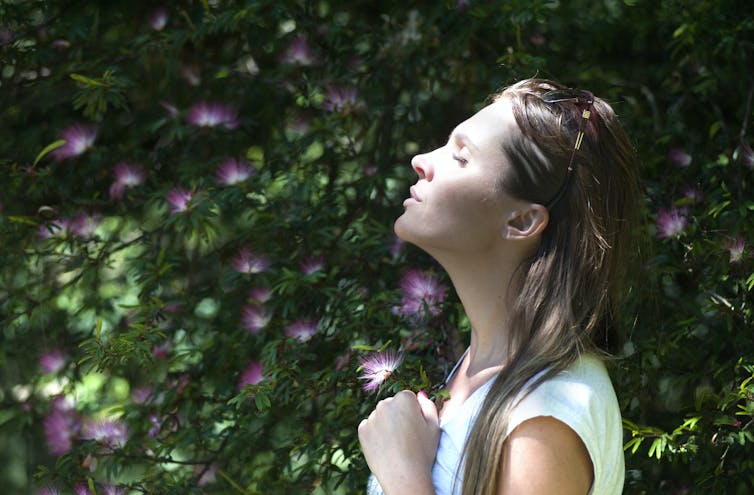
Around Australia, Year 12 students are heading into the final stretch of study before exams start in early term 4. This is typically seen as a very intense period of preparation. But, as our research shows, it is also important to rest during this time if you want to maximise your performance.
Intuitively, we understand breaks are important. We can take rest breaks across different times in our lives. They include sabbaticals, gap years and holidays, weekends and nightly sleep.
But rest breaks can be beneficial on even shorter time frames, during study sessions and even during exams themselves.
Firstly, Try And Get Some Sleep

Students may be tempted to stay up late, trying to cram for an exam the following day. The big risk here is that lack of sleep can do more harm than good.
Sleep plays an important role in a range of brain functions, including maintaining attention and consolidating memories. So getting a poor night of sleep before an exam may mean the topics you’ve tried to cram aren’t well-formed in your long-term memory. Even if they were, the brain fog from lack of sleep means you may not recall what you’ve learned under the pressure of exam conditions.
In the lead-up to your exams, here are some specific things to consider:
try and keep all screens out of the bedroom: people often struggle with sleep because they’re tempted to check their phone at bedtime.
screens also emit blue light: this can interfere with your body’s circadian rhythms. Blue light during the day enhances attention, but too much of it in the evening can interfere with sleep quality.
so don’t use a smartphone as an alarm: get an old-fashioned alarm clock instead.
For more information about sleep, the Sleep Health Foundation has specific advice for high school students.
You Need Study Breaks
When we study, we’re using our working memory (processing of small amounts of information, needed for things like comprehension and problem-solving). This builds our understanding of a topic. We then want to encode that understanding into long-term memory for use later, such as in an exam.
Without breaks, over time, these working memory resources become depleted and we notice it’s harder and harder to concentrate.
In our 2023 study, we found that a short (five minute) break following a period of difficult cognitive work (solving mental arithmetic problems) made a substantial difference to how much students learned during a lesson on a mental mathematics strategy.
Students who took a “do nothing” break performed 40% better than the no-break students on a subsequent test. Students who watched a first-person perspective video of a walk in an Australian rainforest for five minutes also performed better (57%) than the no-break students.
This suggests building in short rest breaks during study can help you learn.
How Do You Build In Breaks?
Here are some specific strategies to help you get the rests you need:
when you plan your study schedule build in short breaks: drawing on the Pomodoro time management technique, we recommend using a timer (but not one on a smartphone). Aim to take a five-minute break after 25 minutes of study.
again, don’t use a smartphone: many of the features of a phone are purpose-built to capture and keep your attention, which you need for studying! These short breaks could take many forms: getting a cup of tea, playing with a pet, getting some sun outside, doing some star jumps to wake yourself up, or some breathing exercises (I explain these below).
longer breaks are important too: following the Pomodoro technique, aim to take a longer break (15-30 minutes) after four rounds of 25 minutes study/five minutes rest. Use at least some of these longer breaks for your physical and mental health away from your desk (and screens) – such as exercise, meditation, or a 20-30-minute nap.

Also Take Breaks During Exams
It’s reasonable to think we should be using every minute of an exam for answering questions. But just as rest breaks during study can help restore attention, breaks during exams themselves may also be helpful.
Breaks are a common part of exams for students with disability provisions, but with some planning, all students might benefit from breaks.
A common strategy you can use to prepare for Year 12 exams is to complete past exam papers. When you do this, use the same “short break” study strategy described above. When it seems like a good break point (for example, in between finishing one section of the paper and starting another), stop for a few minutes and practise taking a short break.
Under exam conditions, you’re more limited in what type of break you can take. But simple controlled breathing routines such as “box breathing” or the “4-7-8 method” can help you refocus.
These routines can also activate the “relaxation response” – the opposite of the “flight-or-flight” response we experience under stressful conditions (including exams).
An even shorter form of breathwork to reduce stress in the moment is the physiological sigh – two inhales, followed by an exhale.
When it comes to the actual exam, you’ll be using the reading time to plan how you’ll complete the various sections. Take this time to also think carefully about when you’ll take some short breaks. When the exam begins, you might even write “take a two-minute break now” at suitable points in the exam booklet.
There is so much to think about in the lead-up to and during exams. If you schedule in and practise taking breaks, you will get better at doing it and give yourself and your brain a really important rest. ![]()
Paul Ginns, Associate Professor in Educational Psychology, University of Sydney
This article is republished from The Conversation under a Creative Commons license. Read the original article.
Patrick White was the first Australian writer to win the Nobel Prize in Literature – 50 years later, is he still being read?

Did you know that 2023 marks the 50th anniversary of Patrick White winning the Nobel Prize in Literature, the first Australian writer to be so honoured?
Until last week, neither did I. Nor did many of my fellow academics. As a lover of White’s writing, I was shocked by my own lack of awareness, which was quickly overshadowed by the realisation that seemingly everyone had overlooked it. Surely someone must have commented?
As far as I have been able to find, there has been one article back in autumn by Barnaby Smith in the NSW State Library’s magazine Openbook and few Twitter posts similarly aghast at the neglect.
By contrast, you are more than likely aware that this October marks the 50th anniversary of the Sydney Opera House, officially opened by Queen Elizabeth II two days after the announcement of White’s award. As David Marr recounts in his biography of White, when the photographers crowding around White’s house were asked if they could come back in the morning, they replied: “We have to do the Queen in the morning.”
Cultural Cringe
When I first began thinking about writing this piece, I was motivated by a sense of frustration that White – and Australian literature more generally – was again being neglected.
My first thought could be summarised as follows: “How dare they forget him! There should have been conferences and celebrations – a festival that would leave the Opera House in the dust! Imagine the furore if Ireland had forgotten Beckett’s 50th anniversary in 2019! What a contemptuous place this is that can neglect an important occasion for one of its greatest writers!”
Previous anniversaries had received significant attention. The 50th anniversary of White’s best-known novel Voss in 2007 was marked with a two-day symposium. The centenary of his birth in 2012 was likewise acknowledged with conferences in Australia and various international locations.
What was different about this anniversary?

Despite my anger, should I really have been that surprised? Last semester, I had quizzed my first year Literary Studies students to see if anyone knew who our first Nobel laureate in literature was.
Silence.
When I told them, no one had heard of Patrick White, let alone read him.
The same goes for Miles Franklin (both the author and the prize), Christina Stead and Joseph Furphy, just to name the canonical writers I thought they might have known. Henry Lawson and Banjo Paterson were the only two to receive a reprieve.
Contemporary Australian authors didn’t fare much better. When I asked them why they didn’t read much Australian literature, the most frequent answer – usually tempered with laughter – was: “Well, I guess it’s just not very good, is it?”
Here is the opportune time to introduce the impossible to avoid concept of the “cultural cringe”, the term coined by A.A. Phillips in 1950. The cringe, Phillips wrote,
mainly appears in an inability to escape needless comparisons. The Australian reader, more or less consciously, hedges and hesitates, asking himself ‘Yes, but what would a cultivated Englishman think of this?’
When it comes to White’s reception, especially post-Nobel, the cringe is everywhere apparent. It was fostered by the prize citation itself. For the Nobel committee, White was worthy of the prize because he had created an “epic and psychological narrative art which has introduced a new continent into literature”.
As many people have highlighted, White’s Nobel was a watershed moment of international recognition for Australian literature. It would be followed by Thomas Keneally winning the Booker Prize in 1982 for Schindler’s Ark and Peter Carey winning of the same award in 1988 for Oscar and Lucinda.
Here were signs, at last, that Australians could produce real literature – at least, according to Europe and Britain.
A Writer Unread?
White’s relationship to Australian literature was always shaky, if not outright venomous. He infamously chastised mainstream Australian writing as little more than the “dreary dun-coloured offspring of journalistic realism”.
Many Australian readers were happy to return the favour. His local critical reception was often uncomprehending, and at times hostile. A.D. Hope’s similarly infamous review of The Tree of Man judged the novel to be “pretentious and illiterate verbal sludge”.
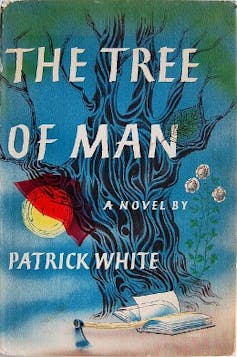
White’s uneven reception reflected an anxiety about what Australian literature actually was. This is still a live issue in literary studies. The preeminent questions asked in undergraduate Australian literature units are still: What is Australian literature? What counts as Australian literature? What is the writer’s relationship to the “nation”?
But these questions are today asked within the context of ever-diminishing Australian literature programs at universities, where you will be lucky to find one that offers more than one unit about it, and sometimes not even that. On these grounds, one could easily conclude that White’s star has diminished. Madeleine Watts, in her 2019 article, appropriately titled On Patrick White, Australia’s Great Unread Novelist, would certainly agree.
Christos Tsiolkas makes a similar argument in his 2018 book on White for Black Inc.’s “Writers on Writers” series. He reflects that his desire to write the book emerged out of a “sense of pissed-offness” at not having been made to engage with White earlier by “my tutors, my fellow writers and our critics”.
That Watts and Tsiolkas are both novelists themselves might explain their fervour for White, a writer who fits well under the moniker a “writer’s writer”. And yet White’s reputation has always been tied up with the myth of him being a great “unread” novelist. Watts herself quotes a letter White wrote in 1981, in the last decade of his life, in which he declared:
I’m a dated novelist, whom hardly anyone reads, or if they do, most of them don’t understand what I am on about.
This is not even close to the only time White voiced such frustrations. They are littered throughout his letters and documented in David Marr’s biography. Equally, one of the clichéd tenets of White scholarship has been an attempt to figure out whether we should continue to read him or not – as if this were really the fundamental question on everyone’s mind.

So many of our contemporary discussions about literature – when we remember to have them – constellate around issues that are really at the service of generating discourse about “literature”, rather than genuine criticism and engagement with its artistic qualities.
I’m drawn to these debates as much as anyone. The questions of why literature matters and what makes it meaningful should be discussed frequently. They are some of the most interesting questions we can ask. But the problem with these discussions, and the perpetual crisis of the humanities and literature that we hear about so much, is that they distract us from what is actually meaningful about literature: reading it.
Reputation
When I set out to the write this piece, I wanted to follow through on my anger. I wanted to claim that it was a scandal White had been forgotten by our cultural institutions, that it was a sign of our degraded cultural state. But the more I have thought about it, the more I have been drawn to the idea that maybe, just maybe, this is the best thing that could happen to White and Australian literary culture more broadly.
Ever since he won the Nobel prize, White has been unable to escape the institutional framing of his work, whether he is being critiqued negatively or positively. The question that is asked of White is not just “should we read him”, but should we study him. He has been bound up in cultural debates that may never cease.
White’s reputation as a canonical writer, and more specifically as a “difficult” modernist author and a “writer’s writer”, is a disaster when it comes to getting people, including students, to actually read him. He is not only the kind of writer one would expect to study at school and university; many people assume he can only be read in those contexts.
Of course, White is a difficult writer, though it is often overlooked that he can also be funny, especially in his depictions of suburbia. A favourite scene is this one in The Cockatoos, describing an existential choice familiar to every Australian:
Olive Davoren fell asleep, a pillow-end between shoulder and cheek, like a violin.
She had noticed seed at Woolworths and Coles; it was only a matter of choosing.
One of the birds was pecking at her womb. He rejected it as though finding a husk.
What has never been in doubt is the beauty and sensuality of White’s writing. When reading him, I often feel like Laura Trevelyan in Voss, listening to the eponymous German explorer:
She did not raise her head for those the German spoke, but heard them fall, and loved their shape. So far departed from the rational level to which she had determined to adhere, her own thoughts were grown obscure, even natural. She did not care. It was lovely. She would have liked to sit upon a rock and listen to words, not of any man, but detached, mysterious, poetic words that she alone would interpret through some sense inherited from sleep. Herself disembodied. Air joining air experiences a voluptuousness no less intense because imperceptible.

The more we can learn to read White in this spirit – absolving our rational forms of scholarly detachment, just a bit – the more we might be able to read him as it has always been possible to read him: listening to the shape of his words, their voluptuousness.
Imagine, perverse as this may sound, if White never won the Nobel prize? Could it be possible that the reading of his work would be in a better place today? At the very least, we wouldn’t have nearly as much of the “pretentious and illiterate verbal sludge” – to borrow a phrase – that is obsessed with the discourse around White, rather than his actual works.
Literary prizes, as Beth Driscoll has highlighted, have become an essential part of literary culture. They provide many benefits for winning writers. The domestic and international sales of White’s books greatly increased in the years after he won the Nobel. If he had never won, it’s perfectly conceivable that his work would now be out-of-print.
But the aura of a prize shines briefly. Sometimes it might fade after a week, a year, sometimes 50. But it will fade. What remains is the work itself.
Immediately after the Nobel Prize announcement in 1973, White was interviewed on television by Mike Carlton. Asked whether the prize was a “crowning achievement”, White responded:
I hope my books are the crowning achievement of my career, not awards. But perhaps that is vain.
Vain or not, it would seem, maybe until now, that the award has been the crowning achievement. In light of the neglect of its 50th anniversary, maybe we can start to read White again – read him as aesthetically-minded individuals, not as institutions.![]()
Reuben Mackey, Sessional teacher and PhD Candidate, Literary Studies, Monash University
This article is republished from The Conversation under a Creative Commons license. Read the original article.
Should you charge your phone overnight? Will ‘overcharging’ make it explode? Common battery myths debunked

In the world of lithium-ion batteries, smartphones take centre stage. Yet they’ve also sparked an ongoing debate: does prolonged (or overnight) charging wreak havoc on your battery?
A number of factors determine a phone battery’s lifespan, including its manufacturing age and its chemical age. The latter refers to the battery’s gradual degradation due to variables such as fluctuations in temperature, charging and discharging patterns and overall usage.
Over time, the chemical ageing of lithium-ion batteries reduces charge capacity, battery lifespan and performance.
According to Apple:
A normal [iPhone] battery is designed to retain up to 80% of its original capacity at 500 complete charge cycles when operating under normal conditions.
Research has found a 2019 smartphone battery could, on average, undergo 850 full charge/discharge cycles before dropping to below 80% capacity. This means only 80% of the initial battery capacity remains after about two to three years of use. At this point the battery begins to deplete noticeably faster.
Should You Charge Your Phone Overnight?
Most new-generation smartphones will take somewhere between 30 minutes and two hours to charge fully.
Charging times vary depending on your device’s battery capacity – larger capacities require more time – as well as how much power your charger supplies.
Charging your phone overnight is not only unnecessary, it also accelerates battery ageing. Full charging cycles (going from 0%–100%) should be avoided to maximise your battery’s lifespan.
Samsung says:
charging your battery up to 100% too frequently may negatively impact the overall lifespan of the battery.
Similarly, keeping iPhones at full charge for extended periods may compromise their battery health.
Rather than a full top-up, it’s recommended to charge your battery up to 80% and not allow it to dip under 20%.
Can Your Phone Be Overcharged?
In theory, lithium-ion batteries can be overcharged. This can lead to safety risks such as the battery overheating and catching fire. The good news is most modern phones have an in-built protection that automatically stops the battery from charging further than 100% – preventing any damage from overcharging.
However, each time a battery drops to 99% (due to apps running in the background) it will “trickle charge”: it will start charging again to maintain a fully charged state.
Trickle charging can wear a battery down over time. That’s why many manufacturers have features to regulate it. Apple’s iPhones offer functionality to delay charging past 80%. Samsung’s Galaxy phones provide the option to cap the charge at 85%.
Can Your Phone Explode From Charging?
It’s very unlikely your smartphone will explode as a result of charging – especially since most phones now have automatic protections against overcharging.
Still, over the years we have seen several reports of phones exploding unexpectedly. This usually happens as a result of manufacturing faults, poor-quality hardware or physical damage.
Lithium-ion phone batteries overheat when the heat generated during charging is unable to dissipate. This may cause burns or, in extreme cases, lead to a fire.
Also, these batteries operate effectively within a temperature range of 0℃ to 40℃. They may expand at higher ambient temperatures, potentially causing a fire or explosion.
Using an incorrect, faulty or poor-quality charger or cable can also lead to overheating, fire hazards and damage to the phone itself.
Tips To Enhance Your Battery’s Lifespan
Although your phone probably has in-built safety mechanisms to protect its battery, taking a cautious approach will make it last even longer. Here are some ways to protect your phone’s battery:
install the latest software updates to keep your phone up-to-date with the manufacturer’s battery efficiency enhancements
use original or certified power chargers, as the power delivery (amps, volts and watts) in off-market chargers can differ and may not meet the required safety standards
avoid exposing your phone to high temperatures – Apple and Samsung say their phones work best at 0℃ to 35℃ ambient temperatures
limit your charging to 80% of the full capacity and don’t let it dip below 20%
don’t leave your phone charging for an extended period, such as overnight, and disconnect it from the power source if the battery reaches 100%
keep your phone in a well-ventilated area while it’s charging and avoid placing it or the charger under a blanket, pillow or your body while it’s connected to a power source
monitor your battery health and use to identify unusual trends, such as taking an excessive time to charge, or rapid draining
if you notice your phone is heating up excessively, or has a bulging or swollen back, get an authorised service centre to check and repair it.
If you want specific details about your particular phone and battery, the best option is to follow the manufacturer’s guidelines.![]()
Ritesh Chugh, Associate Professor - Information and Communications Technology, CQUniversity Australia
This article is republished from The Conversation under a Creative Commons license. Read the original article.
From glowing cats to wombats, fluorescent mammals are much more common than you’d think
Kenny Travouillon, Western Australian Museum; Christine Elizabeth Cooper, Curtin University; Jemmy Bouzin, Curtin University; Linette Umbrello, Queensland University of Technology, and Simon Lewis, Curtin UniversityRecently, several mammals have been reported to “glow” under ultraviolet (UV) light, including our beloved platypus. But no one knew how common it was among mammals until now.
Our research, published in Royal Society Open Science today, found this glow – known as fluorescence – is extremely common. Almost every mammal we studied showed some form of fluorescence.
We also examined the glow to determine if it was really fluorescence and not some other phenomenon. Then, we tested if the fluorescence we observed in museum specimens was natural and not caused by preservation methods.
We also searched for links between the type and degree of fluorescence and the lifestyle of each species, to gain insights on whether there are any benefits to glowing under UV if you’re a mammal.
Nightclub Lights
Nightclub visitors will be familiar with white clothes, or perhaps their gin and tonic, glowing blue under UV light. This is a great example of fluorescence – when the energy from UV light, which is a form of electromagnetic radiation invisible to humans, is absorbed by certain chemicals.
These chemicals then emit visible light, which is lower-energy electromagnetic radiation. In the case of gin and tonic, this is due to the presence of the quinine molecule in the tonic water.
In the case of animals, this can be due to proteins or pigments in their scales, skin or fur. Fluorescence is quite common among animals. It has been reported for birds, reptiles, amphibians, fish, corals, molluscs and most famously scorpions and other arthropods.
However, it has been described less frequently in mammals, although recent studies have provided several examples. We already knew that bones and teeth glow with fluorescence, as do white human hair and nails. Some rodents have a pink glow under UV light and platypuses glow blue-green.

How Often Do Mammals Glow?
Our team came together because we were curious about fluorescence in mammals. We wanted to know if the glow reported recently for various species was really fluorescence, and how widespread this phenomenon was. We obtained preserved and frozen specimens from museums and wildlife parks to study.
We started with the platypus to see if we could replicate the previously reported fluorescence. We photographed preserved and frozen platypus specimens under UV light and observed a fluorescent (although rather faint) glow.
To make sure it was fluorescence and not some other effect that looked like it, we used a technique called fluorescence spectroscopy.
This involved shining various sources of light at the samples and recording the specific “fingerprints” of the resulting glow, known as an emission spectrum. This way, we could confirm what we saw was indeed fluorescence.
We repeated this process for other mammals and found clear evidence of fluorescence in the white fur, spines and even skin and nails of koalas, Tasmanian devils, short-beaked echidnas, southern hairy-nosed wombats, quendas (bandicoots), greater bilbies and even cats.
Both fresh-frozen and chemically treated museum specimens were fluorescent. This meant it wasn’t preservation chemicals such as borax or arsenic causing the fluorescence. So, we concluded this was a real biological phenomenon.
Mammals In Dazzling Lights
Using specimens from the Western Australian Museum’s collection, we took the experiment to the next stage. We recorded every species of mammal that was fluorescent when we exposed the specimens to UV light.
As a result, we found 125 fluorescent species of mammal, representing all known orders. Fluorescence is clearly common and widely distributed among mammals.
In particular, we noticed that white and light-coloured fur is fluorescent, with dark pigmentation preventing fluorescence. For example, a zebra’s white stripes fluoresced while the dark stripes didn’t.
We then used our dataset to test if fluorescence might be more common in nocturnal species. To do this, we correlated the total area of fluorescence with ecological traits such as nocturnality, diet and locomotion.
Nocturnal mammals were indeed more fluorescent, while aquatic species were less fluorescent than those that burrowed, lived in trees, or on land.
Based on our results, we think fluorescence is very common in mammals. In fact, it is likely the default status of hair unless it is heavily pigmented. This doesn’t mean fluorescence has a biological function – it may just be an artefact of the structural properties of unpigmented hair.
However, we suggest florescence may be important for brightening pale-coloured parts of animals that are used as visual signals. This could improve their visibility, especially in poor light – just like the fluorescent optical brighteners that are added to white paper and clothing.![]()
Kenny Travouillon, Curator of Mammals, Western Australian Museum; Christine Elizabeth Cooper, Senior Lecturer, Curtin University; Jemmy Bouzin, PhD candidate, Curtin University; Linette Umbrello, Postdoctoral research associate, Queensland University of Technology, and Simon Lewis, Professor of Forensic and Analytical Chemistry, Curtin University
This article is republished from The Conversation under a Creative Commons license. Read the original article.
The social lives of kangaroos are more complex than we thought

Have you ever wondered what a kangaroo’s social life looks like? Well, kangaroos have stronger bonds to one another than you might think.
Over six years, we monitored a population of around 130 eastern grey kangaroos near Wollar in New South Wales to see how their relationships changed over time. Keeping tabs on individual roos led to some surprising results.
We found that kangaroo mothers become more social when caring for joeys (which is the opposite of what we previously thought). We also uncovered new evidence that indicates kangaroos could potentially form long-term relationships.
This research, published in Animal Behaviour, sheds new light on the behaviour of Australia’s most iconic animal.
How To Watch Kangaroos
Eastern grey kangaroos (Macropus giganteus) are found throughout the eastern third of Australia, and they are extremely social animals.
If you’re lucky enough to have some living near you, you’ll notice they are rarely alone. What you might not notice is how often their small groups (called mobs) fluctuate throughout the day.
Kangaroos have a loose “fission–fusion” social structure, which means mobs often split and reform. Knowing this, we wanted to see just how strong kangaroo relationships actually are, and how these relationships changed over several years.

To find out, we spent a few days each year taking photographs of every single kangaroo in our study population. We then used these photographs (all 3,546 of them!) to individually identify each kangaroo.
The best way to tell kangaroos apart (for humans) is the unique shape of their ears, because both the outline of the ears and the inner ear tufts remain very similar throughout the years. New scars can change the overall ear shape, but we were careful to watch out for those.
Using this method, we identified 130 individual kangaroos. We then looked at which kangaroos appeared next to each other in the same photograph to get an idea of what their social groups looked like.
We also gave each kangaroo a social score based on how many other kangaroos they associated with and how “popular” these associates were.
Suprising Sociability
There are usually a couple of difficulties in this sort of long-term animal study, such as identifying individual animals and being able to follow the same population over several years. These problems are easily avoided with kangaroos, as our photographic survey let us identify animals without invasive tagging, and they tend to return to the same place every day.
We could easily look at the short-term and long-term relationships of each kangaroo, as well as how these relationships varied with sex, age and reproduction.
Looking at sociability on an individual level produced some surprising results.
We discovered some kangaroos were just more social than others. In some this was consistent, and in others it changed from year to year.
In fact, we found female kangaroos tended to be much more social in years when they had joeys. This is quite different from earlier research, which suggested kangaroos actually tend to isolate from the rest of the population when they become mothers.
What we think is happening here is that, while mothers tend to spend time in smaller groups (which is what other studies have shown), those groups change often. As a result, mothers associate with more other kangaroos in total – which would account for their high social scores.
So kangaroos’ loose social structure allows them to adjust their sociability with their reproductive state.
Long-Term Friendships?
However, the fact the social structure is loose doesn’t mean it is simple. We found kangaroo relationships might be far more complex than previously thought.
Some of our kangaroos maintained friendships across multiple years, a phenomenon that was particularly common among females. Kangaroos that were more “popular” – as determined by the social score we calculated – were far more likely to have these friendships.

This is the first evidence for long-term relationships in macropods (the animal family that includes kangaroos as well as wallabies, quokkas and others). However, long-term relationships are common in other large, social herbivores such as elephants, giraffes and ibex.
We only looked at the kangaroos for a short time each year. To find out whether they really do form long-term relationships, we will need to do more research. However, we have shown such relationships are a possibility, which is itself a very exciting development in the study of kangaroo behaviour.
The Importance Of Social Organisation
So what’s next? The study of animal behaviour is constantly changing and there’s always lots more we can learn.
We have shown the benefits of looking at animal populations on an individual level, not just a species level. With this in mind, future research should investigate the existence of long-term relationships in kangaroos, as well as why female kangaroos might deliberately increase their sociability when they become mothers.
We often underestimate the importance of social organisation in animals. Further research into kangaroo behaviour can help us better appreciate the intelligence and social complexity of our favourite marsupials.![]()
Nora Campbell, PhD Candidate, UNSW Sydney
This article is republished from The Conversation under a Creative Commons license. Read the original article.
Explainer: the philosophy of Jean-Jacques Rousseau is profoundly contemporary

By any reckoning, Jean-Jacques Rousseau (1712-1778) is one of the most influential Western philosophers in history. No account of the modern era – not just modern thought – could ignore him. Few courses in political or social theory would think to omit him.
It is therefore worth coming to grips with his thought and its legacy. But like any major thinker, there are risks in summaries – some of which give us clues about Rousseau himself.
Although he is known as a social and political philosopher, Rousseau’s creative output does not resemble that of a contemporary “theorist”. He was not only a writer of treatises, but fiction, autobiographical works (such as Confessions and Reveries of a Solitary Walker) and musical compositions, including seven operas, some of which were notable enough to be acknowledged by composers like Gluck and Mozart.
But there is another, stranger difficulty in summarising Rousseau’s thought. It is not that his work is alien and distant to us, as might be the case with certain other thinkers. It is that his ideas reflect many of our own deepest commitments and patterns of thought. They are as close to us as the clichés heard on reality television shows and the bromides on offer in certain kinds of self-help books. They are the common coin of much political rhetoric.
It has been my experience in teaching philosophy and social theory over many years that where Plato can come across as unbearably strange, Descartes as either glib or insane, large parts of Rousseau will often strike students as mere common sense.
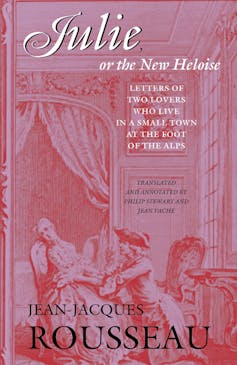
Rousseau’s epistolary novel, Julie, or the New Héloïse (1761), reads clunkily these days. For most modern readers, its story of a doomed love affair between an aristocrat and her tutor is too mawkish, sentimental and melodramatic.
Yet its themes are profoundly contemporary. It suggests that authenticity should take precedence over what is expected of us by convention, that the dictates of tradition only make sense if they gel with our “inner truths” – with who we feel ourselves to be as individuals. These are now conventional tropes, but they were only emerging at the time Rousseau was writing.
Natural Or Artificial
To say the novel struck a chord would be to seriously understate matters. Julie was likely the biggest-selling novel of the 18th century. People were so moved by it that they wrote to Rousseau en masse. A vast number of correspondents were women proposing marriage.
Others, as the historian Robert Darnton has pointed out, were merely overwhelmed:
The novel drove J.-F. Bastide to his bed and nearly drove him mad, or so he believed, while it produced the opposite effect on Daniel Roguin, who sobbed so violently that he cured himself of a severe cold. The baron de La Sarraz declared that the only way to read the book was behind locked doors, so that one could weep at one’s ease, without being interrupted by the servants.
Rousseau had shot to fame a decade earlier, after winning an essay competition advertised in the literary magazine Mercure de France. Held by the Academy of Dijon, the competition asked entrants to write an essay in response to the question: “Has the restoration of the sciences and arts contributed to the purification of morals?”
Put another way, the question asked: does moral progress go hand in hand with progress in the arts and sciences?
The question was posed at a time when the answer seemed obvious. The mood of the period was one of extraordinary optimism about human progress. Figures such as Diderot, Voltaire and Montesquieu shared a belief that the world had reached the age of Enlightenment and that future development was unlimited. As such, the expected answer was: “Yes, of course!”
Rousseau instead answered: “No, not at all – quite the opposite.” He argued that progress in the arts and sciences had actually led us away from moral progress, and he offered philosophical and historical reasons to think this true.
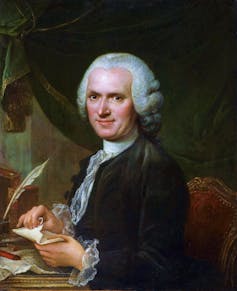
Part of his method was to introduce and sharpen a distinction that has become integral to the thought of all subsequent eras. Where much philosophical discussion had been centred around the distinction between the “natural” and the “supernatural”, Rousseau opposed the natural to the artificial.
He argued that what we ordinarily think of as civilisational progress creates – and then aims to satisfy – new and artificial vices, serving our vanity and not our natural needs. For example, where the “natural man” (homme naturel) gets thirsty and needs water, the “artificial” man (homme artificiel) thinks he needs “designer water” curated by a “water sommelier” and served on a silver tray.
Rousseau thought no good argument could be made that the rural Swiss or Native Americans possessed less virtue or happiness than the most civilised Europeans. In fact, he proposed there were many good reasons to think they were greater in both.
Society And Inequality
Developing these ideas, in 1754, Rousseau wrote his Discourse on the Origin and Basis of Inequality Among Men. In it, he attempted a thought experiment which imagined what humans may have been like in a “pre-civilisational” state.
Rousseau was aware that this act of imagination was speculative and he could not be sure of its results. But his focus was not historical: he wanted to see if he could, hypothetically, strip away the accretions of civilisation to see what a human being was in its most basic mode.
Humans, he thought, were fundamentally solitary creatures, most at home alone or in small groups. He suggested that “natural man” would come together with others sometimes, but would soon part ways, so issues like envy or resentment would rarely arise.
For Rousseau, natural inequalities would have no serious consequences in the state of nature. For instance, if you spent time with someone who was stronger than you, intimidated you, bossed you around and stole your food, you would simply wait until they were asleep and leave.
Rousseau hypothesised that some historical tragedy, perhaps a natural catastrophe, had prompted human beings to create “societies”. That particular form of social organisation proved permanent, pushing away all other modes of being, other natural forms of human sociality.
When people formed societies they acquired certain comforts, but created a host of problems. Rousseau claimed that everyone was born free and equal, but societies imposed a sense of ownership over resources and divisions of labour, which caused conflict and social injustice. He held that inequality was artificial. And yet once inequalities arose, arbitrary power maintained them and artificial man naturalised them, making them seem like reflections of nature.
Our artificial needs thus became the centre of our lives. We gradually required not just shelter but the best house on the block, not just food but cuisine. Such an existence has bred mutual alienation between people. Only in the bustling metropolitan streets of Paris or London would a person simply step over someone who is destitute.
Education And Politics
What was the solution to this sorry state of affairs? For Rousseau, there were two main remedies to the debasement of our nature. The first was the institution of a new kind of education; the second was reorienting politics towards a new moral foundation.
In Émile, or On Education (1862), Rousseau wrote a treatise on education in the form of a bildungsroman – the first and likely the last of its kind. He sought to outline the conditions of a good education, which he thought should be based on lived experience and the development of individual character, not rote learning, mechanical memorisation, or even the reading of books. (He makes a lone exception for Robinson Crusoe, which he did think students should read.)
As for moral education, young people should learn about the consequences of their actions. What would be the punishment for a child breaking a window? They should be made to sleep in a cold room.
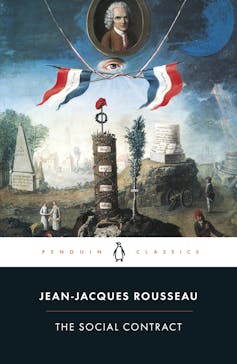
The second means by which Rousseau thought we could rediscover natural man was through the social contract, in which people would voluntarily cede some of their freedom to a sovereign power who expressed the “general will”. This general will is the sole source of the state’s sovereign authority.
This is a paradigmatic form of democratic theory, but Rousseau did not see it as merely this. He thought that this particular mode of government might help to make citizens moral, to move them beyond mere self-seeking. For Rousseau, the social contract entails the idea that one can only pursue one’s own happiness by pursuing everyone else’s. In this sense, government would function the way a cooperative corporation might: individual efforts lead to everyone’s gain; selfishness produces gains for nobody, including the self-seeker.
Rousseau’s ideas were a significant departure from the political and social theories that were popular at the time. His emphasis on the value of individual freedom and equality, and the government’s duty in preserving these principles, contributed to many developments – theoretical and practical – in the modern world.
The French and American Revolutions and the advancement of modern political philosophy were significantly influenced by his work. In his most significant works, he demolished the notion that monarchies were divinely appointed. He proposed the revolutionary idea that the people alone have the true right to govern. These ideas helped to end the centuries-old relationship between church, crown and country. They laid the groundwork for classic republicanism: a system of mixed governance based on the principles of civil society and citizenship.
Rousseau’s terminology has oriented discussions of morality, self-development and politics from the 18th century to the counterculture of the 1960s, the New Age movement of the 1980s, and beyond. We see traces – and sometimes more – of Rousseau in the celebration of the simple and the “primitive” (including the racist legacies of such misconstrued faint praise).
His legacy also continues in those currents of thought which see culture as decadent, and which see the solution to this in getting in touch with nature, our own inner natures, and in following our own paths. He has some claim to be the inspiration of parts of “child-centred education”, of what became known in some circles as “progressivism”. Without Rousseau, it is hard to imagine the existence of Steiner and Montessori Schools.
Deism And Human Nature
While it is true Rousseau was – in his early career at least – a celebrity intellectual, he was also the target of much criticism, and even persecution.
He was a close friend of many atheist philosophers, but a fierce critic of them. He was, equally, a trenchant critic of revealed religions. The God of revealed religion was a God of vengeance, intolerance and petty vice, revealed to some and not others merely by virtue of an accident of birth. Rousseau thought no God worthy of the name would reveal itself in such outrageous and contradictory ways.
The term “deism” has come to refer to a kind of impersonal, detached creator, but Rousseau’s deist God was nothing of the sort. According to Rousseau, we know what we know of God from Nature and Reason alone. Thus religion itself had become, like many civilisational developments, one of the great corruptors of humanity.
Rousseau was ridiculed by atheists for his religious views and by orthodox Christians for his critique of revealed religion, but the views he espoused have become a standard “secular” creed, perpetuated by people who claim to be “spiritual but not religious.”
Many have questioned Rousseau’s conception of human nature, thinking it wrong or overly idealistic – or at least very partial. What evidence is there, critics ask, for the idea that humans are good creatures perverted by society? From where does this idea of “natural man” derive?
In Rousseau, Judge of Jean-Jacques (1776), Rousseau addresses this question directly, and in typically Rousseauian fashion:
whence could the painter and apologist of human nature have taken his model, if not from his own heart? He has described this nature just as he felt it within himself.
Much in his philosophy hangs on this verdict. It reads as a peculiarly pallid justification of his method, but it is an honest one – and an admission which could be said of many theories and theorists.

We often read academic works as though they were written objectively, yet we know they often spring from the subjective preoccupations of their authors. Anyone who has read enough evolutionary psychology, for instance, will come to suspect the deeply personal – indeed, sometimes almost voyeuristic – nature of what is claimed to be universal.
In an era where the relation between person and theorist – or person and artist – is the subject of fascination, even obsession, Rousseau’s life scandalises us. This self-declared lover of peace and goodwill seemed to engineer most of his relationships to devolve into catastrophe; the man who argued even for the barbarity of the wet-nurse entrusted five of his own children to orphanages. Rousseau is one of the richest illustrations of the liberal who loves humanity, but is much less certain about humans.
At a time when the ad hominem is not seen so much as a fallacy but the sine qua non of intellectual lucidity, what are we to do not just with Rousseau, but with our own Rousseauism? The tension he felt between the outer and the inner is our fate too. The world we live in is in many ways his, as much as we would sometimes like this not to be the case.![]()
Chris Fleming, Associate Professor in the School of Humanities and Communication Arts, Western Sydney University
This article is republished from The Conversation under a Creative Commons license. Read the original article.
How often do you think about the Roman empire? TikTok trend exposed the way we gender history

How often do you think about the Roman empire? This question, posed to men by their partners on social media app TikTok, has led to a storm of viral videos. Women are amused to discover the answer is often “every day”, or at least “several times a week”.
The Roman empire, like other periods of human history, had approximately the same numbers of men and women. But its power structures were notably patriarchal and military.
This may be why it is of great interest to men. As Mary Beard, the British classical historian, suggested when she was asked about the trend, mens’ interest in the Roman empire might represent “a safe way of allowing yourself to be a bit macho – after all it was 2,000 years ago”, in our more feminist contemporary society.
Cynthia Boaz, a political science professor, offers a more critical slant: “I’m guessing most of the men who say they think about it all of the time are probably white, cis men. And it’s no coincidence, because the Roman Empire is one of the most patriarchal and hierarchical societies that has ever existed. It is the epitome, the pinnacle of white cis gender masculinity.”

This article is part of Quarter Life, a series about issues affecting those of us in our twenties and thirties. From the challenges of beginning a career and taking care of our mental health, to the excitement of starting a family, adopting a pet or just making friends as an adult. The articles in this series explore the questions and bring answers as we navigate this turbulent period of life.
You may be interested in:
How BookTok trends are influencing what you read – whether you use TikTok or not
Seven tips for using the back-to-school mindset to help you stick to your goals
Friends with benefits – what a sex and relationship therapist wants you to know
All this puts a distinct spin on the skit from the film Monty Python’s Life of Brian (1979) which parodied a group of Jewish freedom fighters who had to ask: “All right, but apart from the sanitation, the medicine, education, wine, public order, irrigation, roads, a fresh water system and public health, what have the Romans ever done for us?”
Boaz’s underlying question is, perhaps, what did the western empires do for anyone other than white cis men? From this perspective, it is hardly surprising that women are not spending as much time thinking about the Roman empire.
Is The Teaching Of History Gendered?
In my experience of university teaching, the title of the course seems to strongly influence the gender balance of the class.
I have taught in art history departments where the courses were mostly attended by women (art appreciation being often seen as feminine and in history departments where there was, by contrast, a rough gender balance. Indeed, women are an overall minority in university history teaching.
I never tried to run a class called “War and Rule from Rome to Washington DC”, but I know from experience that I just have to put the word “gender” in a course title to see the men evaporate. I once gave a seminar on this subject to a survey methods course at master’s level and was faced by a stony-faced group of men sitting at the back with their arms crossed defensively.
It turned out, on talking to them, that they were deeply uncomfortable about being there because they thought gender history was all about attacking men. And this challenge extends beyond my classroom. Researchers at the global education organisation IREX have found that men and boys devalue spaces and activities they associate with feminine gender roles, leading to a loss of economic and educational opportunities.

From my perspective, the gendering of subjects is so rampant in our society that is crucial that people learn about it, whether in school or university. I explore this during an introductory class by getting my undergraduates to draw images they associate with the period they are to study.
In my Georgian Britain class, despite that being the height of the male-run slave trade, images of ladies drinking cups of tea hugely outnumber men in uniform. That is certainly not the case when the topic is, say, Nazi Germany or the Battle of Britain.
The success of the Netflix TV series Bridgerton shows the public’s appetite for a sanitised vision of the 18th century, for example. The society it depicts includes an upper class that is female empowered and race-inclusive in ways that speak to contemporary cultural politics more than to strict historical accuracy.
It is not just historical periods, but also countries and even languages that are powerfully gendered in popular culture. How else to explain the fact that women consistently outnumber men in French and Italian classes, but not in German ones?
In the past this was often put down to supposed differences between Latin languages being intuitive and Germanic ones analytical. Today we are more likely to say that the key factor is gender stereotyping.
The underlying point about the TikTok Romans trend is that it illustrates what popular images of the past can do for us. They may serve as a safe space for the displacement of fantasies of unfettered masculinity, or as an incubator of toxic thought.
Either way, the popularity of the meme is a testament to the power of the classical tradition in its broadest sense to shape contemporary western culture. And to influence who precisely chooses my history classes.

Looking for something good? Cut through the noise with a carefully curated selection of the latest releases, live events and exhibitions, straight to your inbox every fortnight, on Fridays. Sign up here.![]()
Dominic Janes, Professor of Modern History, Keele University
This article is republished from The Conversation under a Creative Commons license. Read the original article.
The rise and ‘whimper-not-a-bang’ fall of Australia’s trailblazing rock press

People under 30 don’t need to care about – or even understand – this. But there really was a time when exposure to culture was mediated by curators who had far too much power over what we all saw, heard or experienced.
In the era before social media and widespread internet access, artists had no direct connection to their fanbases, and required whole distinct manifestations of media to communicate news of their activities, directions and products.
We had a film press, a television press, a literary press – and a music press.
Review: Full Coverage – Samuel J. Fell (Monash University Press)
I needed to read Samuel J. Fell’s Full Coverage, the first (and surely only) ever history of Australia’s rock press, for selfish reasons: I consider my tastes and values to have been significantly shaped by the phenomenon.
Over 300 pages, Fell surveys the development of local rock music coverage in (mainly national) magazines, stopping to inspect some of the eccentric and/or dedicated writers, editors and publishers who made the greatest impact along the way.
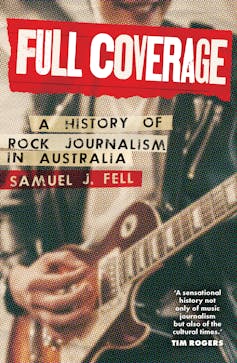
My first music writing was published in Vox, the short-lived tabloid “muzpaper”, in 1980 – and I flitted at the edges for more than a decade afterwards.
In a “journalism” career I was lucky enough to bail from a few years before the internet began to bite, I was more involved in teenage (largely, pop-oriented) colour magazines than in the out-and-out rock press in Australia. Nonetheless, I would read rock publications voraciously and I never passed up the opportunity to contribute.
There are a lot of people named in this book I have met, befriended or worked for, in my ten or more years working in publishing in Sydney in the 1980s. In that regard, Fell’s narrative has a strange, dreamlike quality for me.
Reading Full Coverage, I learned some interesting background and connections between particular writers, editors and publishers – I gained a new historical understanding of the field. There were also things that Fell failed (or perhaps chose not) to include.
Molly, Lily And Go-Set
After some courageous short-lived forays, the Australian music press started in earnest in 1966 with the Melbourne-based Go-Set. Set up by university students, whose only prior experience was Monash University’s paper, Go-Set quickly filled a need for information and connection among pop fans.
Enthusiastic writers like Lily Brett, Ian (Molly) Meldrum, Johnny Young and Douglas Panther conveyed the inside story of the lives of musicians and celebrities, while maintaining a particular accessibility for their “teens and twenties” readers.

Meldrum’s famous tale of being told by John Lennon that the Beatles were breaking up (Meldrum didn’t quite take it in, and it wasn’t until someone at Go-Set listened to the interview tape he sent back from London that the story “broke”) isn’t in this book.
But Brett’s testimony of the global pop stars – Janis Joplin, the Mamas and the Papas, Jimi Hendrix – she talked to one-to-one gives us a sense of the importance the magazine held for its readership.
Go-Set’s publisher, Philip Frazer, went on, in a haphazard way, to bring a Rolling Stone franchise to Australia.
“Stone”, as Fell and his informants insist on calling it, has been running locally ever since. In its early days, it coexisted with some key 1970s and 1980s tabloids, namely Juke and Rock Australia Magazine, popularly known as RAM.
In the early 1990s, a substantial part of the Rolling Stone staff, including Toby Creswell and Lesa-Belle Furhagen, broke with its publisher Philip Keir and set up their own magazine, Juice. Accounts vary among players about what led to the split.
Oddly, Fell muses on Juice’s similarity to the American Spin for many pages, before he notes that a proportion of its editorial was directly licensed from that publication. This was the case to the degree that the Spin logo was on the cover of early issues!
Street Papers: ‘Uniquely Australian’
The next format to crash down all assumptions about best music journalism models were the “street papers”, which Fell suggests were a uniquely Australian creation. Their extensive advertising revenue from venues, record companies and related industries allowed these publications to be provided at no cost.
The street paper killed RAM and Juke, not by being anywhere near as good, but far, far cheaper. The finale of Full Coverage is the whimper-not-a-bang decline of music-based print media in the face of social media, mercifully hastened by the pillow-on-the-face of Covid.
Fell loves the “street papers”, and one gets the sense he would happily have written about them alone. He does concede a lot less time went into them editorially, compared to those that cost money – like Juke or RAM (or Vox!).
But he doesn’t spend a lot of time on the obvious additional truth that the street papers’ editorial positions tended to be driven by the advertising dollar, which meant negativity was almost always absent from reviews. Indeed, advertising was really the only way to guarantee a feature or review.
I am reminded of a time when the editor of a street paper I occasionally wrote for declared a special issue, in which all writers would be permitted to opine freely on anything they wanted. The plan was later abandoned.
Fell explains a lot in this broad history, though he too often takes his informants at their word, and uses their words as his basis, I suspect, to construct his narrative.
He probably had no choice, given the unavailability of archives. Most of the publishers I worked for had no respect at all for legislation requiring copies of all published material to be presented to the relevant state library and the NLA.
Undeniable Soap Operas
He was surely dissuaded, probably by word-count considerations – but perhaps also by lawyers – from getting his hands dirty in the ins-and-outs of the personalities and behaviours of the individuals he’s writing about. What’s the word for respecting an author’s restraint, while wishing there was just a bit more goss within their pages?
Of course, there were many links between the producers of music magazines and the people they wrote about. By links, I don’t just mean romantic or domestic entanglements, though I do mean that, of course. There are also great, undeniable soap operas.
A public spat between Steve Kilbey of The Church and music journalist Stuart Coupe in the early 1980s springs to mind.
It would appear that Kilbey and Coupe spent a long time talking for a feature, during which Kilbey made some broad claims about his own genius. Coupe recorded the conversation and published some choice elements in RAM – to some derision from readers. (Though let’s be clear: Kilbey at his best is pretty good!) But no doubt there were hundreds more conflicts – some manufactured, others heartfelt – between artist and reporter/critic.
Similarly, Fell either doesn’t know or doesn’t care about the connection between the music press and TV, which was strong. Channel 0/10 shows, such as Uptight in the late 1960s, featured content and tie-ins with the “teens and twenties” magazine Go-Set.
Michael Gudinski’s failed foray with the early 1970s paper (Daily) Planet was repeated with a TV show, WROK, a decade later – in both cases, Gudinski failed to understand the difference between advertising and journalism. Nor does Fell mention the tragically hilarious “burial” of Go-Set following its demise, broadcast on the ABC kids’ show Flashez in the mid-1970s.
Then there are careers like that of radio announcer, pop singer and jockey Donnie Sutherland. Fell remarks on Sutherland’s induction into the world of Go-Set, but doesn’t mention his subsequent 12-year career as host of Sounds on Channel 7 – which is how most readers would remember him.
Fell also touches on Countdown magazine briefly, as a tie-in between Australia’s best known and (still) best loved TV pop show. But he hardly mentions the magazine’s content: Countdown used its biggest advantage – that the show was incredibly popular and any magazine called Countdown was going to sell – to go outside musical coverage and engage with its readers’ lives, opinions and politics.
More generally, it needs to be noted that, of course, context can get out of control. Personally, though, I could have handled the sacrifice of some of the half-remembered accounts of ins and outs of owners and editors, in return for more discussion of the publications’ content and impact.
No doubt Fell has a life, and lives can easily be frittered away reading old music magazines. But discussion, for instance, of Jen Jewel Brown’s piece for the early 1970s Daily Planet on the tribulations of being a woman writing about music would have revealed plenty.
Smash Hits And Rolling Stone
Back to the topic of Countdown: Fell pays its competitor, Australian Smash Hits, minimal notice. I worked for this magazine (primarily as features editor) between 1984 and 1991. While most definitely a music magazine, it really isn’t in Fell’s terrain. Its readers ranged from the very young to the mid-teens – they were more into “pop” than “rock”.

But I do believe to suggest Smash Hits was “struggling” in the mid-to-late 1980s, as Fell does, is a misrepresentation: it had its ups and downs, but it was the national market leader in music magazines for at least ten years after its launch in 1984, outselling all others. In short, it was the leading music magazine of its era, and someone is feeding Fell misinformation.
That it sold the most is not an argument for the magazine’s quality, of course, though it had its moments. I mention this because it speaks once again to the problem with dependence on oral history: given the long-ago demise or sell-off of various publishers, historical sales figures are largely unattainable and subject to the vagaries of memory. Fell didn’t talk to anyone from (or even really about) Australian Smash Hits.
Which only leaves the elephant in the room.

Rolling Stone has, of course, a 50-year history in Australia. Whereas Australian Smash Hits was often criticised for including content from its British parent, the first decade of Rolling Stone in this country was typically little more than a distillation of old cut-and-pastes from the American magazine. (Fell alludes to this, but doesn’t mind.)
Rolling Stone was often a shambles, and Fell appropriately gives the most space to its best era, under Kathy Bail’s editorship, when a few great moments – the Paul Keating cover most of all – brought it dangerously close to relevance.
Fell discusses the defection of key players, which led to Bail’s recruitment by publisher Philip Keir. And he gives credit to Keir and Bail for recognising the importance the internet was going to play in media, moving towards the 21st century.
‘I Thought It Was Sci-Fi Nonsense’
No one could have imagined the changes afoot, of course, but I take my hat off to Keir for seeing it more clearly than most of us. I spent time with him for a few weeks in the mid-1990s while he employed me to work up another publication for his stable – and he availed me of his knowledge of, and passion for, the possibilities of online publishing.
I was impressed that he believed it, but I thought it was sci-fi nonsense. In less than ten years, as you know, the whole landscape of print media was lacerated.
Of course, there is still a music press: look at the preposterously overblown global influence of Pitchfork, for instance. In Australia, the music press only takes print form in the most boutique of varieties, like Melbourne magazine Efficient Space. A whole social realm, a way of understanding a culture, is gone. Is that bad?
Ironically, online resources can help us understand whether it is or not – for instance, the University of Wollongong’s repository of the best 1970s-80s rock magazine of them all, Adelaide’s Roadrunner.
If Fell’s book doesn’t entirely convey why Australian rock journalism was worth the candle, the six years of Donald Robertson’s witty, passionate, innovative paper just might.![]()
David Nichols, Professor of Urban Planning, The University of Melbourne
This article is republished from The Conversation under a Creative Commons license. Read the original article.
Holes in baby dinosaur bones show how football-sized hatchlings grew to 3-tonne teens
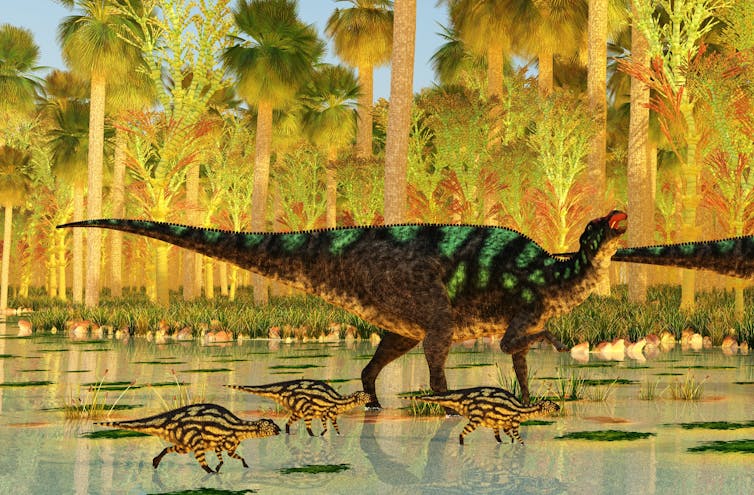
Despite their public image as torpid, lumbering creatures, many dinosaurs were evidently warm-blooded, highly active animals, capable of prolonged and strenuous aerobic exercise.
In new research, my colleagues and I determined how much energy minibus-sized dinosaurs called Maiasaura used while growing to adulthood.
Our results, published in the journal Paleobiology, show Maiasaura was capable of taking in huge amounts of energy and nutrients and using them for rapid growth and levels of activity comparable to those of modern mammals.
How Bones Heal And Grow
Living an active lifestyle can leave traces in the skeleton. Locomotion and weight-bearing activity cause stresses and strains that result in microfractures in the bones. If these tiny cracks build up, the outcome can be a catastrophic fracture.
Fortunately, the leg bones of dinosaurs – like those of birds, mammals and varanid lizards such as the Komodo dragon – repair themselves in a process known as bone remodelling.
This occurs by blood capillaries growing through old bone, which is dissolved and replaced by new bone. Under the microscope, the new bone can be seen as column-like structures called “secondary osteons”.
Many palaeontologists have looked for and found these secondary osteons in dinosaur bones as evidence for the bone remodelling that is characteristic of warm-blooded animals.
However, little attention has been given to the bones of juvenile dinosaurs, in which primary bone is being laid down in a process called bone modelling.
The main impediment to this research is the shortage of collections of bones from a single dinosaur species at different stages of growth.
‘Good Mother Reptile’
Possibly the best growth series of dinosaur bones in the world comes from the fossil beds of the Two Medicine Formation in the US state of Montana.
Fossils from this formation have yielded much information about the eggs, hatchlings and early lives of a dinosaur named Maiasaura (meaning “good mother reptile”).
This herbivorous hadrosaur apparently tended her eggs and raised her offspring for more than a year after hatching.

Young Maiasaura grew astonishingly fast, reaching 200-400 kilograms by their second year, and over 3,000kg by their teens.
In comparison, cold-blooded saltwater crocodiles today weigh only about 6kg at the age of two, and reach adulthood at between ten and 16 years old, when females weigh about 34kg and males about 115kg.
Such high growth rates in Maiasaura involved rapid lengthening and thickening of their long bones, and the process doubtlessly required much oxygen and nutrients from the blood.
The shafts of long bones of the leg, such as the femur (thigh bone) and tibia (shin bone), are supplied with blood by the principal nutrient artery, which enters the bone through a hole (called a foramen) that is visible on the surface.
How To Measure Blood Flow From Bones
A decade ago, I wondered whether the size of the foramen could be an indirect measurement of the rate of blood flow to a bone.
This turned out to be true, and since then the “foramen technique” has been used on fossils to estimate blood flow rate and hence how much energy and nutrients were used in the bones of adult dinosaurs.
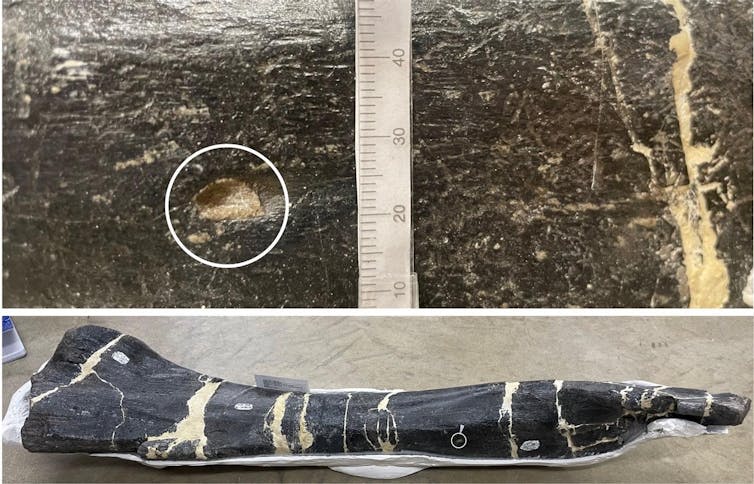
To apply the foramen technique to the fast-growing juvenile Maiasaura, I teamed up with Heath Caldwell, a student at Montana State University, who searched for the tiny foramina among the fossil collection at the Museum of the Rockies in Bozeman, Montana.
Holly Woodward of Oklahoma State University had previously determined the ages of the animals when they died. Qiaohui Hu at Adelaide University used the best techniques for measuring foramen size and relating it to nutrient artery size.
Rapid Growth Doesn’t Come Cheap
Our work produced clear results. Blood flow rates calculated from foramen size were similar in one-year-old dinosaurs weighing between 189kg and 455kg and in six- to 11-year-old adults weighing between 1,680kg and 3,200kg.
In other words, a one-year-old had about four times as much blood flowing to each gram of its shinbone as a full-grown adult did. The flow rate per gram in the femur of a two kilogram hatchling Maiasaura was 15 times higher than that of the adults.
These differences reveal how much more energy and nutrients it took to build bones in the early rapid growth stages of a Maiasaura’s life than it did to maintain the bones in adulthood.
The size of the foramen in adults was also comparable to those in mammals alive today, and much larger than in most modern reptiles. These findings support the view that dinosaurs were not cold-blooded and sluggish, but warm-blooded, very active, fast-growing animals that dominated the Mesozoic landscape.![]()
Roger S. Seymour, Professor Emeritus of Physiology, University of Adelaide
This article is republished from The Conversation under a Creative Commons license. Read the original article.
Nobel prize in medicine awarded to mRNA pioneers – here’s how their discovery was integral to COVID vaccine development
Alice Godden, University of East AngliaBillions of people around the world have received the Pfizer or Moderna COVID-19 vaccines. The rapid development of these vaccines changed the course of the pandemic, providing protection against the SARS-CoV-2 virus.
But these vaccines would not have been possible it if weren’t for the pioneering work of this year’s winners of the Nobel prize in physiology or medicine decades earlier.
Dr Katalin Karikó and Dr Drew Weissman, researchers from the University of Pennsylvania, have been given the prestigious award for their discoveries into mRNA biology. The pair were the first to discover a way of modifying mRNA that allowed it to successfully be delivered to cells and replicated by them.
Their discovery was not only integral to COVID-19 vaccine development, but may also lead to the development of many other therapies – such as vaccines for cancer.
Life’s Work
Karikó is a Hungarian biochemist and Weissman an American physician scientist. The two began working together in 1985 when Karikó was a postdoctoral researcher at the University of Pennsylvania, where Weissman was already working as an immunologist. They had a shared interest in how mRNA could be used to make new therapies.
Messenger RNA (better known as mRNA) is an essential molecule to life. It’s made in the body from our very own DNA in a process called translation. DNA is our special encoded handbook of instructions for manufacturing proteins, which are the building blocks for material in the body.
Our mRNA copies and carries these genetic instructions from our DNA to our cells. The cells then make whatever protein they’ve been instructed to, such as haemoglobin which helps red blood cells carry oxygen around the body.
Karikó and Weissman thought that if it was possible to commandeer this process, mRNA could be used to instruct cells to essentially make their own cures. But at the time they started working together, attempts by other researchers to do this had been unsuccessful.
The researchers faced two major challenges as they began their work. The first was being able to prevent the host from mounting an immune response against the modified mRNA. The second was being able to deliver the mRNA into the host safely without it degrading.
To understand how they overcame the first barrier, it’s important to understand mRNA’s structure. Normally, mRNA molecules contain four types of smaller molecules known as bases (nucleosides): A (adenine), U (uridine), G (guanine), and C (cytosine). Different sequences of these bases can be strung together to produce the basis of an mRNA molecule.

In early experiments, Karikó and Weismann found that injecting normal mRNA molecules into mice led to an immune response. This meant the mouse’s immune system saw the new mRNA as an invading pathogen and the immune cells would destroy it, instead of replicating it.
So the researchers modified the U nucleoside to create a pseudouridine, a chemical compound which stabilises RNA’s structure. When they repeated their experiment with the modified mRNA, the mice exhibited no immune response.
But Karikó and Weismann still faced the second challenge of being able to deliver the bespoke mRNA without it degrading.
They decided to use lipids (a nanoparticle) to deliver it. These fatty chemical compounds are an essential part of the cell membrane, controlling what enters and leaves the cell. Specially created lipids allowed the mRNA molecules to be delivered without being degraded or broken down by the immune system.
Karikó and Weissman’s research had successfully eliminated the obstacles that had previously stood in the way of using mRNA clinically. Being able to instruct the body to replicate virtually any harmless protein could have potential for treating a range of diseases and even protect against viral infections.
COVID Vaccines
When their research was first published, it didn’t garner much attention. But in 2011, two biotech companies – Moderna and BioNTech – took notice and began research into mRNA medicines.
It’s no wonder why. Traditional vaccine production methods are time consuming, expensive and don’t work for every vaccine. But Karikó and Weissman’s work showed that synthetic mRNA could be made at a large scale.
Researchers had already been working on developing mRNA vaccines before the pandemic, such as a vaccine for Ebola that didn’t receive much commercial interest. But in 2020, when COVID-19 began spreading around the globe, vaccines were needed quickly to offer protection.
Using the foundational work of Karikó and Weissman, scientists developed a bespoke mRNA sequence which mimicked the spike protein (which allows the virus to enter our cells). This produced a harmless COVID particle which our cells then replicated, allowing our bodies to protect us from severe COVID infections when it encountered the real virus.
Karikó and Weissman’s discoveries years earlier were critical in making the COVID-19 mRNA vaccines possible. But these aren’t the only ways their work could be applied.
Researchers are now hoping to develop mRNA vaccines for diseases such as HIV and Zika virus. Studies have also shown mRNA vaccines might be useful in treating certain types of cancer.![]()
Alice Godden, Senior research associate, School of Biological Sciences, University of East Anglia
This article is republished from The Conversation under a Creative Commons license. Read the original article.
30 years of the web down under: how Australians made the early internet their own
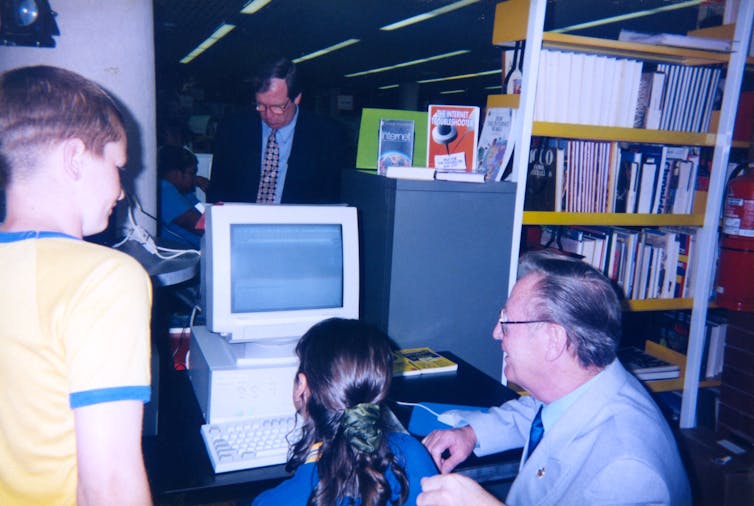
The internet is growing old. While the roots of the internet date back to the 1960s, the popular internet – the one that 99% of Australians now use – is a child of the 1990s.
In the space of a decade, the internet moved from a tool used by a handful of researchers to something most Australians used – to talk to friends and family, find out tomorrow’s weather, follow a game, organise a protest, or read the news.
The Popular Internet Grows Up
This year marks 30 years since the release of Mosaic, the first browser that integrated text and graphics, helping to popularise the web: the global information network we know today.
Google is now 25, Wikipedia turned 21 last year, and Facebook will soon be 20. These anniversaries were marked with events, feature articles and birthday cakes.
But a local milestone passed with little fanfare: 30 years ago, the first Australian websites started to appear.
The web made the internet intelligible to people without specialist technical knowledge. Hyperlinks made it easy to navigate from page to page and site to site, while the underlying HTML code was relatively easy for newcomers to learn.
Australia Gets Connected
In late 1992, the first Australian web server was installed. The Bioinformatics Hypermedia Server was set up by David Green at the Australian National University in Canberra, who launched his LIFE website that October. LIFE later claimed to be “Australia’s first information service on the World Wide Web”.
Not that many Australians would have seen it at the time. In the early 1990s, the Australian internet was a university-led research network.
The Australian Academic and Research Network (AARNet) connected to the rest of the world in 1989, through a connection between the University of Hawaii and the University of Melbourne. Within a year, most Australian universities and many research facilities were connected.
The World Wide Web was invented by English computer scientist Tim Berners-Lee and launched in 1991. At the time, it was just one of many communication protocols for creating, sharing and accessing information.
Researchers connected to AARNet were experimenting with tools like Gopher and Internet Relay Chat alongside the web.
Even as a research network, the internet was deeply social. Robert Elz, one of the computer scientists who connected Australia to the internet in 1989, became well-known for his online commentaries on cricket matches. Science fiction fans set up mailing lists.
These uses hinted at what was to come, as everyday Australians got online.
The Birth Of The Public Internet
Throughout 1994, AARNet enabled private companies to buy network capacity and connect users outside research contexts. Ownership of the Australian internet was transferred to Telstra in 1995, as private consumers and small businesses began to move online.
With the release of web browsers like Mosaic and Netscape, and the increase in dial-up connections, the number of Australian websites grew rapidly.
At the start of 1995, there were a couple of hundred. When the Australian internet went public just six months later, they numbered in the thousands. By the end of the decade there were hundreds of thousands.
Everyday Australians Get Connected
As everyday Australians went online, students, activists, artists and fans began to create a diverse array of sites that took advantage of the web’s possibilities.
The “cyberfeminist zine” geekgirl, created by Rosie X. Cross from her home in inner-west Sydney, combined a “Do It Yourself” punk ethos with the global distribution the web made possible. It was part of a diverse and flourishing feminist culture online.
Australia was home to the first fully online doctorate, Simon Pockley’s 1995 PhD thesis Flight of Ducks.
Art students presented poetry as animated gifs, labelling them “cyberpoetry”. Aspiring science fiction writers published multimedia stories on the web.
The Australian Internet Goes Mainstream
Political parties, government and media also moved online.
The Age Online was the first major newspaper website in Australia. Launched in February 1995, the site beat Australia’s own national broadcaster by six months and the New York Times by a year.
Though The Age was first, ABC Online and ninemsn – linked to the Hotmail email service – were the most popular.
During the 1998 federal election, ABC Online saw over two million hits per week. Political parties, candidates and interest groups were quick to establish a web presence, kicking off the era of online political campaigning.
The web also became big business. By the end of the decade, Australia had its own internet entrepreneurs, including a future prime minister. Established media companies dominated web traffic.
“Internet fever” was sweeping Australian businesses, leading to an “internet stocks frenzy”. The internet had gone mainstream and the “dot com bubble” was rapidly inflating.
Looking Back On The Decade The Popular Internet Was Born
The public, open, commercial internet is now a few decades old. Given current concerns about the state of the internet – from the power of large digital platforms to the proliferation of disinformation – it might be tempting to look at the 1990s as a “golden age” for the internet.
However, we must resist looking back with rose-coloured glasses. What is needed is critical scrutiny of the conditions that underpinned internet use and attention to how a diversity of people incorporated technology in their lives and helped transformed it in the process. This will help us understand how we got the internet we have and how we might achieve the internet we want.
Understanding online history can be particularly difficult because many sites have long-since disappeared. However, archiving efforts like those of the Internet Archive and the National Library of Australia make it possible to look back and see how much things have changed, what concerns are familiar, and remember the everyday people who helped transform the internet from a niche academic network to a mass medium.![]()
Kieran Hegarty, Research Fellow (Automated Decision-Making Systems), RMIT University
This article is republished from The Conversation under a Creative Commons license. Read the original article.
Book Of The Month October 2023: Myths & Legends Of The Australian Aboriginals
By Smith, W. Ramsay (William Ramsay), 1859-1937. Publication Date: 1932
UNDERWATER! 2023 Photo Competition Now Open: Dive On In To The 30th Ocean Festival
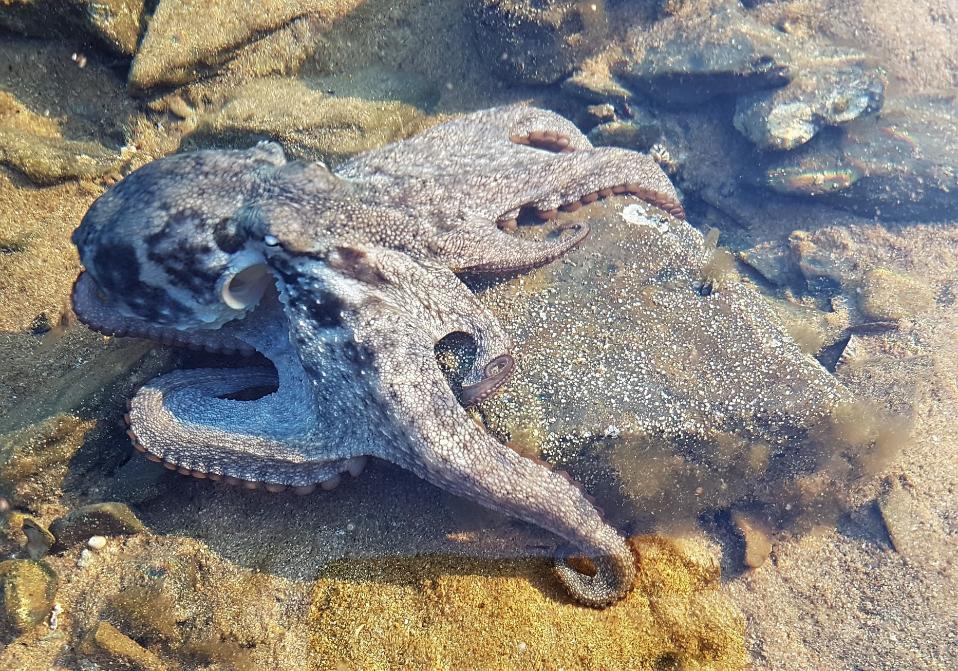
Resident octopus at North Narrabeen Aquatic Reserve rock shelf - photo by Joe Mills
Entries are now open for the UNDERWATER! 2023 Photo Competition with a prize pool of $4,400 up for grabs.
Now in its third year, the annual competition is part of the 30th Ocean Festival which kicks off at the end of November (Sunday 26 November – Sunday 3 December) with an eight day festival celebrating our five marine protected areas, our invertebrates, marine flora, fauna and megafauna.
The UNDERWATER! 2023 Photo Competition celebrates our ocean, its biodiversity and the human connection to it, along with the urgent need to protect our oceans for future generations.
Northern Beaches Mayor Sue Heins said our precious oceans are the great connectors of our world, uniting continents, cultures, creatures and deserve our utmost care and respect.
“Covering over 80% of our planet, oceans are more than just bodies of water; they are sanctuaries of life, and they should not be taken for granted. We need to be their guardians and preserve them for generations to come.
“Our oceans are the lungs of our planet, providing 50% of the oxygen we breathe, and our lives depend on it. The more that people know about what is under the water, the more likely they are to protect our oceans.
“Sharing photographs of the wonders beneath the waterline as part of the Ocean Festival, is the perfect opportunity to share knowledge about protecting and conserving our oceans to safeguard this treasure which is such an important part of life on the Northern Beaches,” Mayor Heins said.
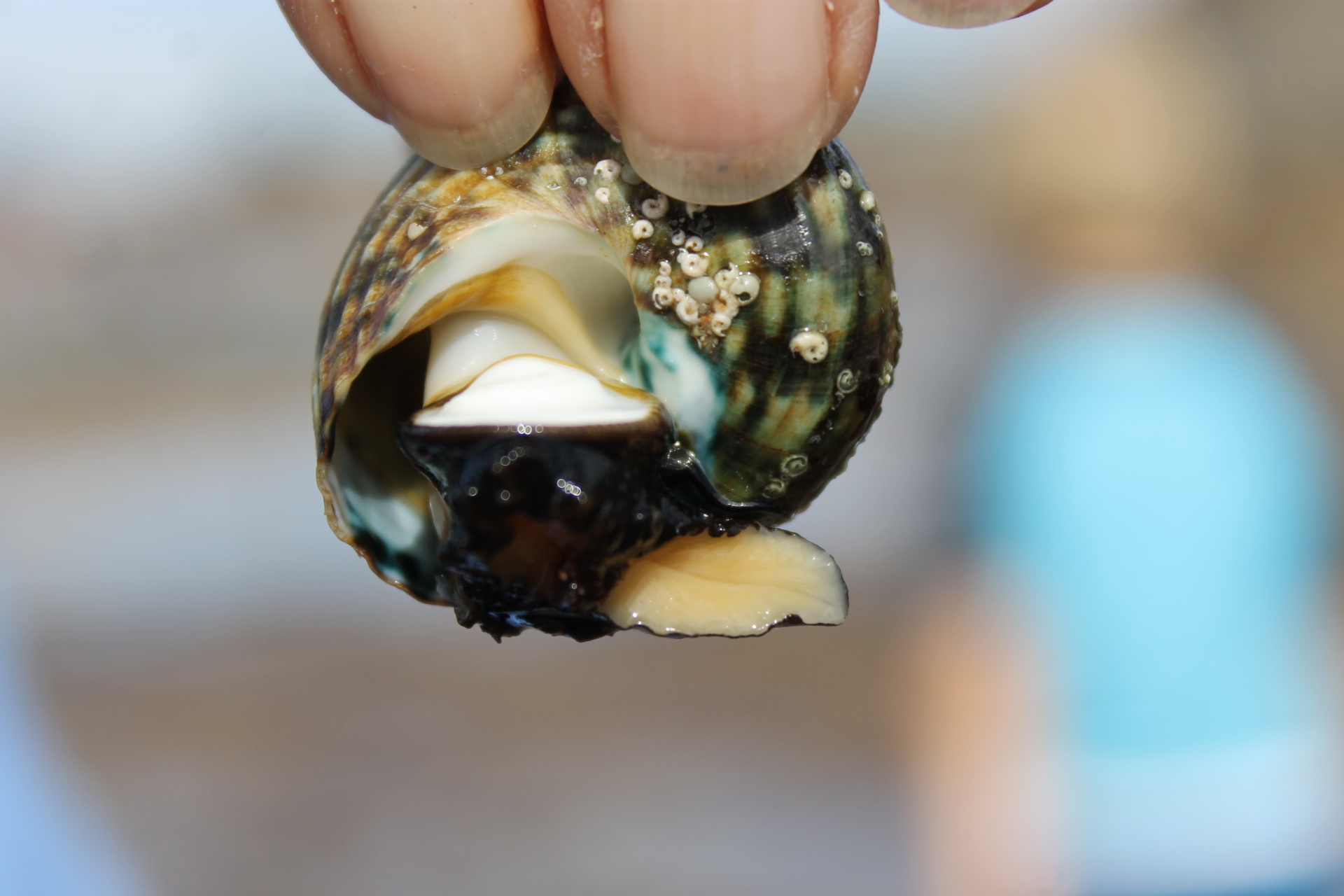
Entrants are asked to respond to the eight categories with this year’s theme ‘Life Below Water’. All submissions must be taken within the last two years at one of the five aquatic reserves on the Northern Beaches.
This year young people aged 18 – 24yrs are also encouraged to enter the competition and share their fascination with the underwater world. The winner will be recognised as the Young UNDERWATER! 2023 Photographer of the Year.
In addition, a new category of Reels (15 - 30 secs) has been added to appeal to underwater videographers.
Entries for all categories close 11:59pm on Monday 23 October 2023.
The People’s Choice Award will be online for voting from 6 -19 November.
Council will keep you posted on the line up for the 30th Ocean Festival but some of the activities include Science at the Steyne, Dive for Debris, Rock Platform Rambles, UNDERWATER! 2023 Photo winners and an exhibition, Guided Snorkel Tours, SUP Safaris, coast walks, talks and much more.
For more information about the competition and to enter visit: www.northernbeaches.nsw.gov.au/things-do/whats/ocean-festival/underwater-2023-photo-competition
New Research By ReachOut Highlights Links Between Study Stress And Poor Sleep In The Lead Up To Year 12 Exams
- Lifeline – 13 11 14
- Kids Helpline – 1800 55 1800
- 13YARN – 13 92 76 to speak with an Aboriginal & Torres Strait Islander crisis supporter
- If you are in immediate danger dial 000
Links To ReachOut Support Content

8 Student-Backed Study Tips To Help You Tackle The HSC
By University of Sydney: Last updated 6 July 2023
Our students have been through their fair share of exams and learned a lot of great study tactics along the way. Here they share their top study tips to survive and thrive during exam time.
1. Start your day right
Take care of your wellbeing first thing in the morning so you can dive into your day with a clear mind.
“If you win the morning, you can win the day,” says Juris Doctor student Vee Koloamatangi-Lamipeti.
An active start is a great way to set yourself up for a productive day. Begin your morning with exercise or a gentle walk, squeeze in 10 minutes of meditation and enjoy a healthy breakfast before you settle into study.
2. Schedule your study
“Setting up a schedule will help you organise your time so much better,” says Master of Teaching student Wesley Lai.
Setting a goal or a theme for each study block will help you to stay focused, while devoting time across a variety of subjects will ensure you've covered off as much as possible. Remember to keep your schedule realistic and avoid over-committing your time.
Adds Wesley, “Make sure to schedule in some free time for yourself as well!”
3. Keep it consistent
“Make studying a habit,” recommends Alvin Chung, who is currently undertaking a Bachelor of Arts and Bachelor of Laws.
With enough time and commitment, sitting down to study will start to feel like second nature rather than a chore.
“Do it every day and you’ll be less likely to procrastinate because it’s part of your life’s daily motions,” says Alvin.
4. Maintain motivation
Revising an entire year of learning can seem like an insurmountable task, which is why it’s so important to break down your priorities and set easy-to-achieve goals.
“I like to make a realistic to-do list where I break down big tasks into smaller chunks,” says Bachelor of Arts and Advanced Studies student Dannii Hudec.
“It’s also really important to reward yourself after you complete each task to keep yourself motivated.”
Treat yourself after each study block with something to look forward to, such as a cup of tea, a walk in the park with a friend or an episode of your latest Netflix obsession.
5. Minimise distractions
With so many distractions at our fingertips, it can be hard to focus on the task at hand. If you find yourself easily distracted, an “out of sight, out of mind” approach might do the trick.
“What helps me is to block social media on my laptop. I put my phone outside of my room when I study, or I give it to my sister or a friend to hide,” says Bachelor of Commerce and Bachelor of Laws student Caitlin Douglas.
While parting ways with your phone for a few hours may seem horrifying, it can be an incredibly effective way to stay on task.
“It really helps me to smash out the work and get my tasks done,” affirms Caitlin.
6. Beware of burnout
Think of the HSC period as a marathon rather than a sprint. It might be tempting to cram every single day but pacing out your study time will help to preserve your endurance.
“Don’t do the work for tomorrow if you finish today’s work early,” suggests Daniel Kim, who is currently undertaking a Bachelor of Commerce and Advanced Studies.
“Enjoy the rest of your day and save the energy for tomorrow,” he recommends.
Savouring your downtime will help you to avoid burning out before hitting the finish line.
7. Get a good night's sleep
Sleep is one of your greatest allies during exam season.
“I’ve found that a good night’s sleep always helps with concentration and memory consolidation,” says Bachelor of Science (Medical Science) student Yasodara Puhule-Gamayalage.
We all know we need to be getting around 8 hours of sleep a night to perform at our best, but did you know the quality of sleep also matters? You can help improve the quality of your sleep with some simple tweaks to your bedtime routine.
“Avoid caffeine in the 6 hours leading up to sleep, turn off screens an hour before going to bed, and go to bed at the same time every night,” suggests Yasodara.
8. Be kind to yourself
With exam dates looming and stress levels rising, chances are high that you might have a bad day (or a few!) during the HSC period.
According to Bachelor of Arts and Advanced Studies student Amy Cooper, the best way to handle those bad days is to show yourself some kindness.
“I know that if I’m in a bad state of mind or having a bad day, I’m not going to be able to produce work that I’m proud of,” she says.
For Amy, the remedy for a bad day is to take some time to rest and reset.
“It’s much more productive in the long run for me to go away, do some things I love, and come back with a fresh mind.”
Immerse yourself in a mentally nourishing activity such as going for a bushwalk, cooking your favourite meal, or getting stuck into a craft activity.
If you feel completely overwhelmed, know you're not alone. Reach out to a friend, family member or teacher for a chat when you need support.
There are also HSC Help resources available at: education.nsw.gov.au/student-wellbeing/stay-healthy-hsc
Wednesday 11 October, 2023: HSC written exams start.
Mandatory Care Minutes Boost Care Levels For Older People In Australia
Why do I get so much spam and unwanted email in my inbox? And how can I get rid of it?

Spam might not have brought an end to the internet or email, as some dire predictions in the early 2000s claimed it could – but it’s still a massive pain.
Despite all the spam being removed by spam-filtering technologies, most people still receive spam every day. How do these messages end up flooding our inboxes? And are there any legal consequences for the senders?
What Is Spam?
The Organisation for Economic Co-operation and Development (OECD) noted in 2004 “there does not appear to be a widely agreed and workable definition for spam” across jurisdictions – and this remains true today.
That said, “spam” generally refers to unsolicited electronic messages. These are often sent in bulk and frequently advertise goods or services. It also includes scamming and phishing messages, according to the OECD.
Most people think of spam in the form of emails or SMS messages. However, what we now call spam actually predates the internet. In 1854, a spam telegram was sent to British politicians advertising the opening hours of dentists who sold tooth-whitening powder.
The first spam email came more than 100 years later. It was reportedly sent to 600 people on May 3 1978 through ARPAnet – a precursor to the modern internet.
As for how much spam is out there, the figures vary, possibly due to the various definitions of “spam”. One source reports the average number of spam emails sent daily in 2022 was about 122.33 billion (which would mean more than half of all emails were spam). As for text messages, another source reports a daily average of 1.6 billion spam texts.
Where Do Spammers Get My Details?
Each time you enter your email address or phone number into an e-commerce website, you may be handing it to spammers.
But sometimes you may even receive spam from entities you don’t recognise. That’s because businesses will often transfer customers’ contact information to related companies, or sell their data to third parties such as data brokers.
Australia’s Privacy Act 1988 somewhat limits the transfer of personal information to third parties. However, these laws are weak – and weakly enforced.
Some entities also use “address-harvesting” software to search the internet for electronic addresses that are captured in a database. The collector then uses these addresses directly, or sells them to others looking to send spam.
Many jurisdictions (including Australia) prohibit these harvesting activities, but they are still common.
Is Spamming Against The Law?
Australia has had legislation regulating spam messaging since 2003. But the Spam Act surprisingly does not define the word “spam”. It tackles spam by prohibiting the sending of unsolicited commercial electronic messages containing offers, ads or other promotions of goods, services or land.
However, if the receiver consented to these types of messages, the prohibition does not apply. When you buy goods or services from a company, you will often see a request to click on a “yes” button to receive marketing promotions. Doing so means you have consented.
On the other hand, if your phone or inbox are hit by commercial messages you haven’t agreed to receive, that is a breach of the Spam Act by the sender. If you originally signed up to receive the messages, but then unsubscribed and the messages kept coming after five business days, that is also illegal. Senders must also include a functioning unsubscribe facility in every commercial message they send.
Spammers can be penalised for breaches of the Spam Act. In the past few months alone, Commonwealth Bank, DoorDash and mycar Tyre & Auto were fined more than A$6 million in total for breaches.
However, most spam comes from outside Australia where the laws aren’t the same. In the United States spam is legal under the CAN-SPAM Act until you opt out. Unsurprisingly, the US tops the list of countries where the most spam originates.
Although spam sent to Australia from overseas can still breach the Spam Act – and the Australian Communications and Media Authority (ACMA) co-operates with overseas regulators – overseas enforcement actions are difficult and expensive, especially if the spammer has disguised their true identity and location.
It’s worth noting that messages from political parties, registered charities and government bodies aren’t prohibited – nor are messages from educational institutions to students and former students. So while you might consider these messages as “spam”, they can legally be sent freely without consent. Factual messages (without marketing content) from businesses are also legal as long as they include accurate sender details and contact information.
Moreover, the Spam Act generally only covers spam sent via email, SMS/MMS or instant messaging services, such as WhatsApp. Voice calls and faxes aren’t covered (although you can use the Do Not Call Register to block some commercial calls).
Staying Safe From Spam (And Cyberattacks)
Spam isn’t only annoying, it can also be dangerous. Spam messages can contain indecent images, scams and phishing attempts. Some have malware (malicious software) designed to break into computer networks and cause harm, such as by stealing data or money, or shutting down systems.
The Australian Cyber Security Centre and ACMA provide useful tips for reducing the spam you get and your risk of being hit by cyberattacks. They suggest to:
use a spam filter and block spammers – email and telecommunications providers often supply useful tools as part of their services
unsubscribe from any emails you no longer want to receive – even if you originally agreed to receive them
remove as much of your contact details from websites as you can and always restrict the sharing of your personal information (such as name, birth date, email address and mobile number) when you can – beware of pre-ticked boxes asking for your consent to receive marketing emails
install cybersecurity updates for your devices and software as you get them
always think twice about opening emails or clicking on links, especially for messages promising rewards or asking for personal information – if it looks too good to be true, it probably is
use multi-factor authentication to access online services so even if a scam compromises your login details, it will still be difficult for hackers to break into your accounts
report spam to your email and telecommunications providers, and to ACMA.

Kayleen Manwaring, Senior Research Fellow, UNSW Allens Hub for Technology, Law & Innovation and Senior Lecturer, School of Private & Commercial Law, UNSW Law & Justice, UNSW Sydney
This article is republished from The Conversation under a Creative Commons license. Read the original article.
Journey Through 102 Years: The Life Of Helen Lea
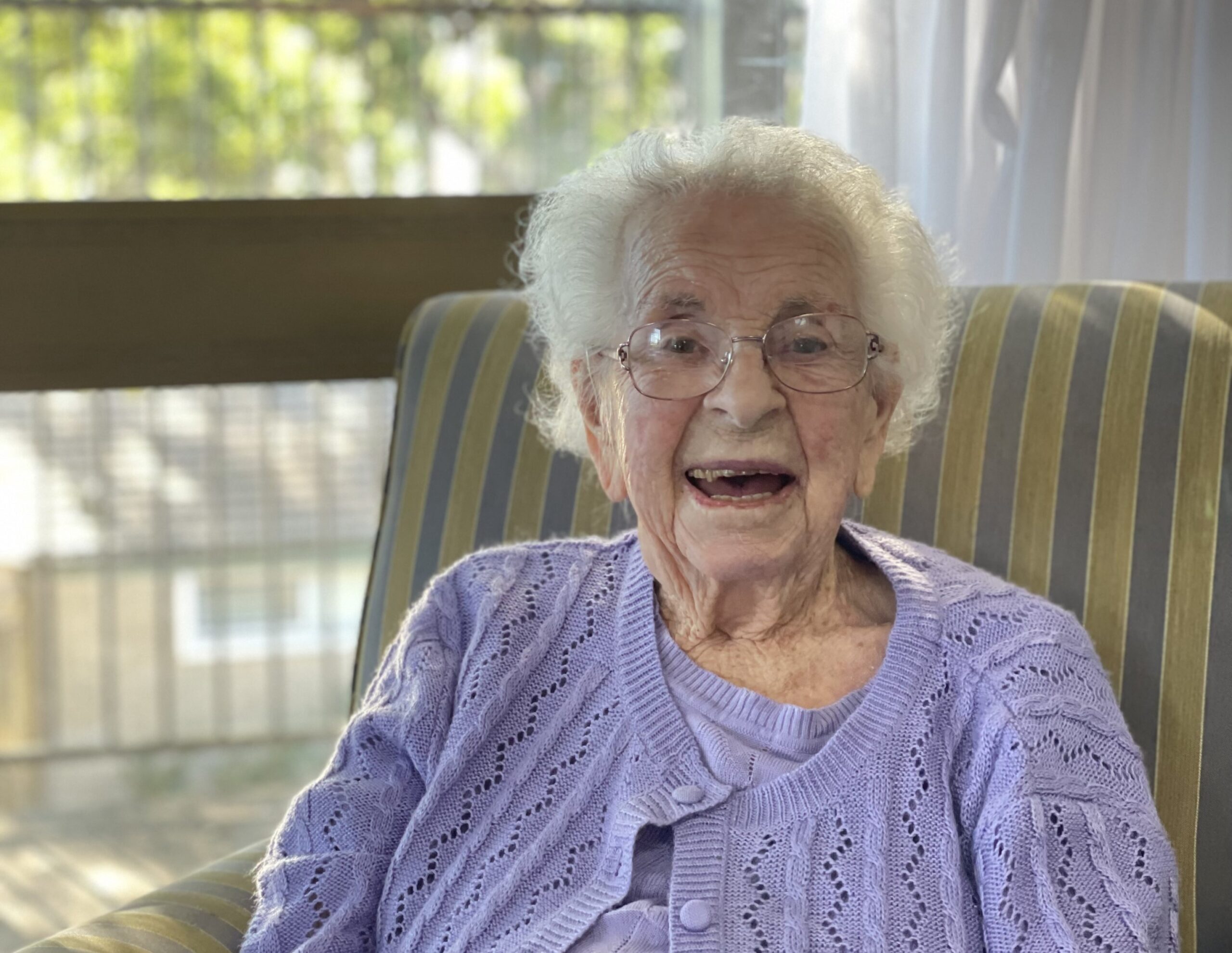
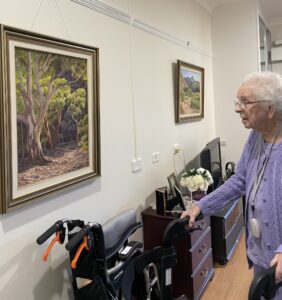
Avpals Training Term Four 2023 At Newport
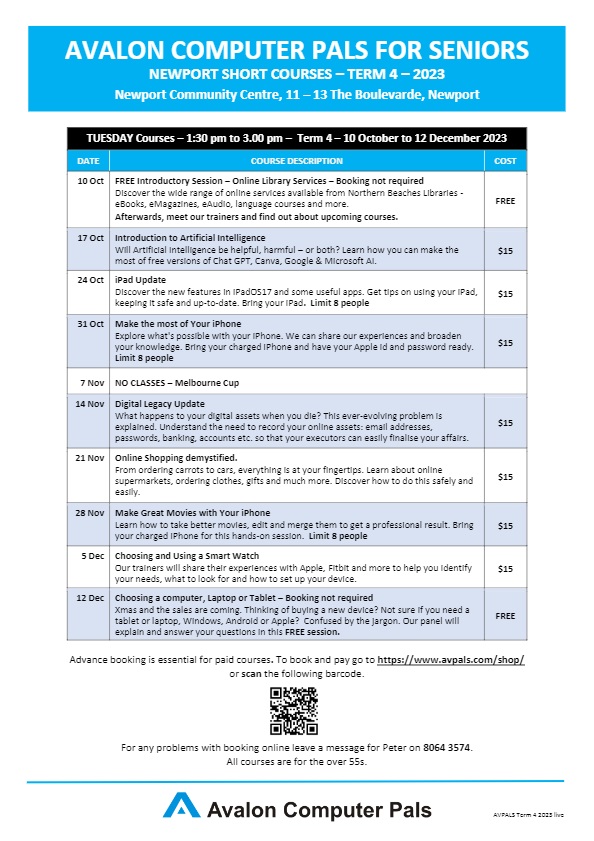
George Carpenter’s Inspiring Dedication To Preserving Military History
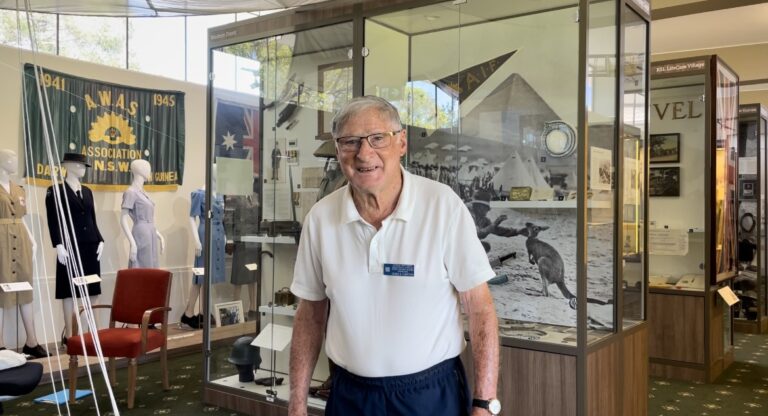
Employment Whitepaper Takes Positive Steps Towards Addressing Barriers Preventing Older People From Engaging In The Workforce
Seniors Dental Benefit Scheme Needed To Guarantee Access To Oral Health Treatment For All Older Australians
Beyond the PwC scandal, there’s a growing case for a royal commission into Australia’s ruthless corporate greed

Accounting and consulting group PwC has been front page news ever since its chief executive Tim Seymour stepped down “effectively immediately” in May, when the firm said it had “betrayed the trust” of Australians and promised an independent review of its governance, accountability and culture.
That review, conducted by former Telstra chief Ziggy Switkowski, was published on Wednesday, along with an assurance from the firm that it would implement the recommendations.
Released with the review was a separate Statement of Facts prepared by PwC. This set out how it had provided advice to clients based on confidential government information about tax policy, which had been provided to one of its partners on the condition it be kept confidential.
‘Untouchables’ And ‘Troublesome Practice Matters’
Switkowski found PwC Australia’s culture and governance practices were so weak they led to “integrity failures”.
It was an organisation that prized revenues and growth over ethics, values and purpose, with a “whatever it takes” culture that made “heroes” out of partners who raked in the most money.
If you were at the top, you were called a “rainmaker”. The biggest rainmakers who brought in the most money were referred to as “untouchables”, to whom “the rules don’t always apply”.
Switkowski found the culture was “collegial” in the sense that dissent wasn’t welcome.
While good news was shared among partners, difficult news was kept quiet and referred to internally as “troublesome practice matters”, or TPMs. Legal updates about TPMs were “generally verbal”.
The chief executive, elected by partners in a “presidential-style campaign”, was “not perceived to be accountable to the board”.
Among Switkowski’s most important recommendations were that PwC Australia be run like a public company listed on the Australian Securities Exchange – with a board that included independent directors and had the power to hire and fire the chief executive.
PwC Australia has agreed to this, and all 23 recommendations.
Problems Far From Over
As damning as the report is, Labor Senator Deborah O’Neill – who is chairing the Senate inquiry into the management and integrity of consulting services – says it “merely scratched the surface” of what was going on both at PwC.
Her committee has until November to report.
Back in May, the Australian Treasury asked the Australian Federal Police to consider commencing a criminal investigation into PwC’s improper use of confidential Commonwealth information.
And in July, Greens Senator Barbara Pocock formally referred PwC’s conduct to the new National Anti-Corruption Commission.
This all spells more trouble ahead for PwC, and perhaps for the Australian consulting industry more generally.
More Than One Bad Apple?
Although sparked by the revelations about PwC Australia, Senator O'Neil’s committee is inquiring into the behaviour of all of Australia’s consultancy groups.
It has taken evidence from Deloitte, EY, KPMG, McKinsey and The Boston Consulting Group.
New research by Roy Morgan suggests the bad image of corporations spreads beyond the consultants.
Asked about distrust or distrust of any brand in Australia in June, the result was an all-time high for distrust.
Roy Morgan identified the PwC tax scandal and the data breaches at Optus and Medibank among recent events accelerating distrust.
It also identified:
the Harvey Norman JobKeeper scandal, Rio Tinto’s destruction of the Juukan Gorge, Qantas’ refusal to pay back any of the $2.7 billion in COVID government handouts and the class action by hundreds of thousands of customers fuelled by the airline’s unwillingness to refund $2 billion in cancelled flights
A record number of those surveyed identified “too motivated by profit” as a reason for their distrust.
This makes it reasonable to ask whether a culture of ruthless profiteering has infiltrated Australian corporate cultures across the board.
After the consultants have been dealt with, there is a case for royal commission into whether Australia’s entire corporate sector is meeting its responsibilities.
PwC has helped open the door.![]()
Carl Rhodes, Professor of Organization Studies, University of Technology Sydney
This article is republished from The Conversation under a Creative Commons license. Read the original article.
2023 NSW Student Literary Awards: Congratulations Jayden And Matvey Of Mona Vale Public School!
- Stage 1: Jayden S of Mona Vale Public School
- Stage 2: Matvey L of Mona Vale Public School
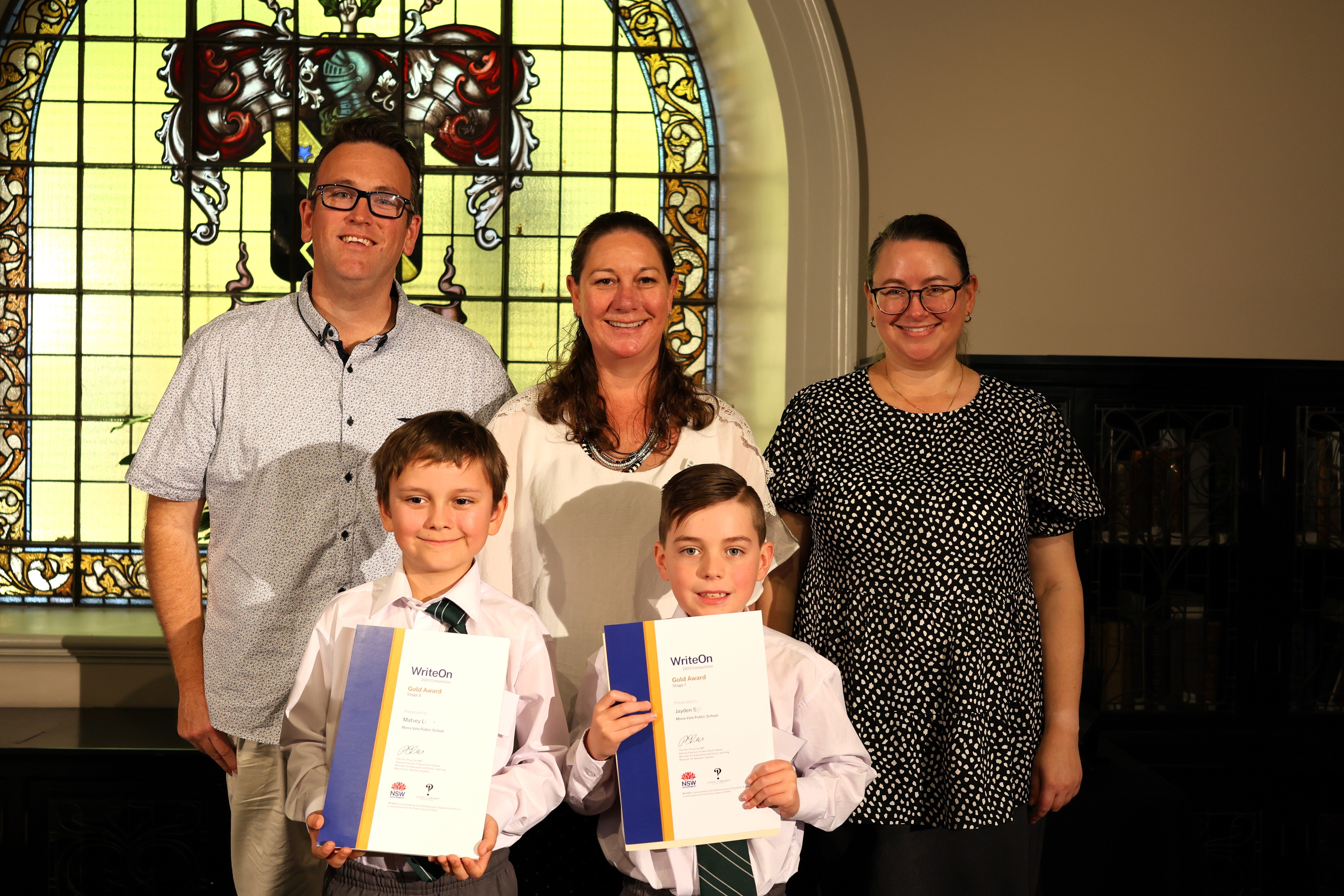
Summer 2023 Snorkelling
Australia Post New Stamp Collection Celebrates 100 Years Of Disney Magic
October 3, 2023
Some of the world’s most loved Disney characters will feature in iconic Australian settings on stamps celebrating 100 years of Disney. The special collectable set is available at participating Australia Post shops from today.
The four stamps in the set show Disney Pixar’s Nemo, the clownfish from Finding Nemo making himself at home in Sydney Harbour, Ariel from The Little Mermaid at the Great Barrier Reef, and Kanga and Roo from Winnie The Pooh in their natural habitat in Australia’s Red Centre. The collection is made complete with Disney icons Mickey Mouse and Minnie Mouse sightseeing on Victoria’s Great Ocean Road.

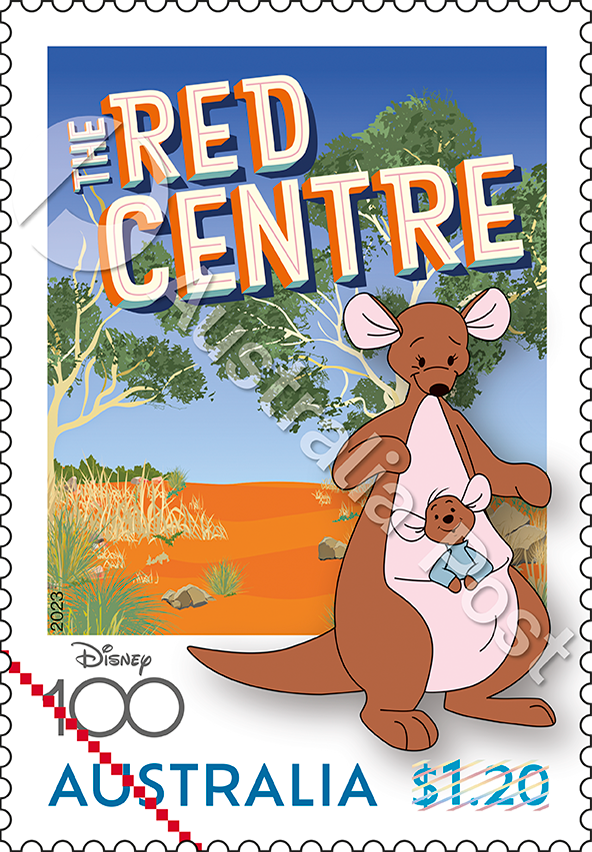


Melbourne-based Tara Stone, Product Development Manager at The Walt Disney Company Australia & New Zealand, designed the range which was inspired by her childhood love of stamp collecting.
"Collaborating with two beloved brands like Disney and Australia Post is one of my childhood dreams realised – and it makes it an even bigger career and personal highlight for me since it is also Disney's 100th anniversary.
“I am so excited to be able to help bring to life this range of stamps featuring fan-favourite Disney characters while also showcasing the beautiful Australian environment using bold colours and iconic locations,” she added.
Australia Post Executive General Manager Retail Catriona Noble said it was exciting to collaborate with Disney for the latest stamp collection.
“Generations of Australians have grown up with Disney, from the early days of cinema and television through to today. We’re delighted to celebrate our favourite Disney characters with a touch of Aussie flair in this latest commemorative stamp collection. Disney’s official 100-year celebration is on 16 October, and we hope all Australians find their inner-child and celebrate their favourite characters for this special occasion,” Ms. Noble said.
The Walt Disney Company Australia & New Zealand Vice President & General Manager of Consumer Products Commercialisation Tim Everett said seeing iconic Disney characters on a circulated Australian stamp was a special local highlight among this year’s celebration.
“It’s been a very big year already for Disney fans across the world, but I am so pleased to see an iconic local brand like Australia Post help us celebrate Australian fans in such a special way.
“Also, the fact the stamp range was designed by one of our Australian cast members adds an extra level of local flavour to this moment – and makes it something we can be even more proud of,” he added.
Stamps are $1.20 each and the new collection will also have available for purchase separately a first-day cover, stamp pack, minisheet, maxi cards as well as a range of collectable licenced products including collection packs and medallions. They are on sale now at participating Post Offices, via mail order on 1800 331 794 and online while stocks last. For more information, visit auspost.com.au/stamps or www.australiapostcollectables.com.au
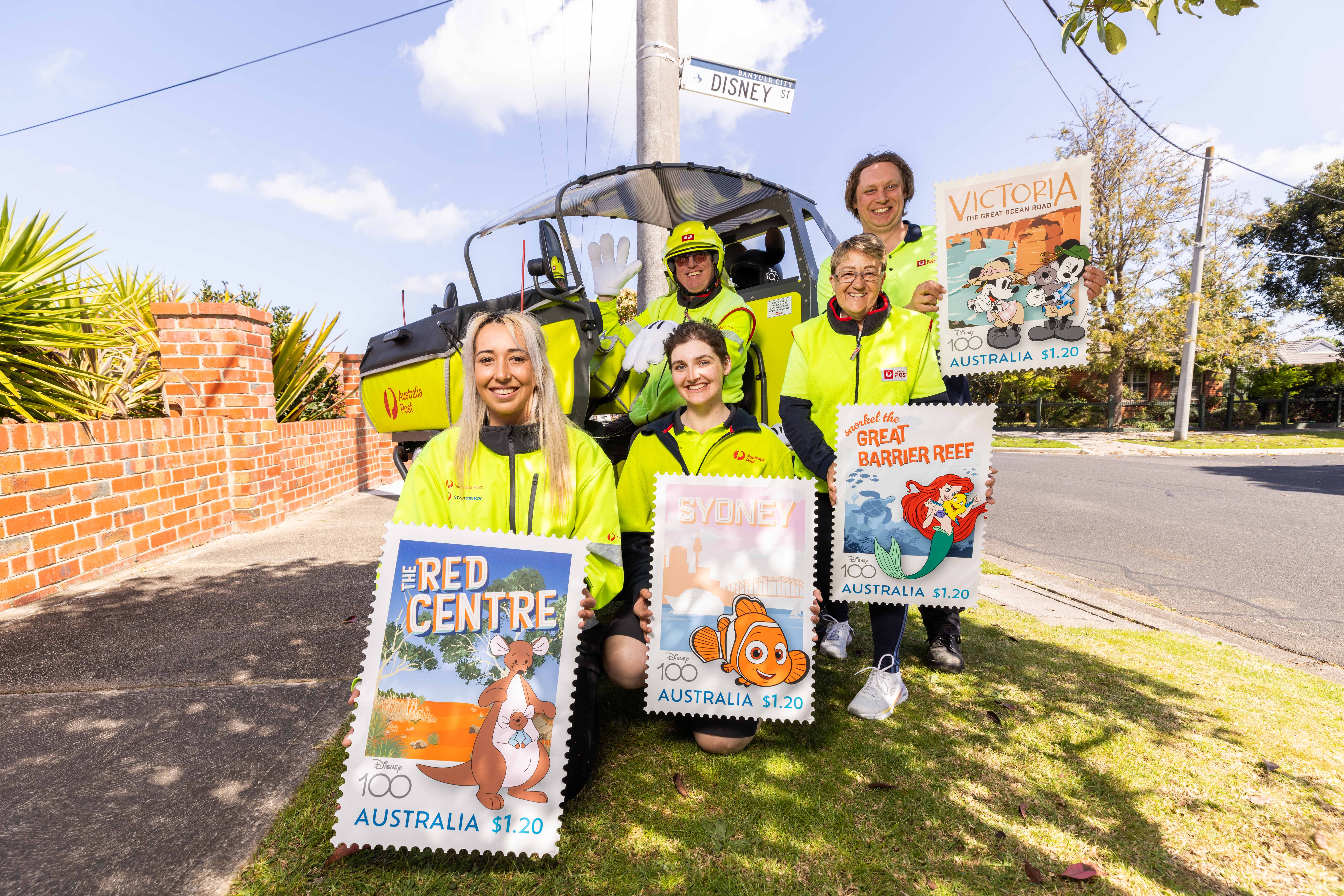
Write A Love Letter To The Land
Junior Landcare ambassador Costa Georgiadis is calling on kids to share what they love most about the environment – and the steps they’re taking to protect it.
To help celebrate Junior Landcare's 25 years of opening children’s hearts and hands to landcare, we are asking you to join in our letter writing campaign.
“The more you engage with nature, the more you appreciate it; and the more you appreciate it, the more likely you are to want to protect it,” shares Costa.
The campaign also features:
- * A curriculum-linked learning activity to help get you started
- * Special letter-writing templates for children of all ages
- * The chance to have your letters published in The Land
- * The chance to win a visit from Junior Landcare ambassador Costa himself (T&C's apply)!
Whether you write your letters as a class, school or youth group; individual, early learning centre or family – we want to hear from YOU!
Entries close October 20, 2023.
Visit: https://juniorlandcare.org.au/love-letters-to-the-land

Warning: High-Dose MDMA Tablet (Ecstasy) Circulating In NSW
 NSW Health is warning the public of a high-dose MDMA tablet (ecstasy), found to contain more than four times the average dose of other MDMA tablets in recent circulation. The tablet is pink-orange in colour and a square shape, with a ‘GUCCI’ logo and wording imprinted on it.
NSW Health is warning the public of a high-dose MDMA tablet (ecstasy), found to contain more than four times the average dose of other MDMA tablets in recent circulation. The tablet is pink-orange in colour and a square shape, with a ‘GUCCI’ logo and wording imprinted on it.Finalists In The NSW Health Awards 2023 Announced
- healthier, greener buildings and spaces
- sustainable management of energy, water, waste, and other resources
- a focus on value-based healthcare to reduce harms and risks for patients and the carbon costs of low-value care
- strengthening and developing low-carbon models of care
- use of technology to facilitate high quality, low carbon care
- establishing sustainable procurement processes
- educating and engaging staff about environmental sustainability.
- The goal is to reduce the carbon emissions from anaesthesia while delivering safe, high-quality healthcare.
- A multi-faceted program was implemented to reduce the perioperative carbon footprint. One area worked to reduce desflurane use in favour of alternative, less expensive anaesthetic gases or techniques. This program involved educating staff, practice changes, and audits. This initiative first launched at Royal North Shore Hospital and then was extended across the District. Two 'Net Zero Leads for Anaesthesia' were recently appointed to lead further work, including reducing N20 waste.
- The project has significantly reduced the use of desflurane. A year-on-year comparison saw desflurane use decrease from 35 bottles per month, to only 4 bottles in a year. A similar decrease was seen in CO2 equivalent emissions from a baseline of 1321 tonnes to 0.75 tonnes over the last financial year.
- In the last financial year, a direct cost saving of $344,087 and a global social cost saving of $105,048 was calculated. This adds to significant savings already made from previous years.
- drawing on existing and emerging research evidence to guide the delivery of safe and reliable care
- understanding how research translates into achieving improved outcomes that matter to our patients and the community
- assisting clinicians and health decision makers to find or use research effectively
- establishing research partnerships or collaborations involving clinicians, patients, research organisations, hubs, and networks, local health districts, pillar agencies, specialty networks and health organisations, that has led to outstanding examples of research that changed policy or practice
- acknowledgement by decision makers of the impact of research on their policy or practice
- eHealth, health information and data analytics to support and harness health and medical research and innovation.
- The 6997 patient SAFE Trial (Saline vs Albumin for Fluid Evaluation) was published in 2004. This trial determined that using albumin for fluid resuscitation did not improve mortality compared with the cheaper alternative of normal saline.
- The 7000 patient CHEST Study was published in 2012. This trial found that Hydroxyethyl Starch (HES) for fluid resuscitation didn’t improve mortality compared with the cheaper alternative, normal saline.
- The 5037 patient PLUS (Plasma-Lyte versus Saline) trial was published in 2022. This trial found that using a balanced multi-electrolyte solution for fluid resuscitation did not reduce risk of death or acute kidney injury compared with using saline.
- best practice, excellence, and innovation in mental health service delivery
- development of consumer-focused services
- positive mental health and wellbeing through consumer and carer participation
- strengthened prevention and early intervention
- community-based care practices, striking a better balance between care provided in hospitals, and that provided in the community
- integration between mental health and other providers including justice and human services.
- leading quality improvement to ensure safer patient care
- delivering innovative approaches to improving patient safety
- engaging patients in approaches to improve patient safety
- demonstrating leadership or role modelling behaviour that puts patient safety first.
- delivering safe, high-quality reliable care for patients in hospital and other settings.
- working collaboratively within the NSW Health system to improve health outcomes, including financial, IT, productivity, and workforce projects, initiatives or programs
- growing and supporting a skilled workforce by hiring and developing the right people, with the right skills, at the right time
- building positive work environments that bring out the best in everyone including wellbeing programs and initiatives
- strengthening diversity in our workforce and decision-making
- developing effective health professional managers and leaders
- improved systems and efficiencies to support better workplace safety and health outcomes and practices
- support for long-term behaviour change to strengthen the staff health safety culture
- increased awareness of the importance of personal safety alongside patient safety
- enhanced access and training in workplace health, wellbeing and safety.
- the sustainability of learning programs
- the amount of information unit managers needs to access from multiple sources and
- isolation from peers
- created a strong community and support network, harnessing the power and knowledge of the unit managers group
- motivated members to prioritise and engage in education to develop as a leaders
- improved leadership, particularly in communication, engaging and empowering teams
- significantly increased members accessing coaching and mentoring
- helped members feel recognised and valued by the District
- improved use of systems including rostering, performance appraisals and financial management
- increased time management and efficiency for unit managers. This is achieved by providing one central place to tie in all information, support and education required for their roles.
Changes To Minns Government Ministry
ACCC: Review Of Childcare Policy To Better Meet The Needs Of Families
AMA Supports Major Reforms To End Retail Vaping In Australia
Providers Selected For Central Coast Medicare Urgent Care Clinics
The disability royal commission recommendations could fix some of the worst living conditions – but that’s just the start
Di Winkler, La Trobe UniversityThe Royal Commission into Violence, Abuse, Neglect and Exploitation of People with Disability has shared its final report. In this series, we unpack what the commission’s 222 recommendations could mean for a more inclusive Australia.
The bite mark on Ashlee’s cheek, her broken teeth and other photos of injuries from assaults in disability housing are some of the haunting images emerging from the Royal Commission into Violence, Abuse, Neglect and Exploitation of People with Disability. It’s hard to fathom how someone could commit these brutal crimes, let alone how they were not stopped or reported by a registered National Disability Insurance Scheme (NDIS) provider.
After more than four years and many traumatic stories, the disability royal commission’s final report was released this morning. Included in its 6,845 pages are 222 recommendations.
The scope of the A$600 million disability royal commission included school, work, housing, hospitals and the criminal justice system.
The recommendations include the introduction of an Australian disability rights act, a new disability government portfolio, a minister for disability inclusion, and a department of disability equality and inclusion. There should be an independent national disability commission and major reforms to dismantle barriers to inclusive education, open employment, and accessible, appropriate and safe housing, the report says.
Rather than respond to specific recommendations, the government announced it would establish a taskforce for a staged response. But there is an urgent need to ensure NDIS participants with the highest level of support need – who are often the most vulnerable – have access to safe and adequate housing.
A Long Time Coming
The horrific treatment documented by the commission is not new. People with disability have long experienced violence, abuse and neglect at much higher rates than the rest of the community. Still, a decade after the introduction of the NDIS, the prevalence of assaults, abuse and neglect and the squalid living conditions in some disability housing remains shocking.
The commission heard that some 17,000 people with disability living in group homes are at significant risk.
Early this year a separate government report revealed thousands of incidents of serious injury, abuse and neglect of people with disability living in group homes including unlawful sexual conduct and death.
The Problem With Group Homes
All the commissioners agreed major improvements are needed when it comes to group homes. But they differed in their views about the future role of such settings.
There is little evidence to indicate group home are cost effective, provide quality support or deliver good outcomes for people living there.
The annual cost of NDIS-funded support within disability housing is $8.8 billion. There is also a significant cost that results from poor-quality support. The yearly cost of violence, abuse, neglect and exploitation of Australians with disability is estimated to be $46 billion.
Many group homes in Australia fail to keep people safe and deny their basic rights. The commission affirmed a commitment to make the Convention on the Rights of Persons with Disabilities a reality in Australian law.
The root cause of neglect and abuse is that many people with disability are segregated from the rest of society. Although commissioners were divided on the topic of segregation, they regarded the “inherent dignity, individual autonomy and independence of all people with disability as fundamental to Australia becoming a more inclusive society”.
Inclusive Housing Recommendations
The commission began its housing recommendations by acknowledging people with disability are “conspicuously absent” from national housing and homelessness policy frameworks.
The commission listed 11 recommendations for more inclusive housing. The recommendation (from four commissioners) to phase out group homes within the next 15 years is both pragmatic and feasible.
Both the human cost evidenced in the commission’s final report and the economic cost demand a transition to more contemporary housing.
The commission made some recommendations with the potential for more immediate improvement. These included addressing the practice of “third line forcing”, which means a single organisation can be both the landlord and the support provider in group homes. Stopping this will help prevent the “commodification” of some of the most vulnerable NDIS participants.
People who live in closed settings, who only engage with paid staff and other people with disability, are the most at risk of abuse and exploitation. Implementing the recommendations to make mainstream services more inclusive will help keep people living in disability housing safe.
Minimum Standards
The commission also recommended the introduction of minimum service standards, monitoring and oversight for boarding houses around Australia. If acted upon, these could fix some of the worst living conditions and extreme cases of exploitation, described as “human trafficking” with hundreds of people reportedly “missing” in the system.
The recommendations go on to highlight the urgent need to develop alternative housing options for people with disability. Rather than a standardised model of support, frameworks and principles need to be co-designed to increase the agency of people living in disability housing and develop bespoke models.
Real solutions start by working with people with disability. They need support to understand their rights, understand their housing and support options and exercise real choice about where they live and who they live with.
Only 6% of NDIS participants are eligible for disability specific housing called Specialist Disability Accommodation. So mainstream housing needs to be more inclusive and accessible.
Given the evidence about the impact of unsuitable housing on the lives of people with disability, the commission’s recommendation for national minimum accessibility standards in all new housing as soon as possible is critical too. The New South Wales and Western Australia governments have not yet committed to implement mandatory accessible design standards.
What’s Next?
Some of the most marginalised people in Australia were heard for the first time during the disability royal commission. Almost 10,000 people shared their stories via public hearings, submissions or private sessions. They represent thousands of others who were not heard. Many took risks to speak out. Over four years of tears and recounting trauma cannot be for nothing.
People with disability have given a lot to the commission and expectations are high for a comprehensive response and tangible action from the government. This needs to be balanced with adding layers of regulation that will do little to improve the lives of people with disability.
But the final report is momentous and the current NDIS review (due to report in October) will add to this momentum. There is scope to build on existing work and evidence to co-design, demonstrate and evaluate more contemporary models of housing and the way that support is provided within the home.
We all have a role to play in creating belonging, changing attitudes and recognising people’s shared humanity. Living free of violence, abuse, neglect and exploitation is not a big ask.![]()
Di Winkler, Adjunct Associate Professor, La Trobe University
This article is republished from The Conversation under a Creative Commons license. Read the original article.
Disability royal commissioners disagreed over phasing out ‘special schools’ – that leaves segregation on the table
Catherine Smith, The University of Melbourne and Helen Dickinson, UNSW SydneyThe Royal Commission into Violence, Abuse, Neglect and Exploitation of People with Disability has shared its final report. In this series, we unpack what the commission’s 222 recommendations could mean for a more inclusive Australia.
The Royal Commission into Violence, Abuse, Neglect and Exploitation of People with Disability delivered 222 recommendations on Friday after four and a half years of investigation and deliberation. In its 32 hearings and nearly 8,000 submissions, people with disability shared difficult stories of personal and systemic violence. The commission’s final report showed Australians of all ages with disability continue to experience injustice that must be addressed.
As signatories to the Convention for the Rights of People with Disability and the Convention of the Rights of the Child, the commission concluded children and young people have a right to inclusive education.
But the commissioners passed down divided recommendations that will continue education segregation for Australia’s young people for at least a generation and possibly longer.
Split On Segregation
Many disability advocacy organisations hoped the commission report would call for an end to segregation of people with disability across education, housing and employment. Yet the final report found the commissioners split on this issue.
Commissioners Barbara Bennett, Rhonda Galbally and Alastair McEwin believe “the deliberate and systematic separation of people based on disability constitutes segregation”. The remaining commissioners disagreed.
Two contrasting sets of education recommendations emerged from this split.
One seeks to phase out “special” or segregated education by 2051. Commissioners Galbally and McEwin – who are the only disabled commissioners and have close relationships with the disability community – support this approach, along with Bennett.
This proposal has still come under fire. West Australian senator Jordon Steele-John argues a 30-year phase out process is too long. He says it would mean disabled children entering school today would likely be separated from their age peers for the duration of their school life.
Organisations such as the Australian Coalition for Inclusive Education have previously set out roadmaps to end segregated education within a decade.
The alternative recommendation proposed by commissioners Andrea Mason and John Ryan seeks to maintain special schools but, where practicable, locate these close to mainstream schools. This could create partnerships so students can participate in activities together. Critics of this approach say it does not suggest a time when segregated schooling might cease.
And bringing mainstream and special schools together would not necessarily achieve inclusion. The suggestion of scheduling in partial participation could send a message to students and teachers that not everyone belongs in all learning spaces.
The recommendations did not mention the private education sector, referring only to a future possibility of inclusion within state schooling.
Why Inclusive Education Is Important
Education is not just about academic outcomes and future employment. It is about creating tomorrow’s Australian communities, society and citizens.
The disability royal commission’s recommendations represent progress in terms of understanding diversity, listening to the voices of young people, capacity building, leadership and governance, and employment opportunities. But they lack insight into the importance of inclusive education in achieving all of these goals.
The very establishment of the commission was a commitment to addressing the violence and discrimination people with disability experience. But the lack of a firm commitment to a fully inclusive education system denies the opportunity for all young people to grow and understand their diversity of experiences.
All children and young people in a community need to play, grow and develop together. This means they can learn how to develop social-emotional skills and empathy for each other’s strengths and differences.
Why Some See Segregated Education As Necessary
Not everyone within the disability community sees segregated education as problematic. There are a number of reasons why special settings for students with disability have been established and chosen by families and students.
Schools are under-resourced and teachers in mainstream settings are often under-trained for working with students with disability in inclusive ways.
Many schools lack the facilities and adjustments required to keep some students with disability safe and included alongside their peers. There are concerns about bullying and meeting personal needs in some cases. Staff in specialist education settings may be more experienced with these needs.
The royal commission recommendation that teaching standards should include inclusive education training across the careers of teachers is important. But teachers cannot achieve this without the time or resources to develop the meaningful meetings and planning of Individual Education Plans (IEP) with students, carers and other professionals, including classroom assistants.
Much of the expertise in meeting the needs of students with disability are located in specialist schools, with little opportunity for skill and strategy sharing with mainstream teachers. Continuing to segregate these skills will make inclusive education unachievable.
Where To Next?
The commission’s final report identifies the need for better data collection and analysis to make decisions. Existing mechanisms including the Disability Standards for Education, the Australian Curriculum, the Nationally Consistent Collection of Data on School Students with Disability, and an additional monitoring of progress through IEP reporting will be an important step in identifying where additional supports may be required at the school and student level.
Many within the disability community will not be heartened by the disability royal commission’s recommendations because they leave an option for segregation on the table. And this may set up the next generation of disabled children and young people for a life of being excluded from mainstream society. ![]()
Catherine Smith, Senior lecturer, The University of Melbourne and Helen Dickinson, Professor, Public Service Research, UNSW Sydney
This article is republished from The Conversation under a Creative Commons license. Read the original article.
The disability royal commission heard horrific stories of harm – now we must move towards repair
Jack Francis Kelly, University of Technology Sydney; Linda Steele, University of Technology Sydney, and Phillippa Carnemolla, University of Technology SydneyThe Royal Commission into Violence, Abuse, Neglect and Exploitation of People with Disability has shared its final report. In this series, we unpack what the commission’s 222 recommendations could mean for a more inclusive Australia.
The final report of the Royal Commission into Violence, Abuse, Neglect and Exploitation of People with Disability follows years of advocacy from the disability community. It gave voice to people with disability to tell their stories of violence, so policymakers and broader community would listen and take action. Segregation emerged as a key driver of violence.
The report makes 222 recommendations to improve laws, policies and practices for a more just and inclusive society. They include a new disability rights act, including access to remedies when people experience human rights breaches.
The final report recommends disability service providers offer redress to people with disability who experience harm while receiving their services. This could include “apologies, compensation, reimbursement of fees, credits for services and other practical remedies or supports”.
However, there are no recommendations that governments should also offer apologies or redress. In addition, a call for governments and disability services to look back and repair the harm caused by century-long policies of segregation and institutionalisation is missing from the final report.
What Do ‘Institutionalisation’ And ‘Segregation’ Mean?
Institutionalisation involves grouping people with disability together – such as in residential, educational or work settings – and segregating them (keeping them separate) from people without disability.
All people with disability have the human right to live independently in the community regardless of how high their support needs are. This means providing access to services and support so people with disability can exercise choice and control over their lives and make all decisions concerning their lives.
In 20th century Australia, people with disability were institutionalised in many large residential settings. They were subjected to
- physical and sexual violence
- medical neglect
- use of restrictive practices (such as sedation, locking people in a room or restraining them in a bed or chair)
- sterilisation (such as women having their tubes tied)
- and unpaid work.
Eventually, Australian government policies prompted the gradual closure of many large residential settings.
Shutting down institutions has not put an end to injustices. Follow-up processes have not been established to recognise and redress the experiences of people who lived there.
This institutional history intersects with Australia’s violence towards First Nations people with disability and with broader practices of eugenics (discriminatory “planned breeding”).
People with disability remain traumatised by their experiences, yet governments and charities have not been called to account.
Problems Today
Today, many people – especially those with intellectual disability – live in group homes where segregation, social isolation, violence and lack of choice in their daily lives are a common reality.
Harms such as sterilisation, restrictive practices and below-minimum wages continue.
The disability royal commission heard how group homes replicate the harm of large residential settings, with operators failing to prevent violence and avoiding accountability.
People with disability have called for an end to segregation in housing and other aspects of their lives.
Recognising Wrongs
Reparations are actions to recognise and respond to systemic wrongs. They might involve compensation, restitution (such as returning money or property) or rehabilitation (health or legal services). Reparations can seek satisfaction (with apologies and memorials) and guarantees something won’t happen again via law reform or human rights education.
In Australia, we’ve seen compensation, rehabilitation and apologies for institutional child sexual abuse.
We have also seen reparations and an apology for members of the Stolen Generations.
People with disability are entitled to reparations as a human right, including for institutionalisation.
There are overseas examples of reparations for people with disability, including compensation for sterilisation, apologies for disability institutionalisation, public education and truth-telling.
What Do People With Disability Want?
Co-author Jack Kelly describes the ongoing effects of institutionalisation:
People with disability were not seen as part of local communities when they lived in institutions. This has to change and still takes time. I think it is really important that we address the history of what has been going on and say; ‘Sorry that we didn’t look after your loved ones’ and ‘Sorry we didn’t value you as a person’. It is time to work with people with disability towards a national apology from the government.
Jack’s statement resonates with broader calls by the disability community for reparations.
In 2021, the Council for Intellectual Disability demanded withdrawal of an application for tourist re-zoning of Peat Island (the site of a disability institution for 99 years) and for memorialisation and truth-telling.
There have been recent calls for apology and truth-telling in the mental health system and reparations for sterilisation.
Our research explored what people with intellectual disability want the public to know about large residential settings.
We found people with intellectual disability support the wider community learning more of what was experienced in these places. Sharing this history is an important step towards repairing past wrongs, ending institutionalisation, segregation and exclusion, and realising equality and inclusion.
A Way Forward
People with disability, including those with intellectual disability, must lead reparation design and development.
The disability royal commission has highlighted systemic violence, abuse, neglect and exploitation in today’s Australia. These criminal practices reinforce a century-long history of injustice from institutionalisation.
Now is the time to act to ensure this does not continue. Reparations are one way to do this.![]()
Jack Francis Kelly, Honorary Research Fellow, School of the Built Environment, University of Technology Sydney; Linda Steele, Associate Professor, Faculty of Law, University of Technology Sydney, and Phillippa Carnemolla, Associate Professor, School of the Built Environment, University of Technology Sydney
This article is republished from The Conversation under a Creative Commons license. Read the original article.
Here’s why we need a disability rights act – not just a disability discrimination one
David Roy, University of NewcastleThe Royal Commission into Violence, Abuse, Neglect and Exploitation of People with Disability has shared its final report. In this series, we unpack what the commission’s 222 recommendations could mean for a more inclusive Australia.
There were more than 200 recommendations for federal and state governments to consider within the Royal Commission into Violence, Abuse, Neglect and Exploitation of People with Disability’s final report, released on Friday.
A great deal of focus has been on housing, employment and education. However, the very first recommendation is for a new disability rights act. This recommendation, if adopted, may have the greatest impact of all.
Here’s why it’s needed.
Conventions, Rights And Australian Law
Australia is a signatory to the seven core International Human Rights treaties and has ratified them all (meaning we’ve voluntarily accepted legal obligations under international law). Once it ratifies a treaty, Australia is obliged to ensure its domestic laws comply with it.
The seven treaties include the Convention on the Rights of Persons with Disability, signed in 2007. In addition, we have the 1992 Disability Discrimination Act and we are a signatory to the Salamanca Statement on the right of every child to education.
However there has been ongoing criticism of Australia for not fully abiding by the international treaties we have signed.
The Difference Between Discrimination And Rights
The Disability Discrimination Act is a reactive law. It comes into force when discrimination is already allegedly happening. The problem with this form of “formal equity” is it can reinforce inequity, even as it seeks to address it. It’s focus is not achieving equal outcomes or opportunities.
In its final report, the disability royal commission affirmed a commitment to make the Convention on the Rights of Persons with Disabilities a reality in Australian law.
A disability rights act would enshrine in law the ability to make proactive, positive actions to ensure inclusion, support and long term structural changes. A rights act would additionally support First Nation peoples with disability giving them additional protection that is culturally sensitive, as stated in the Royal Commission Report.
Reasonable Adjustment Versus Undue Burden
One major challenge to breaking down barriers to inclusion and equity is the phrase “reasonable accommodation”, which is outlined in the Convention on the Rights of Persons with Disabilities as:
necessary and appropriate modification and adjustments not imposing a disproportionate or undue burden […] to ensure to persons with disabilities the enjoyment or exercise on an equal basis with others of all human rights and fundamental freedoms […]
These are often termed “reasonable adjustments”.
But are the changes to ensure inclusion “reasonable”? How can we tell?
This interpretation has been criticised because reasonable adjustment is intended to mean what is reasonable for the person faced with the barrier. But it’s usually interpreted as meaning what’s reasonable for the provider – say, a school, employer, accommodation or service organisation.
A new disability rights act would change the burden of proof. If a business, school system or care provide did not offer inclusive supports and adjustment, they would need to prove it was an undue burden on them. The commission said:
As presently drafted, the [Disability Discrimination Act] creates little incentive for employers, schools, service providers and other duty-holders to take active measures to prevent disability discrimination.
Commissioners said one of the main deficiencies of the disability discrimination act is that:
the protection of a person’s rights depends on that person being prepared to make and pursue a complaint […] to have the knowledge and personal resources to pursue the claim, including the risk of an adverse costs order should the matter reach court.
Why A Disability Rights Act Is Important
Under current policies and practices, people with a disability are not sufficiently involved with decision making and the development of laws and policies. This is contrary to the Convention on the Rights of Persons with Disabilities.
A disability rights act would enshrine the requirement for people with a disability to be at the centre of any changes being made.
There also needs to be agreement across all sectors as to what constitutes disability for a rights act to be implemented. There are still today, those that question the diagnosis of attention deficit hyperactivity disorder (ADHD) and systems that conflate indicators between disabilites. If there isn’t a consistent definition, people and organisations can ignore or redefine disability based on their opinion, not community consensus or law.
A disability rights act would create a societal climate of positive action, to remove barriers before complaint, and for all aspects of society to promote meaningful equality and actively eliminate discrimination.
In the true spirit of inclusion, it could change societal attitudes and put supporting people with a disability at the core of all processes, rather than an afterthought – whether in the employment, education, housing, sport or legal sectors. It would break the vicious circle of disadvantage and exclusion.
A Flow-On Effect To All The Recommendations
In their final education recommendations, a key division emerged among the commissioners. Indeed this split also exists within the education sector.
Three of the commissioners said all children with a disability should be taught in mainstream settings and segregated settings should be closed. In this way, the streaming of exclusion that often leads to a lifetime of isolation from wider society could be disrupted.
A disability rights act would ensure segregated settings and potential educational deficiencies (whether in specialist or mainstream schools) would be challenged by a social model of disability rather than an archaic medical model, which focuses on specific diagnoses. It would empower us to break from the current failing systems and change the lens through which we see each other.
Creating a disability rights act would mean that if mainstream schools are not suitable for many children with a disability, then we would change the schools and the systems – not remove “certain” children.![]()
David Roy, Lecturer in Education, University of Newcastle
This article is republished from The Conversation under a Creative Commons license. Read the original article.
Disclaimer: These articles are not intended to provide medical advice, diagnosis or treatment. Views expressed here do not necessarily reflect those of Pittwater Online News or its staff.